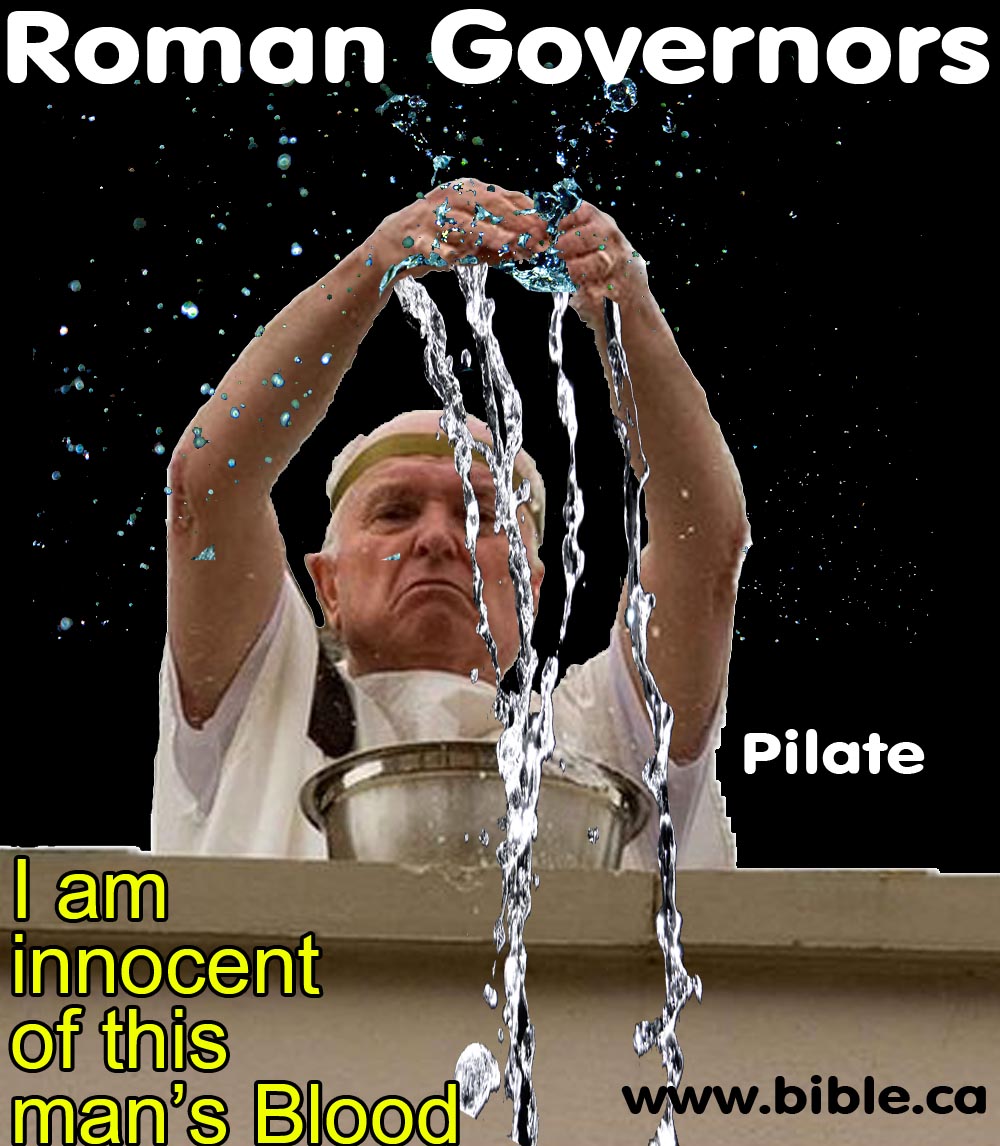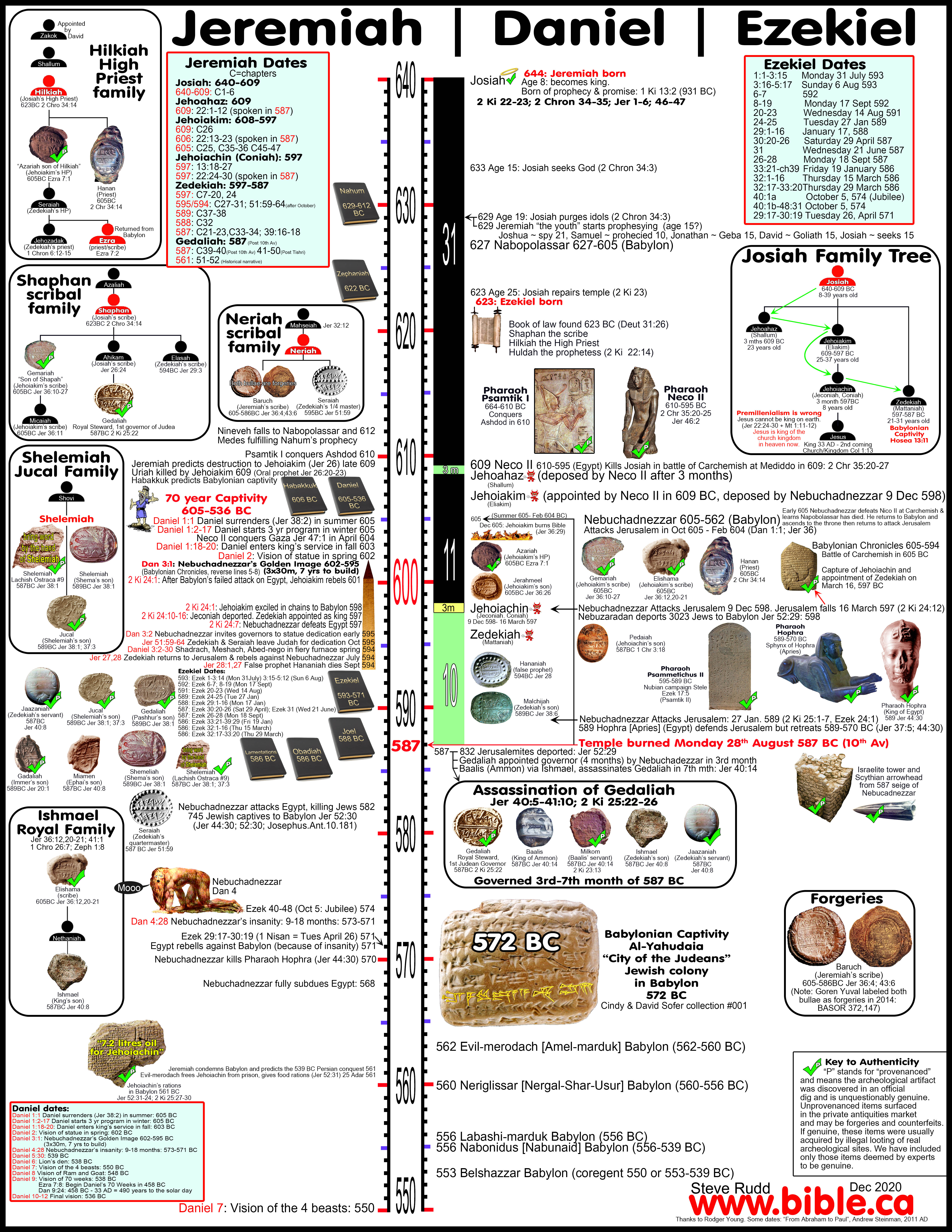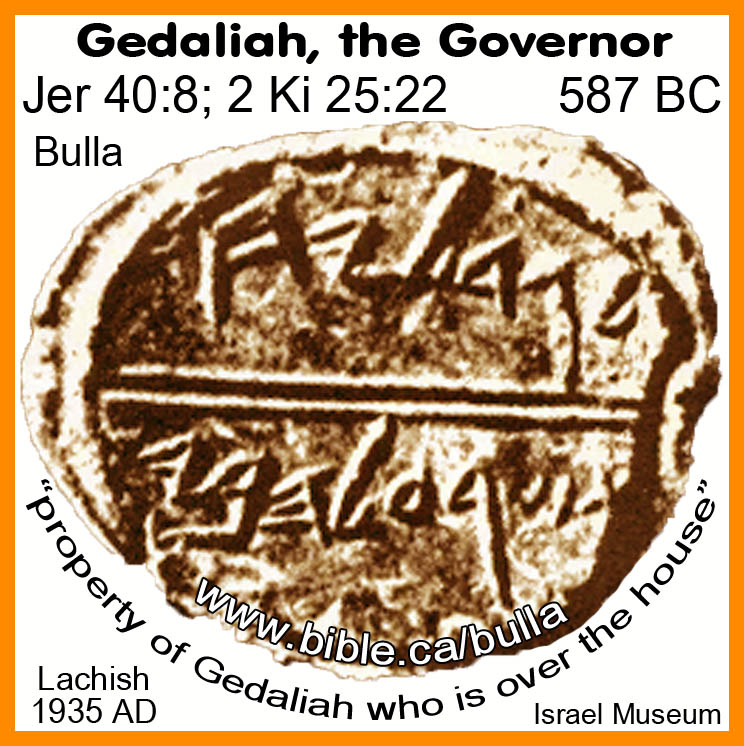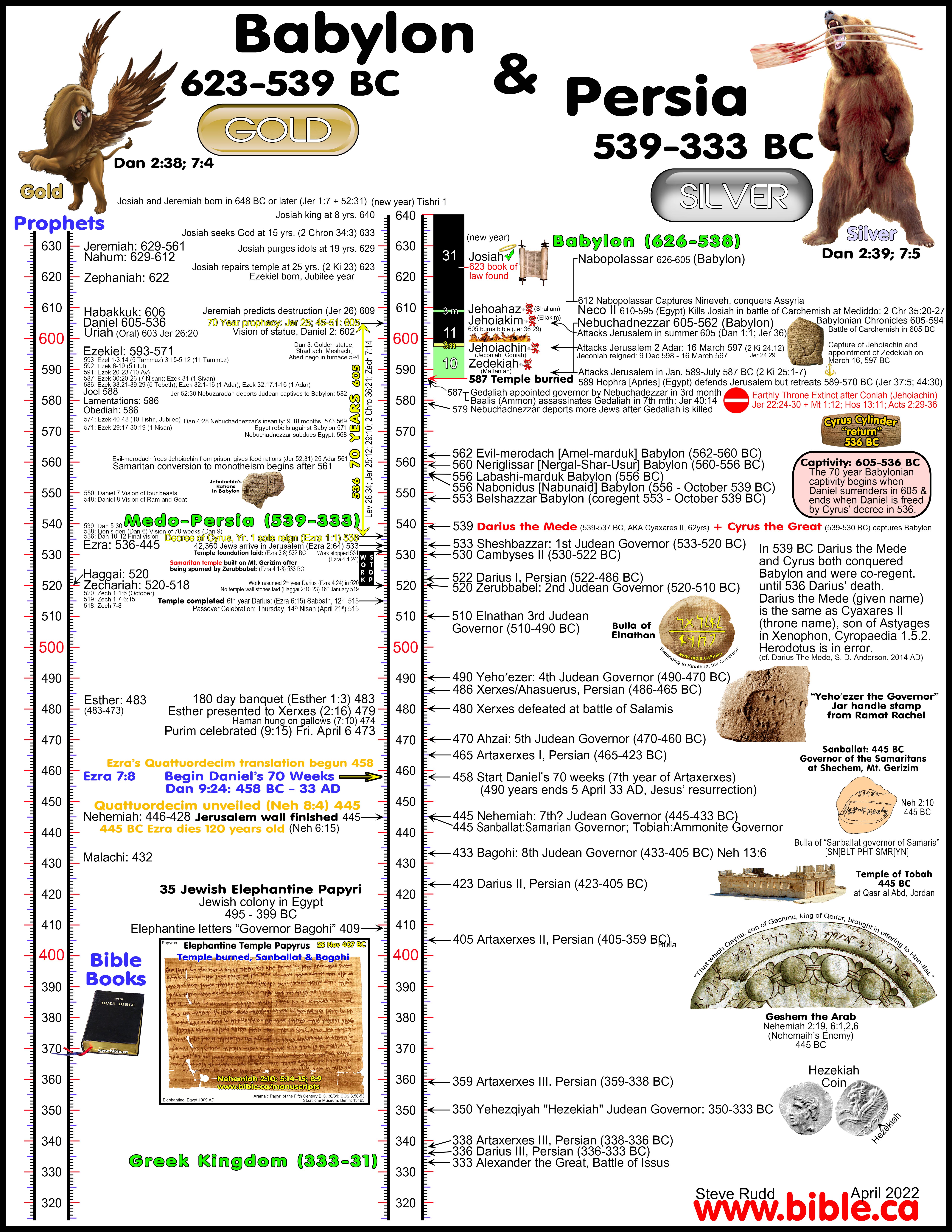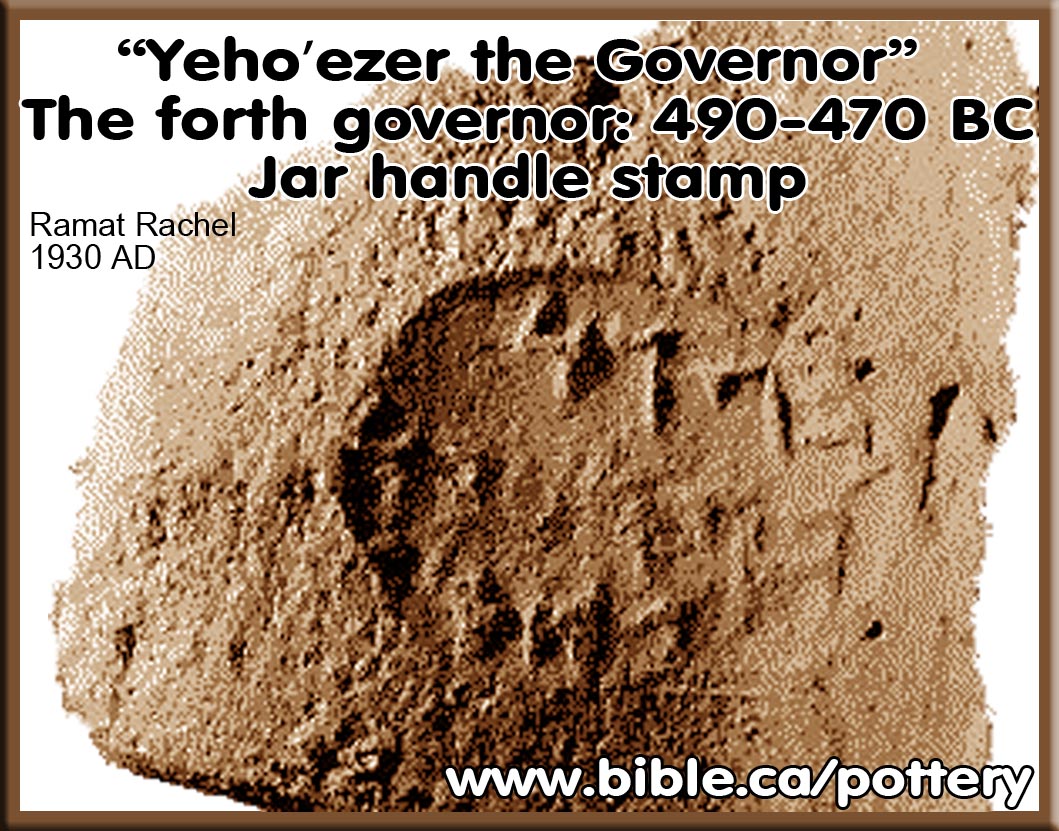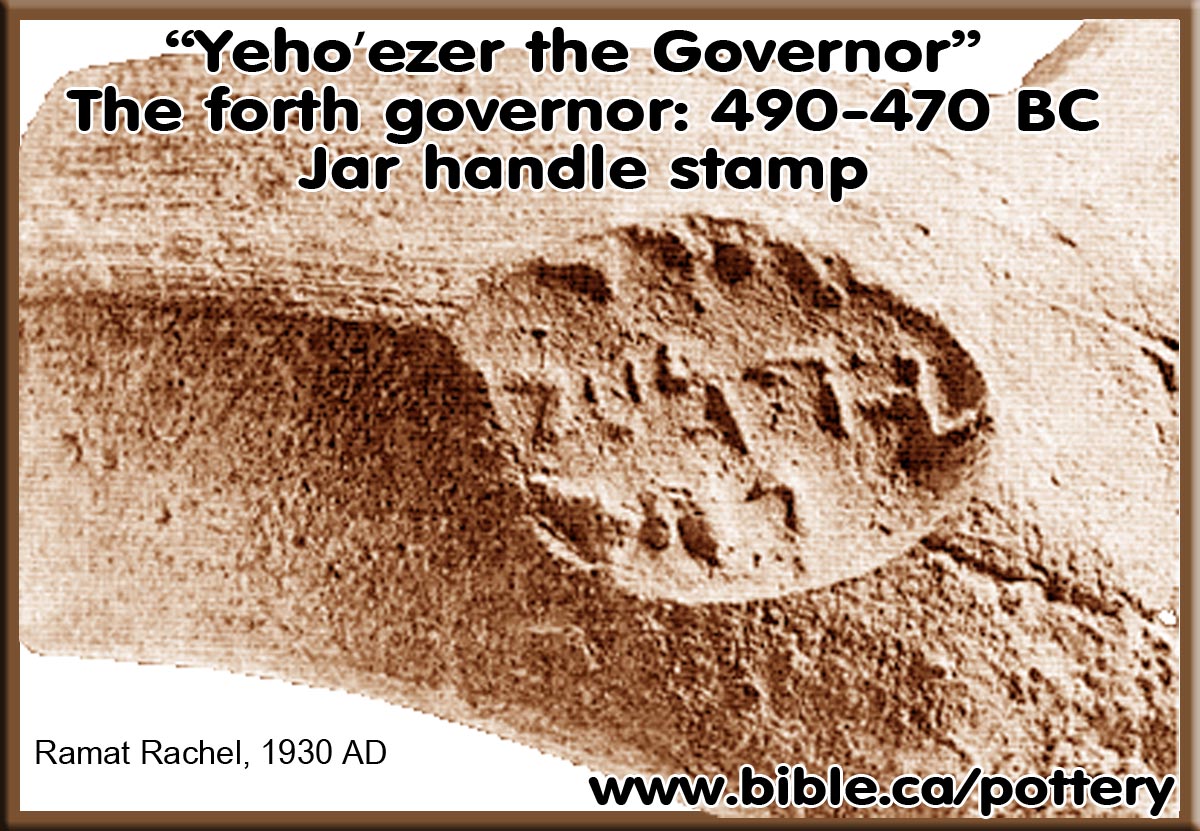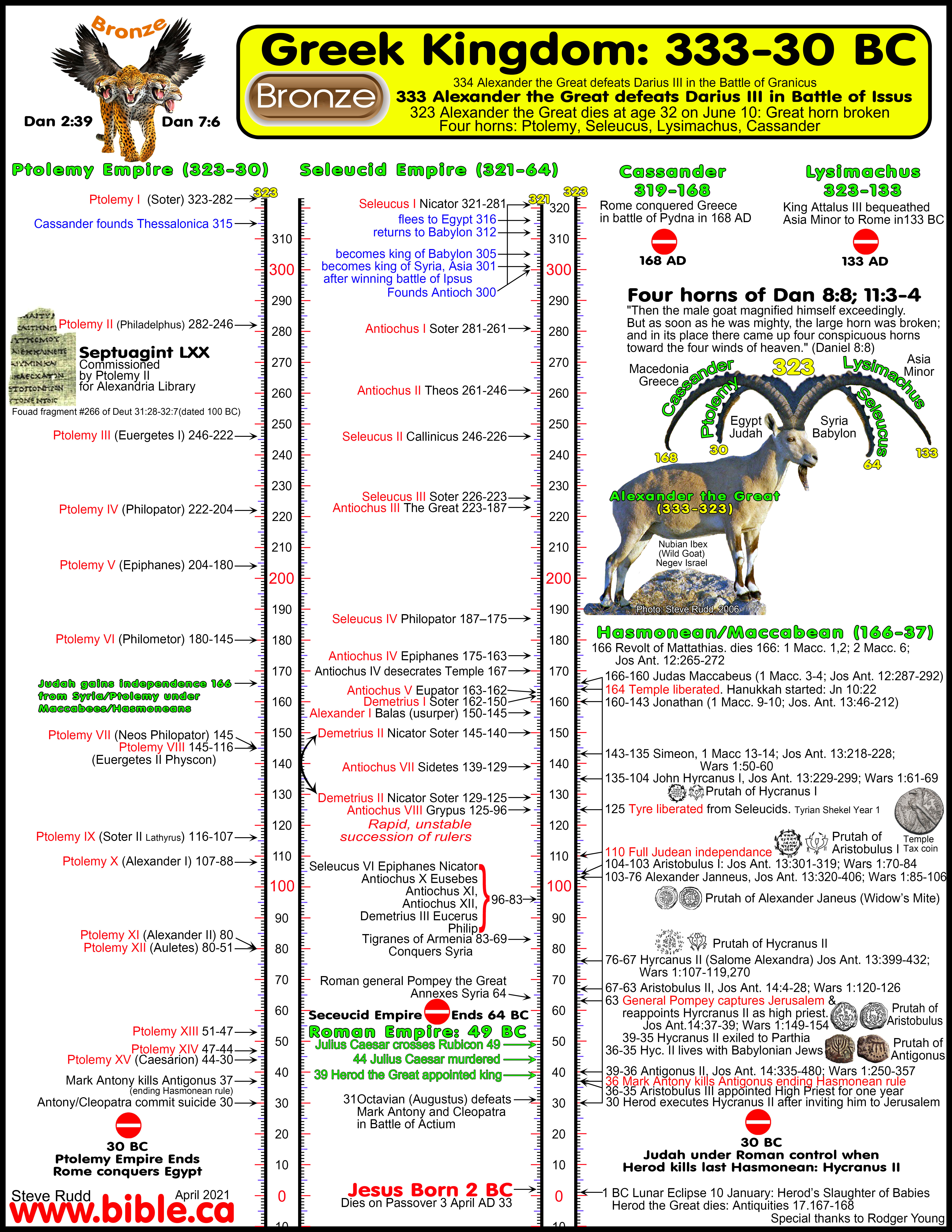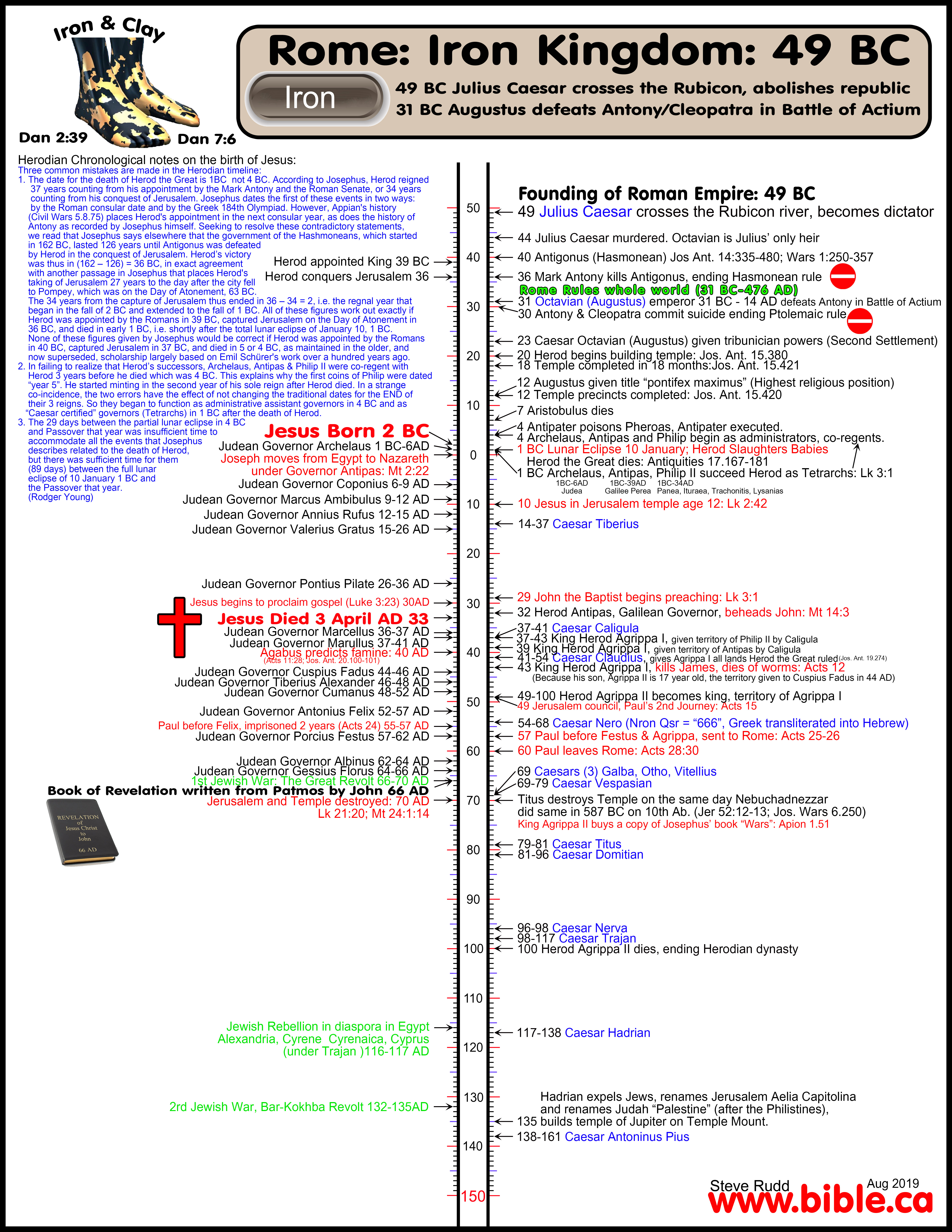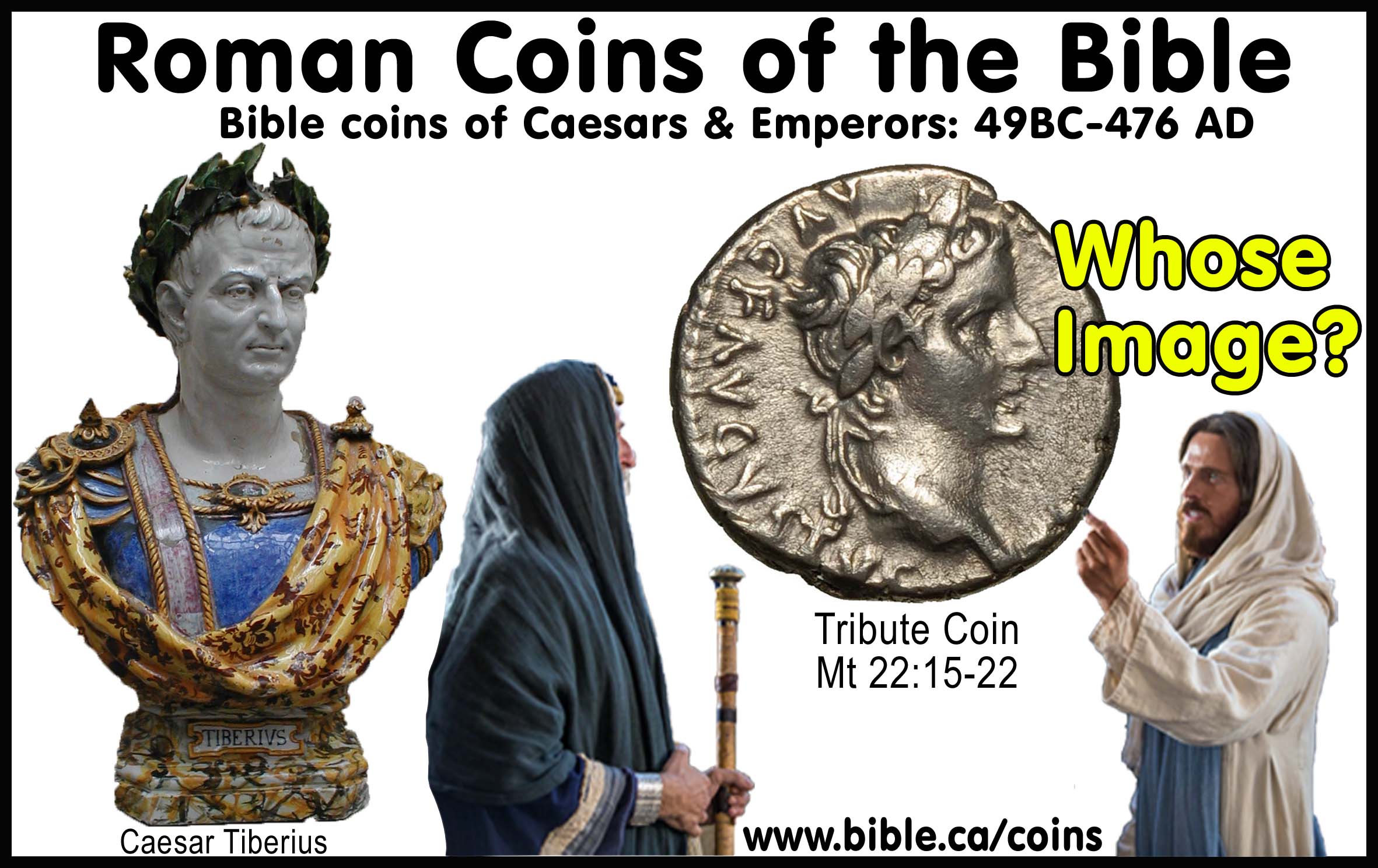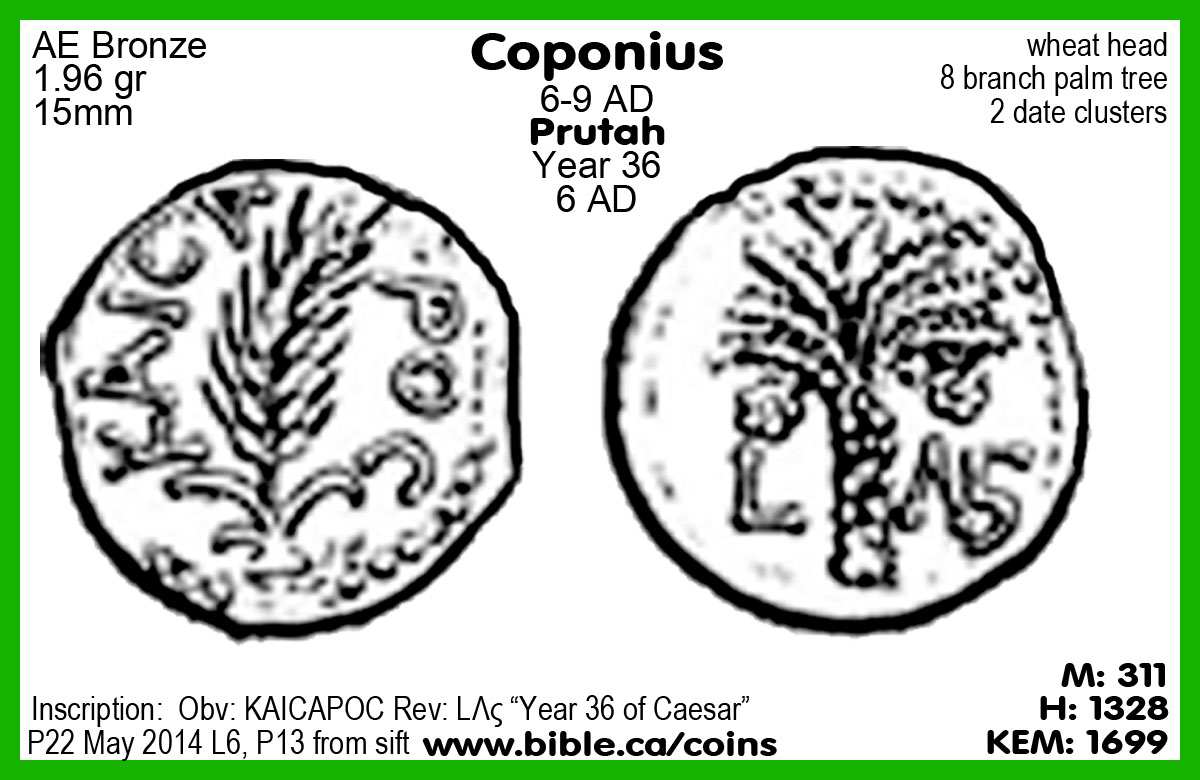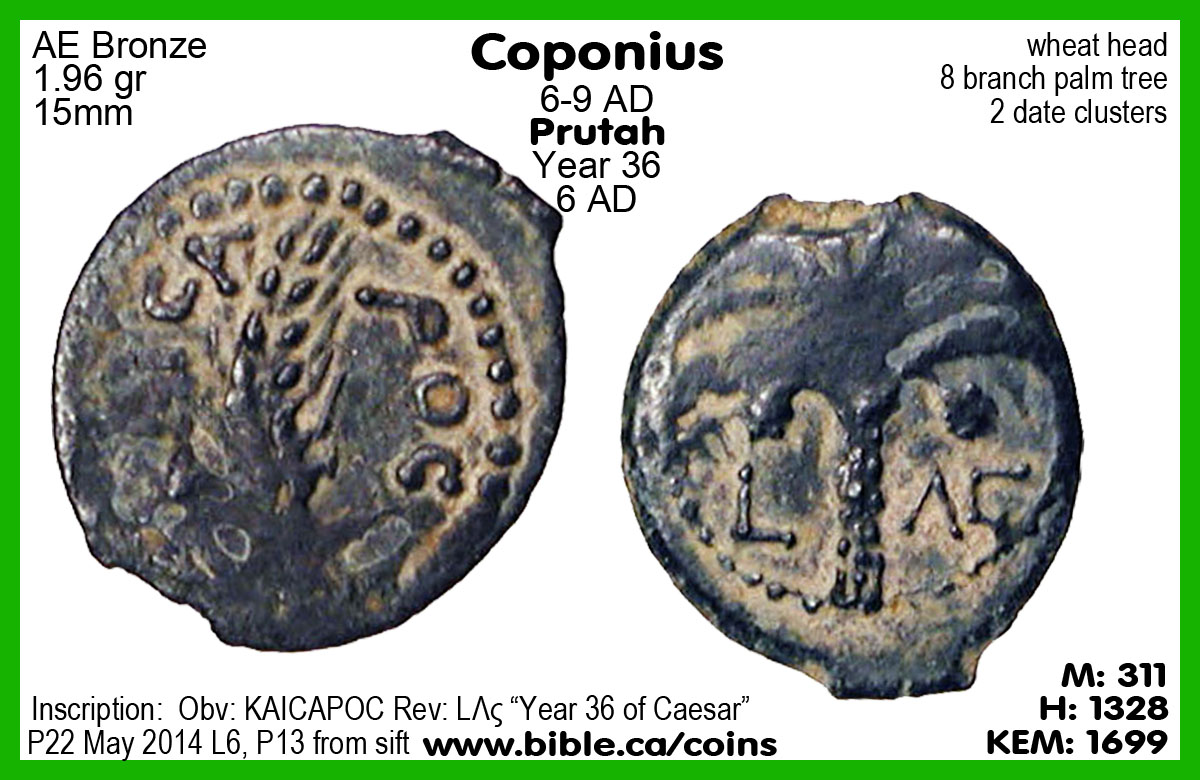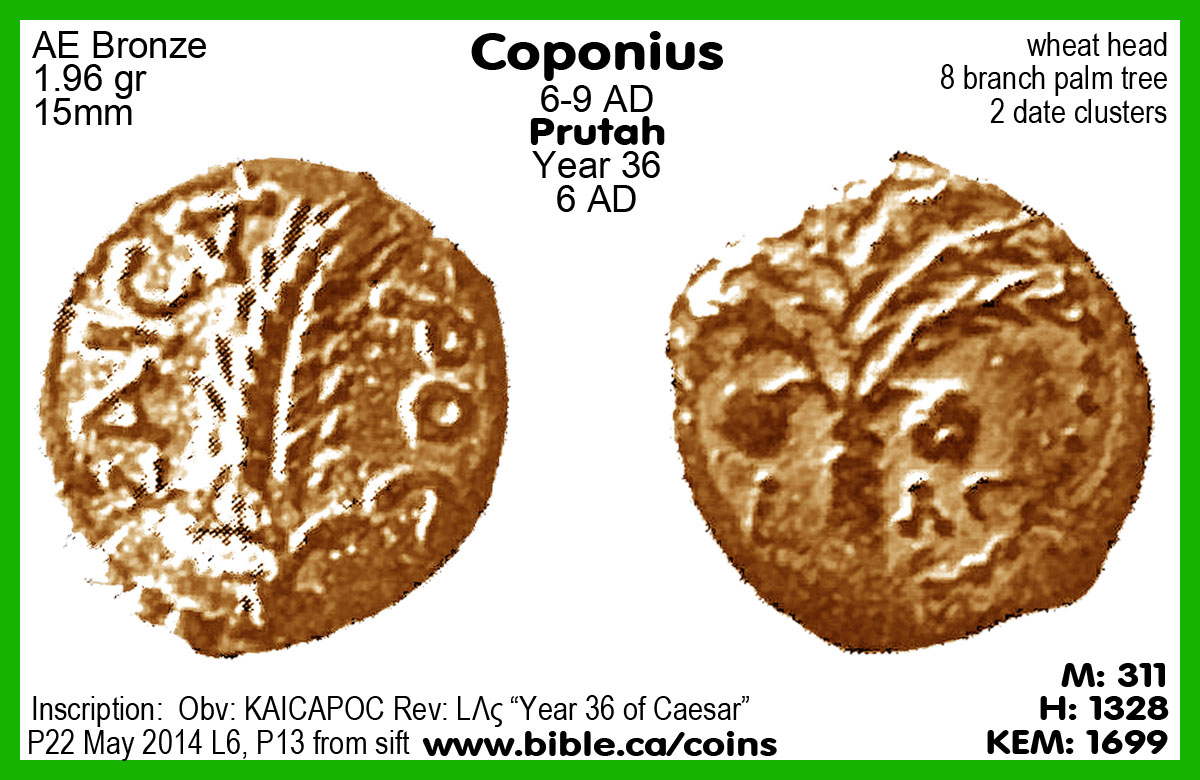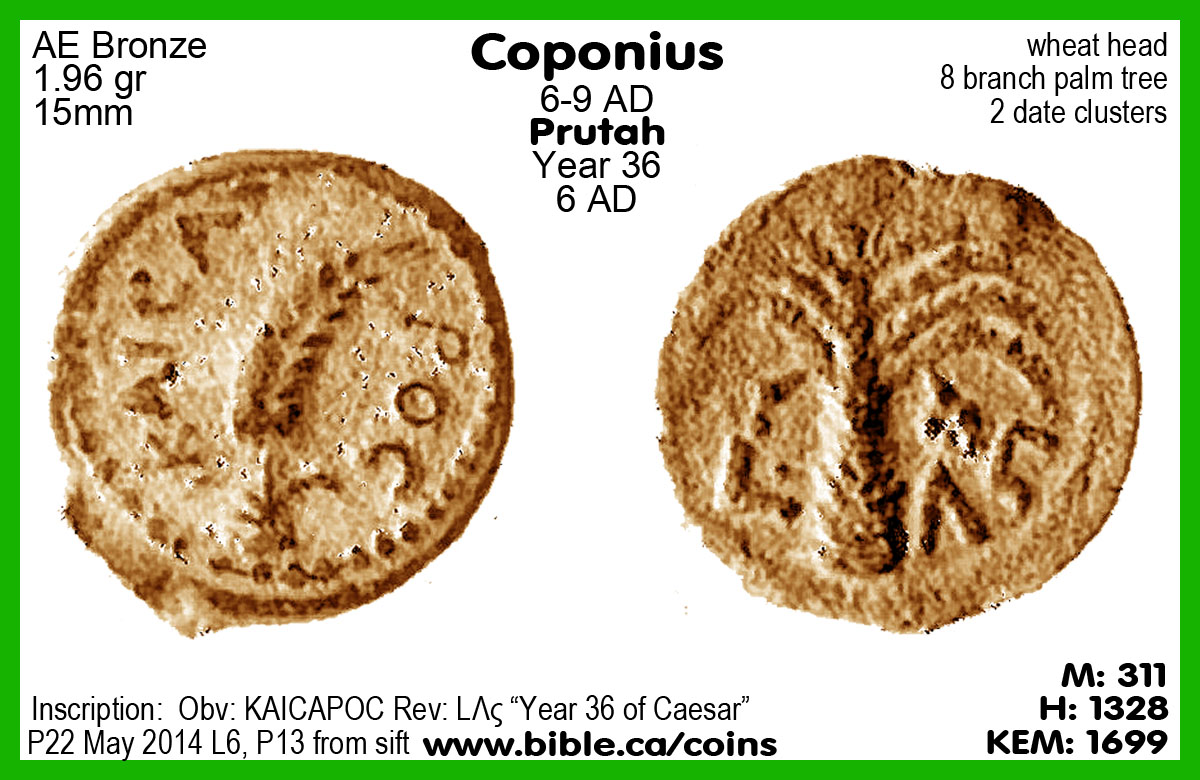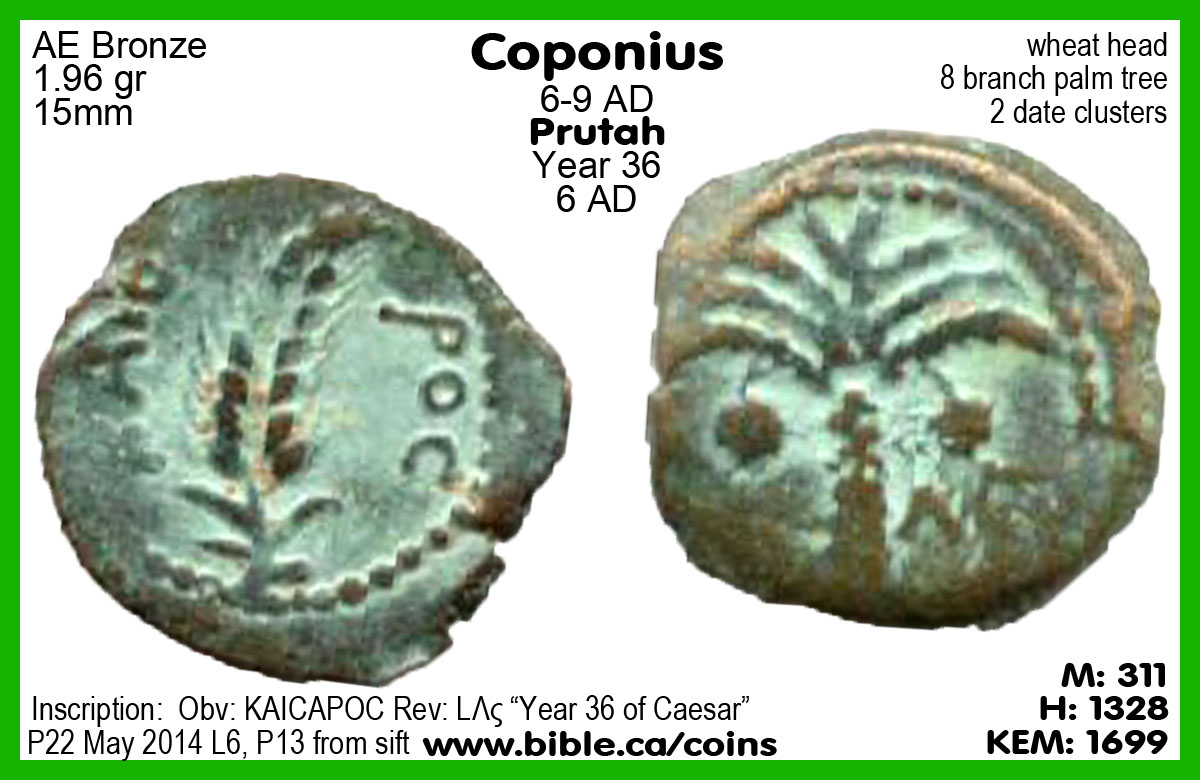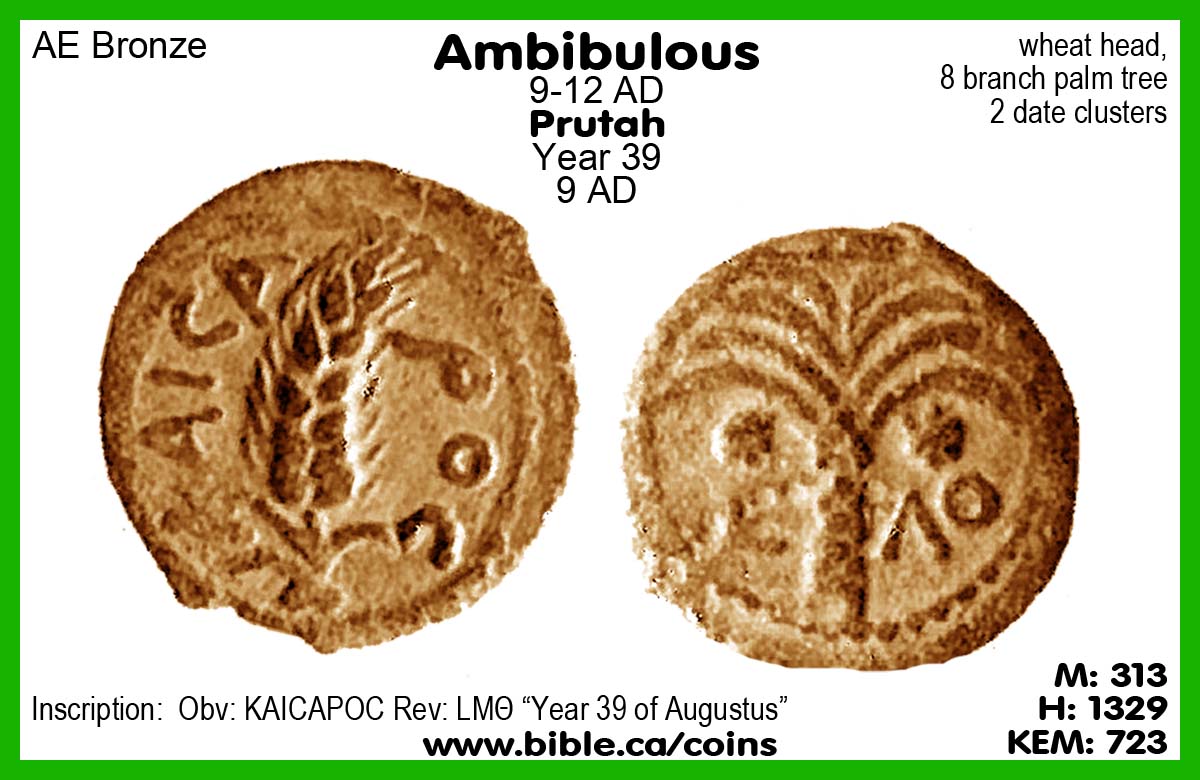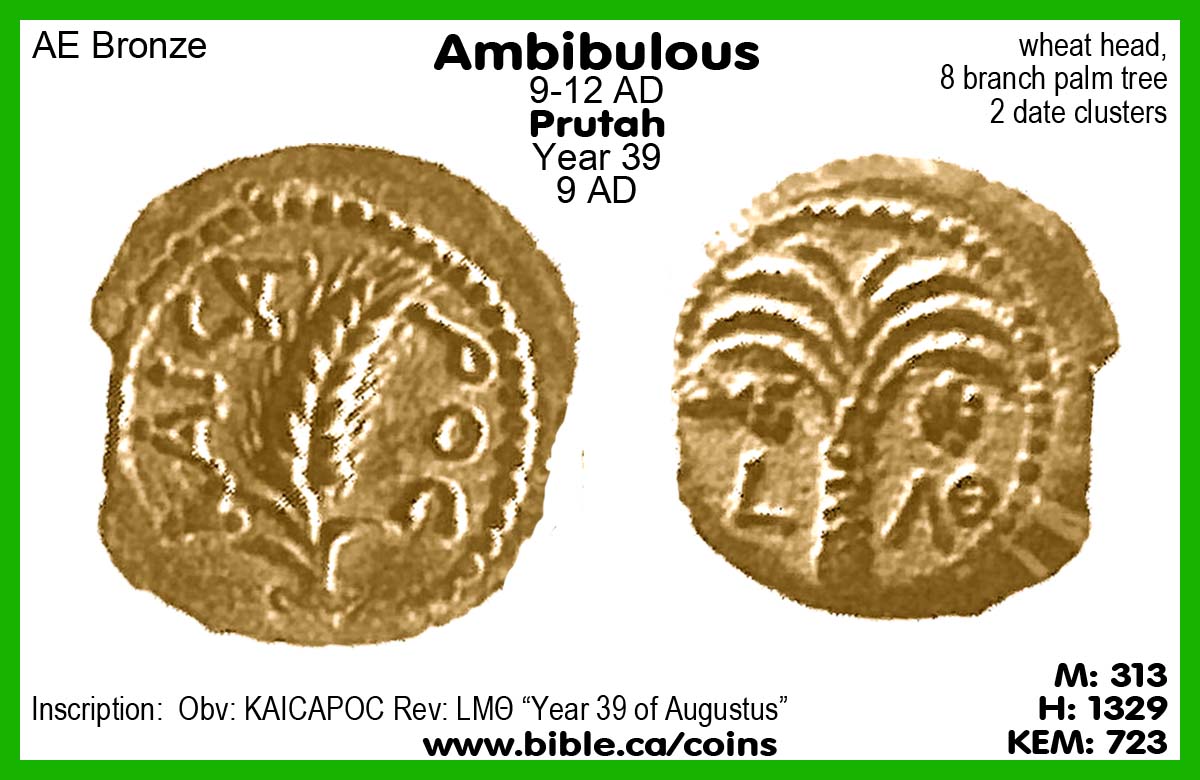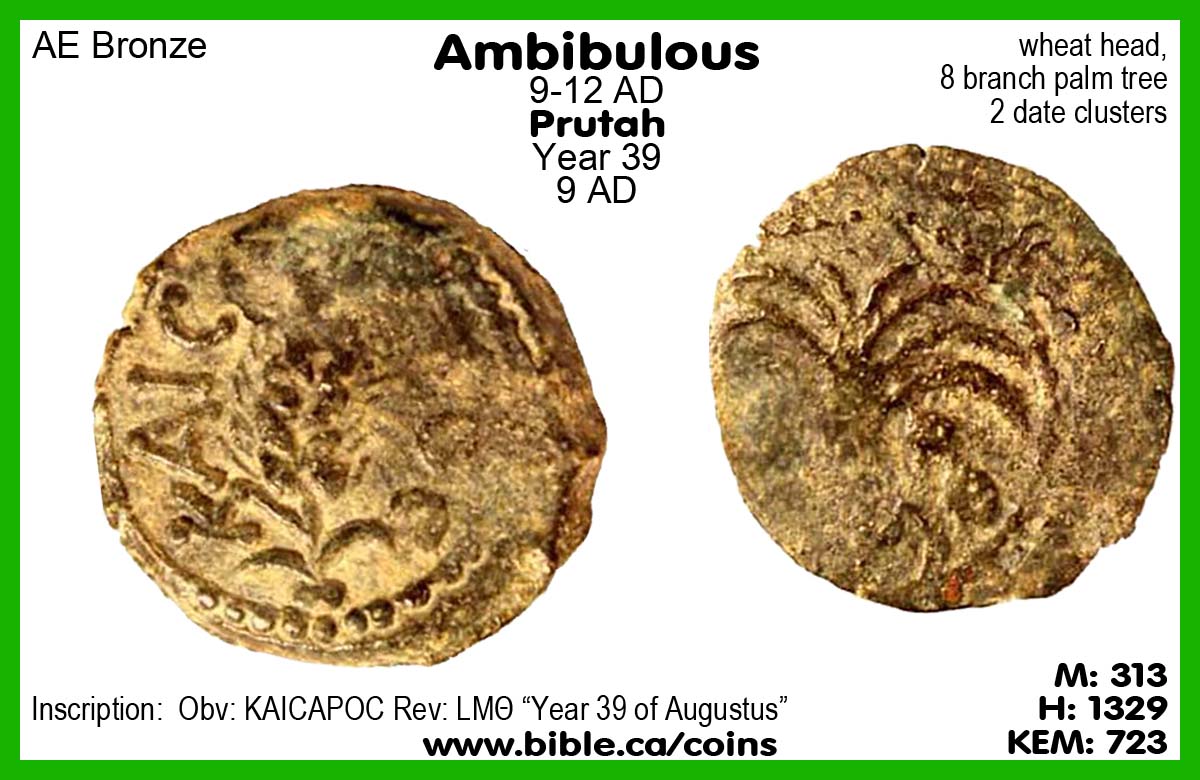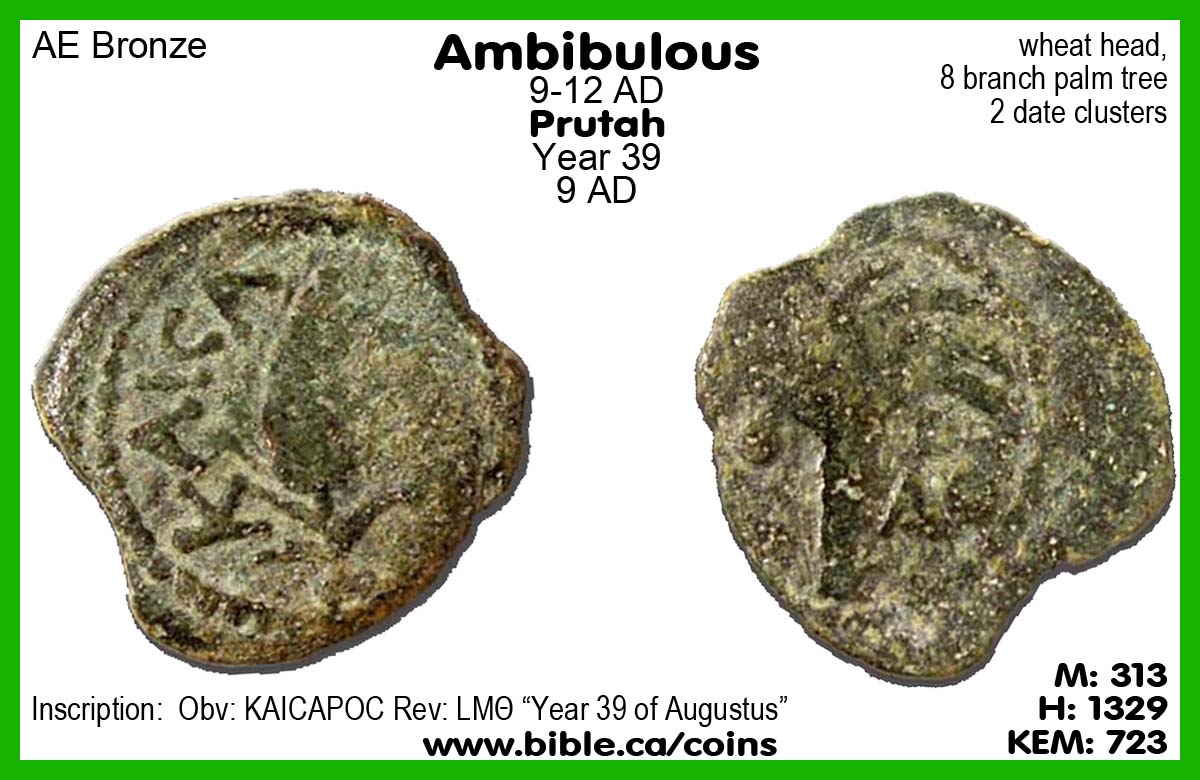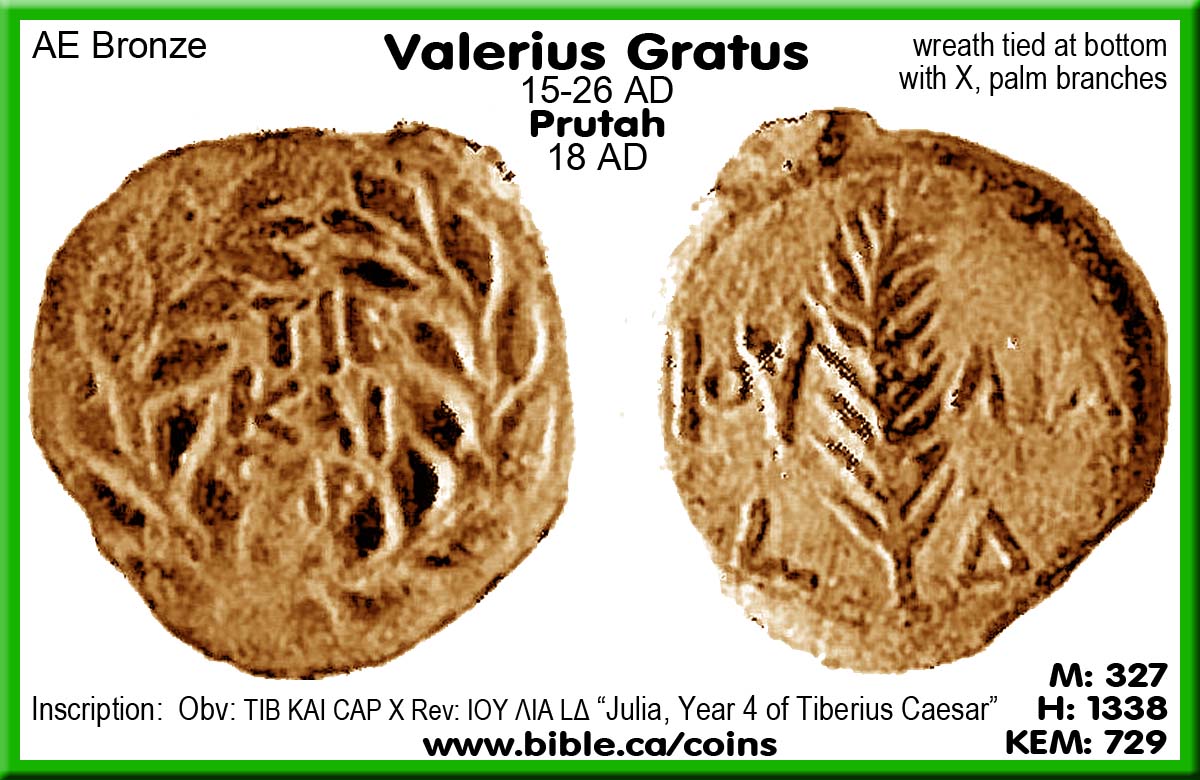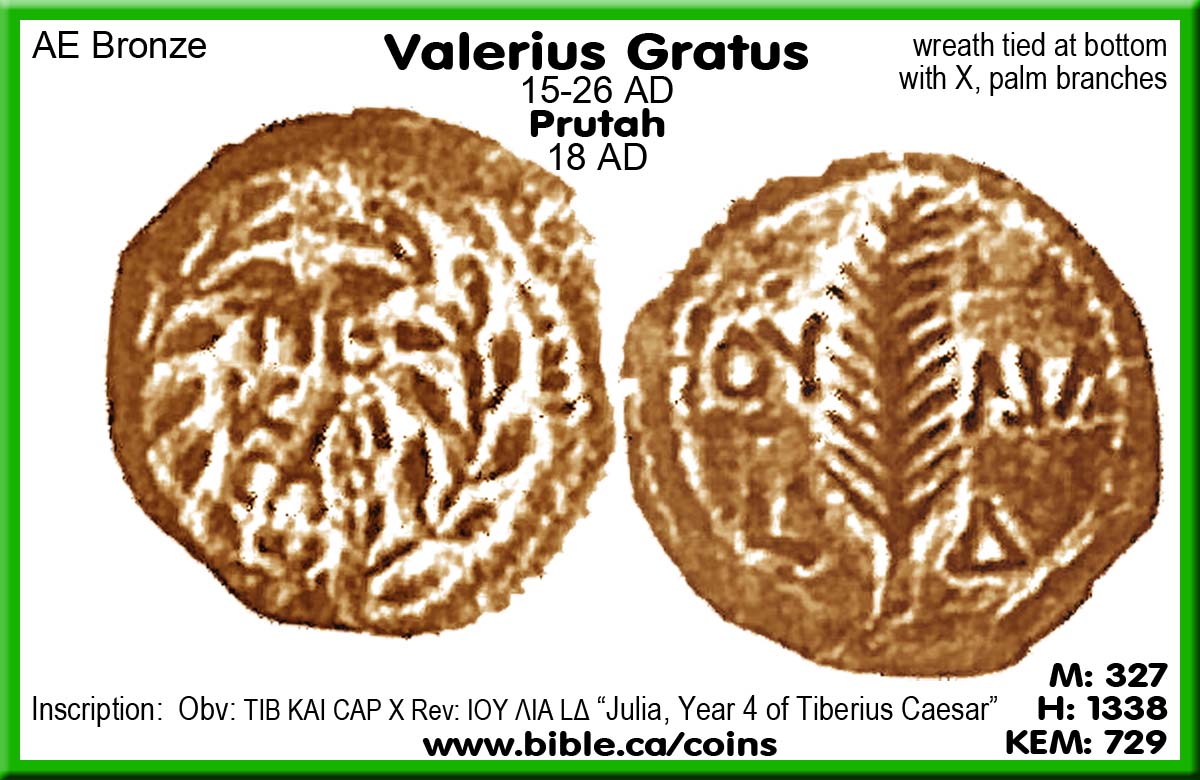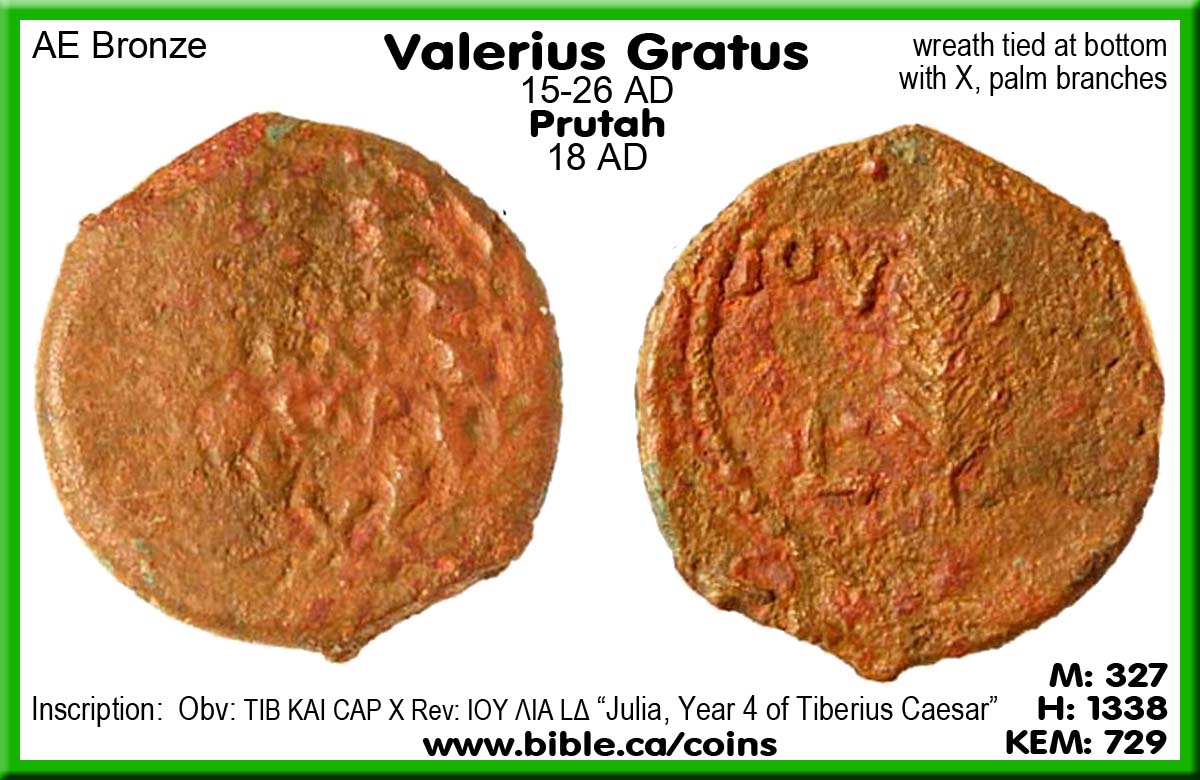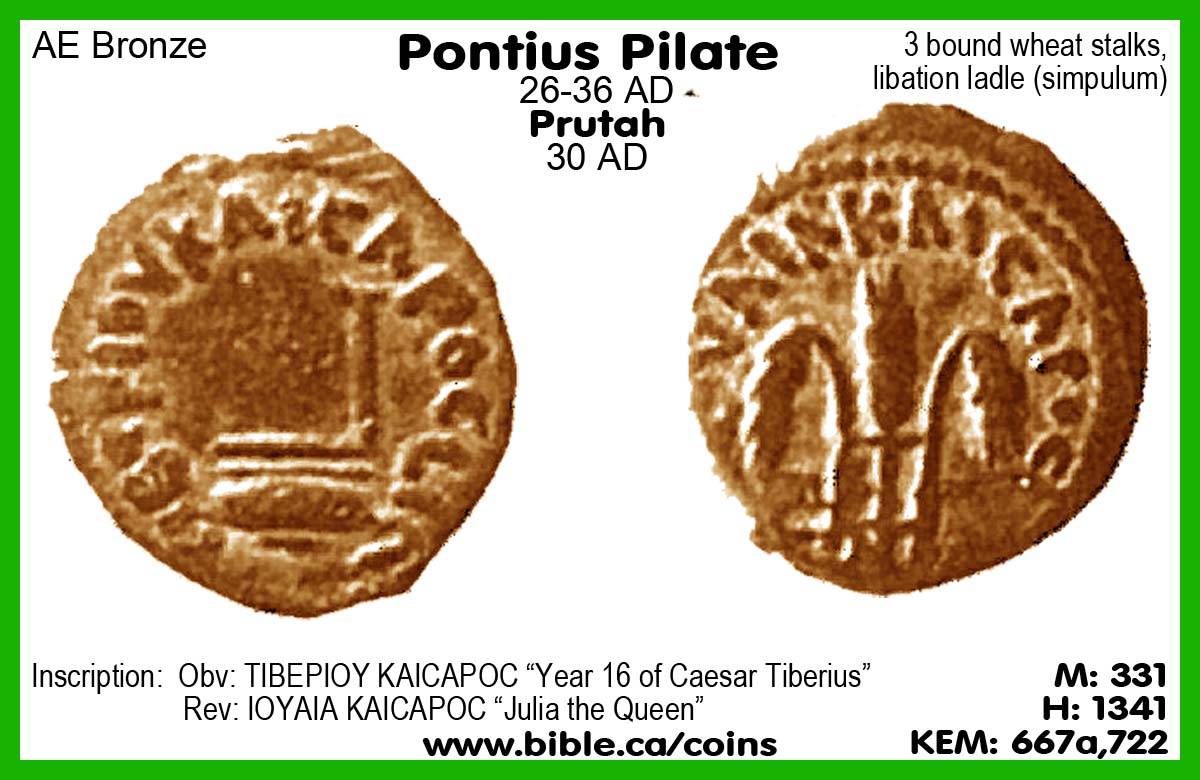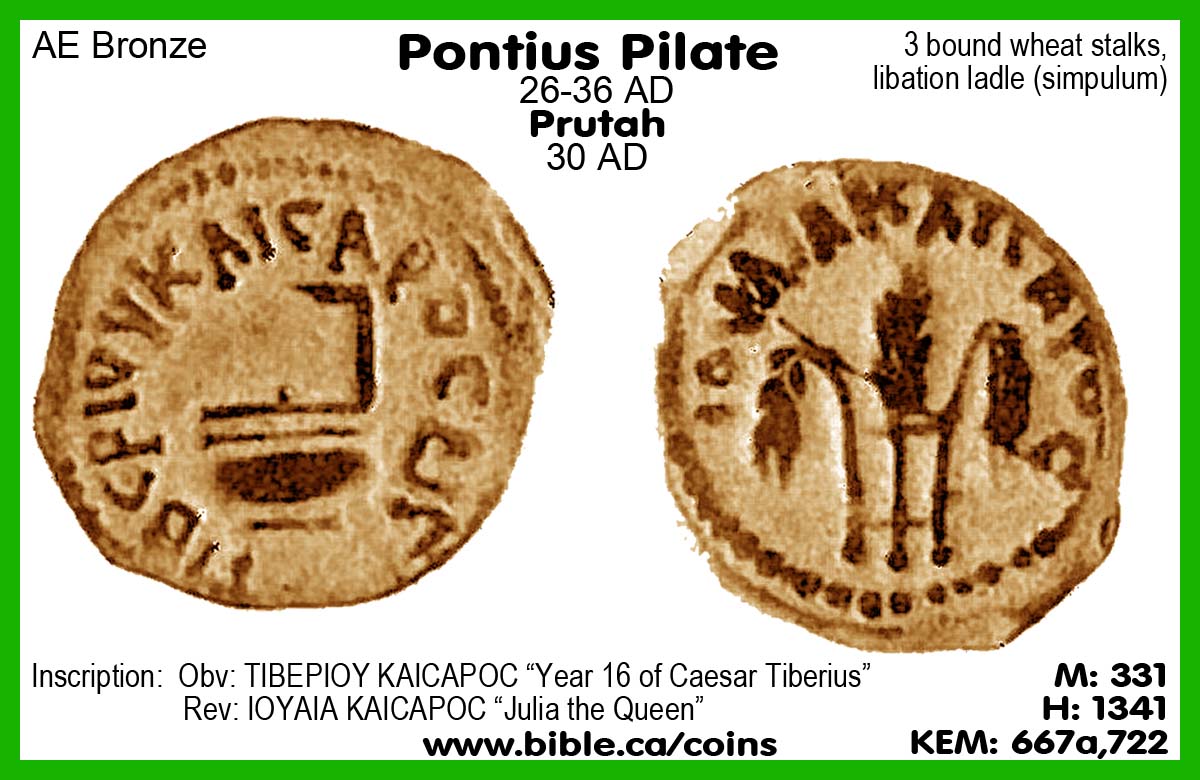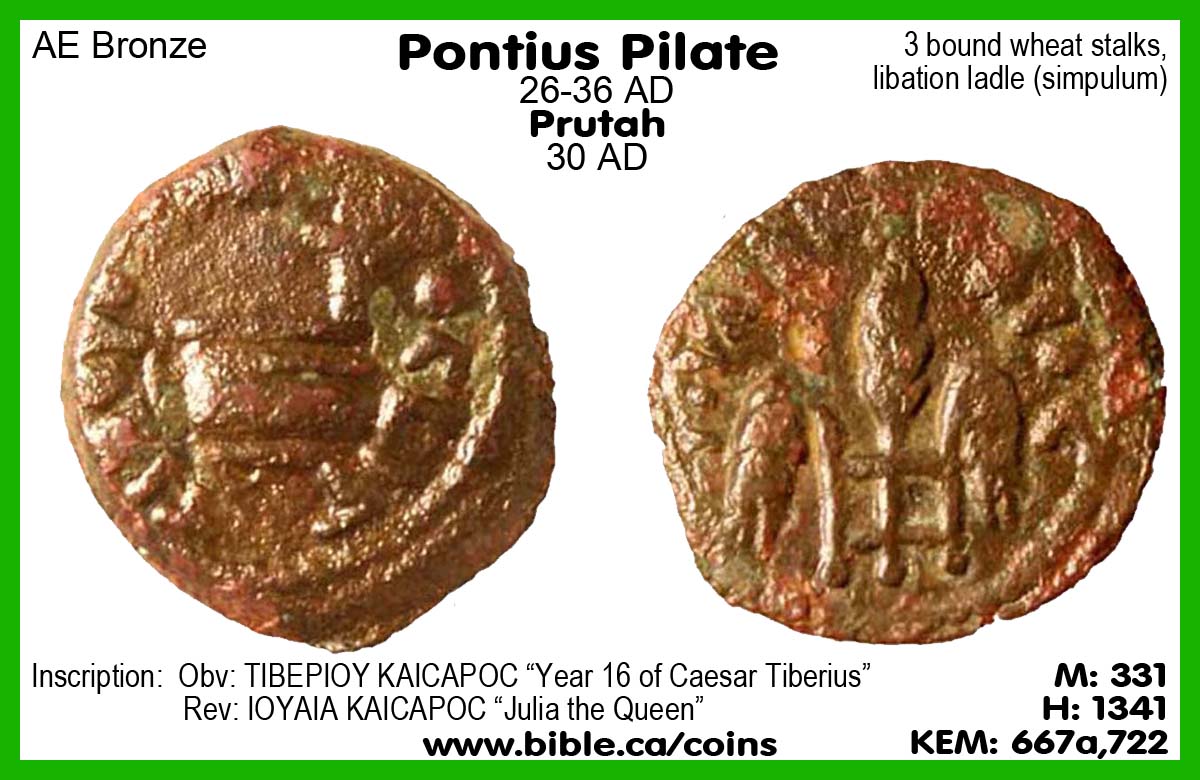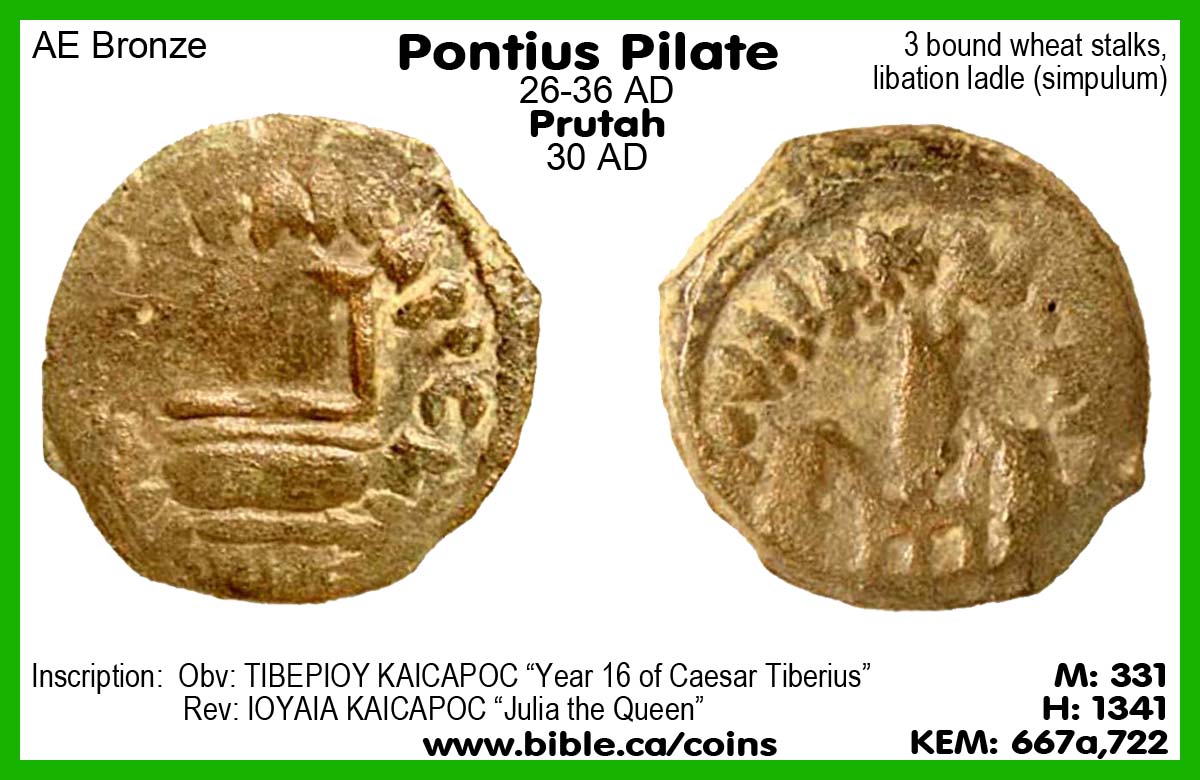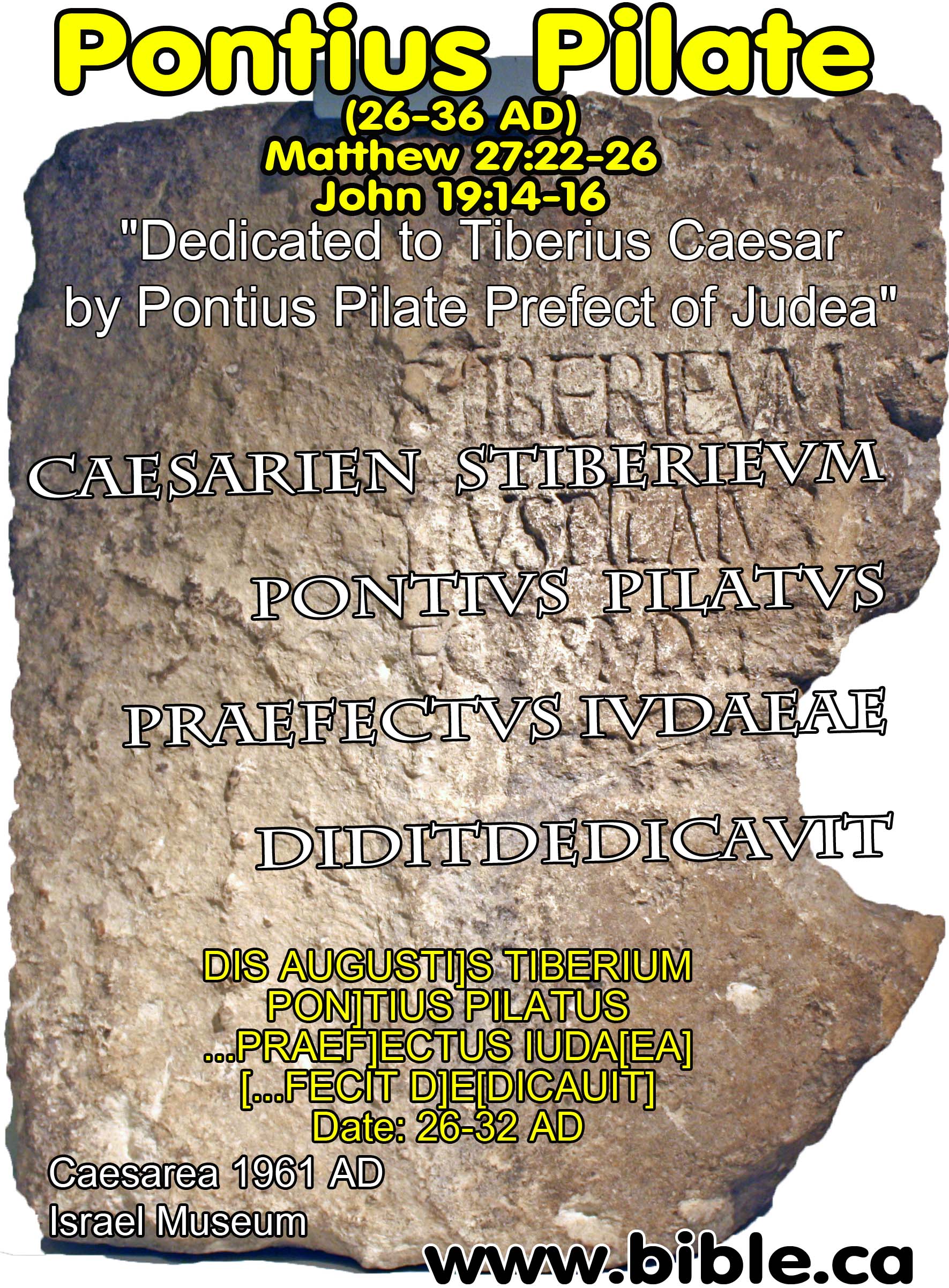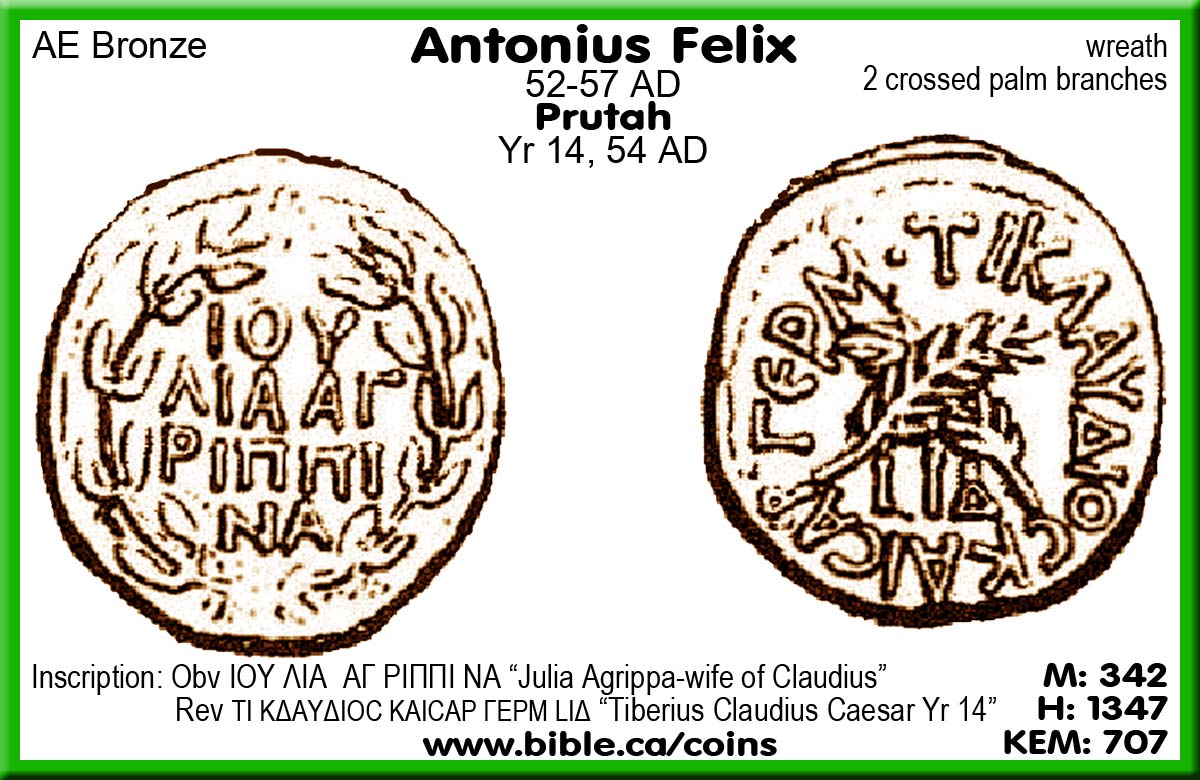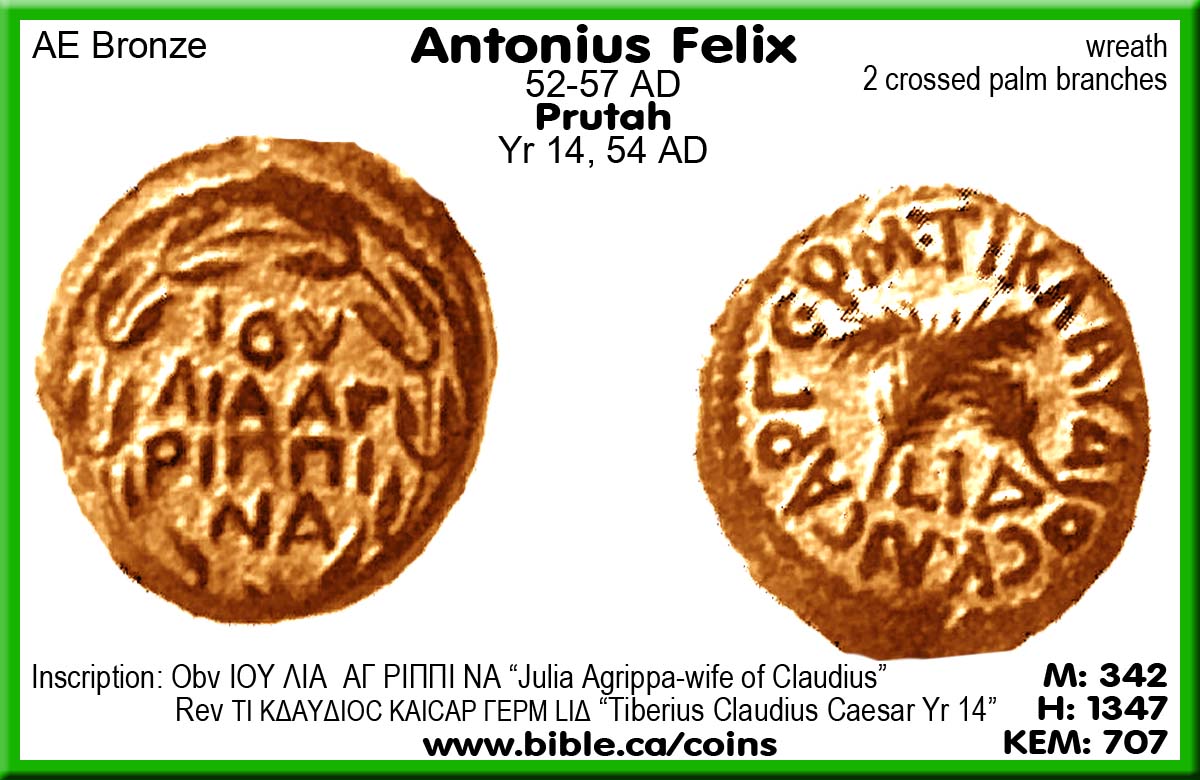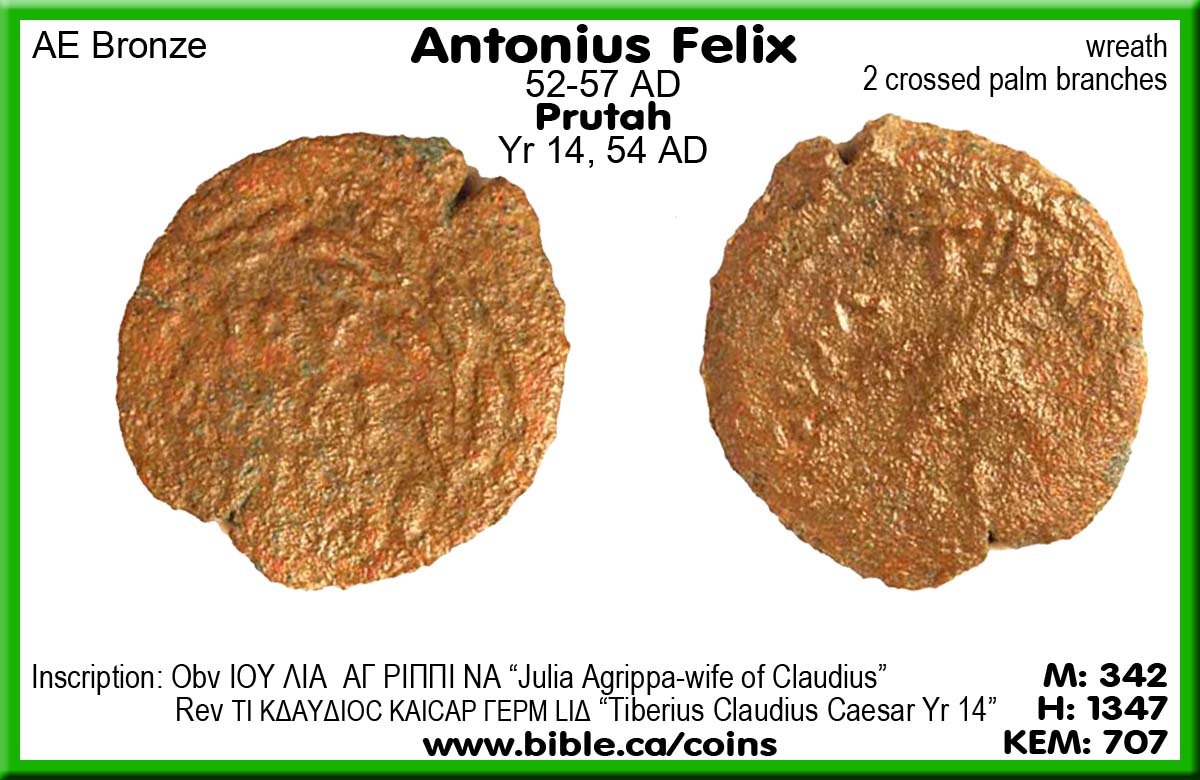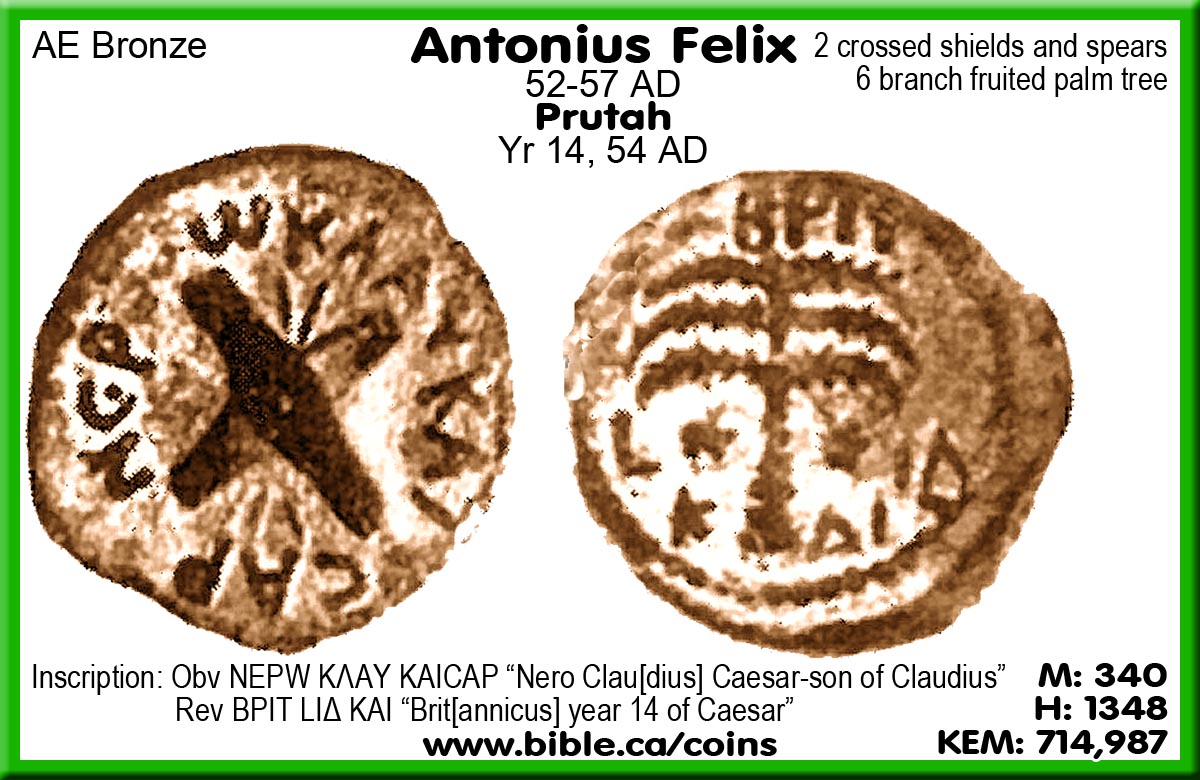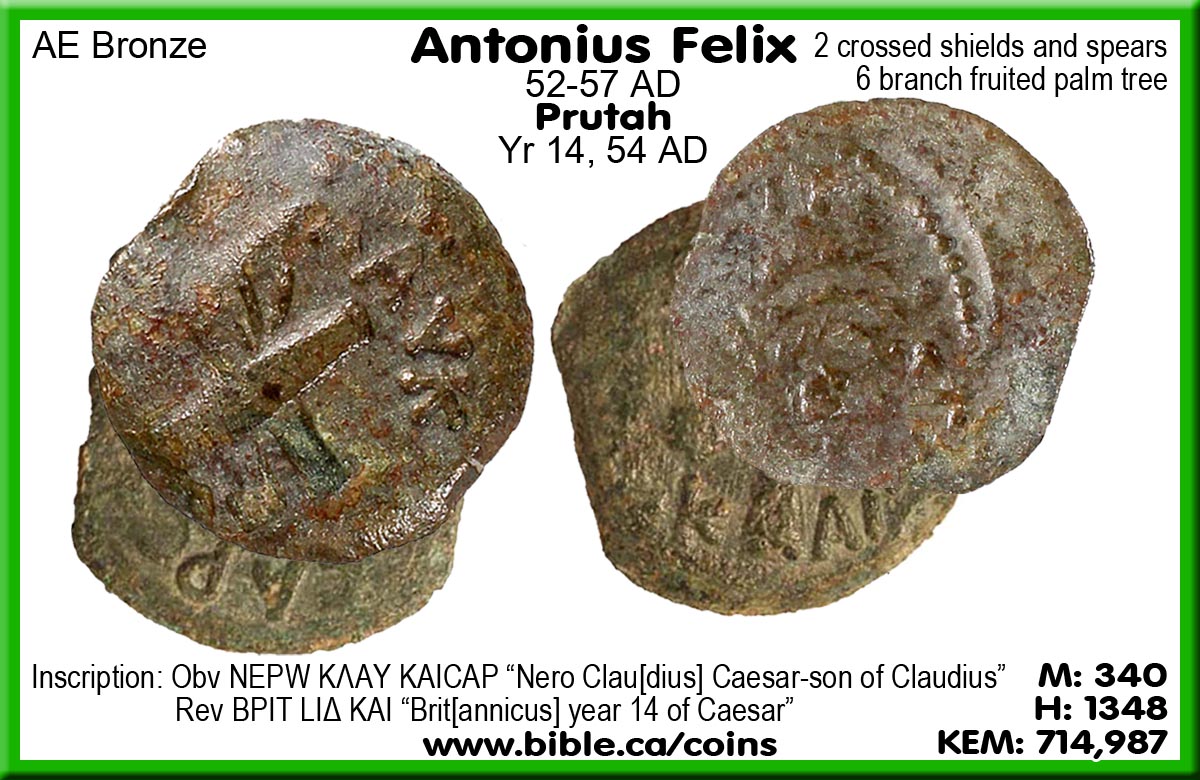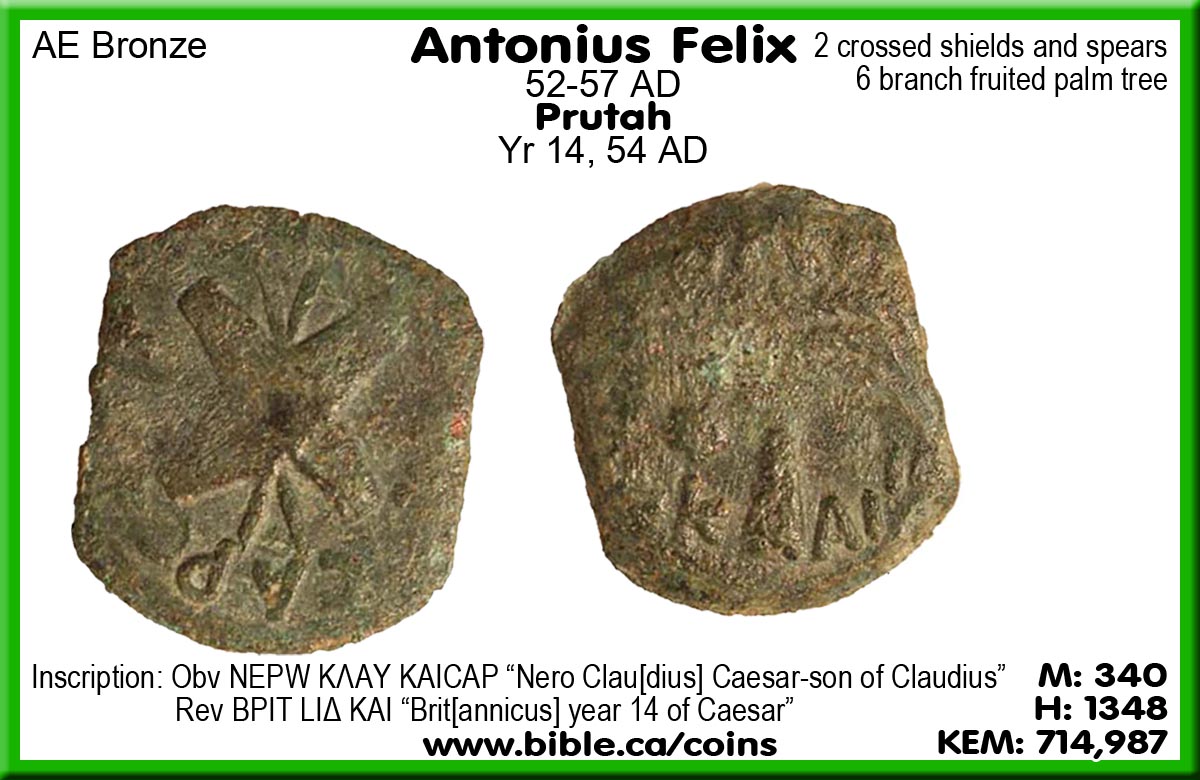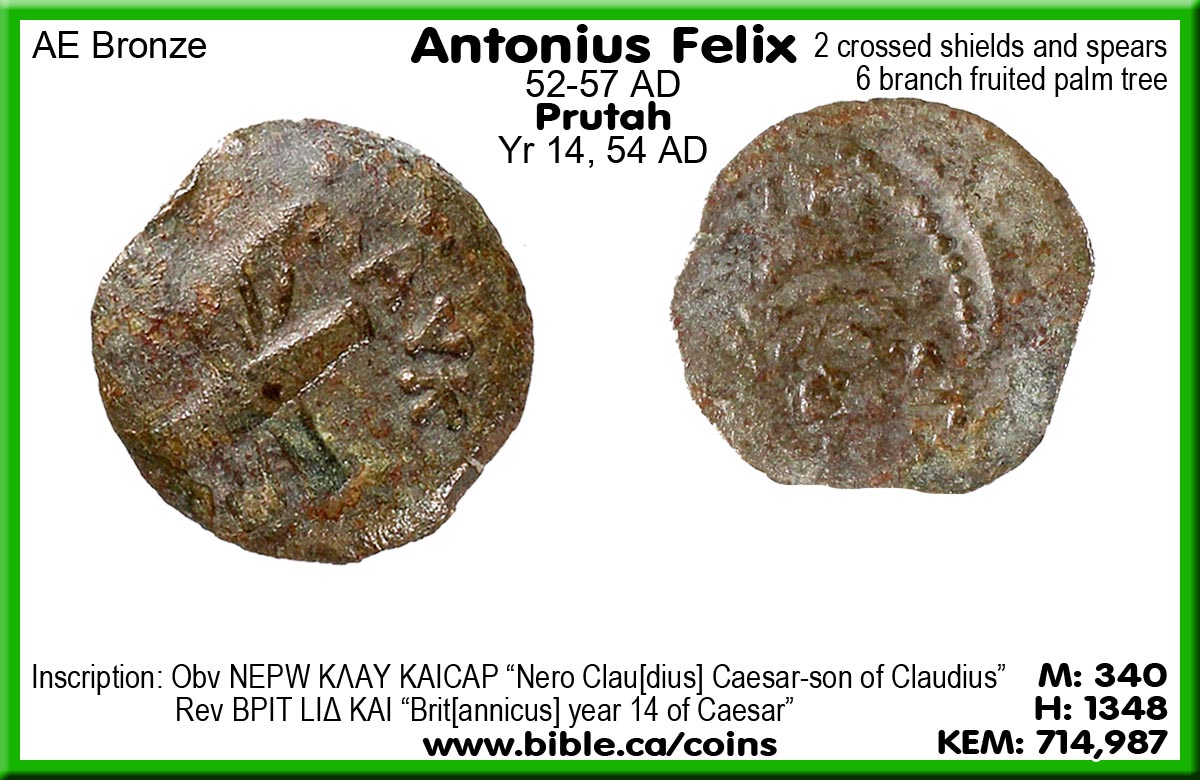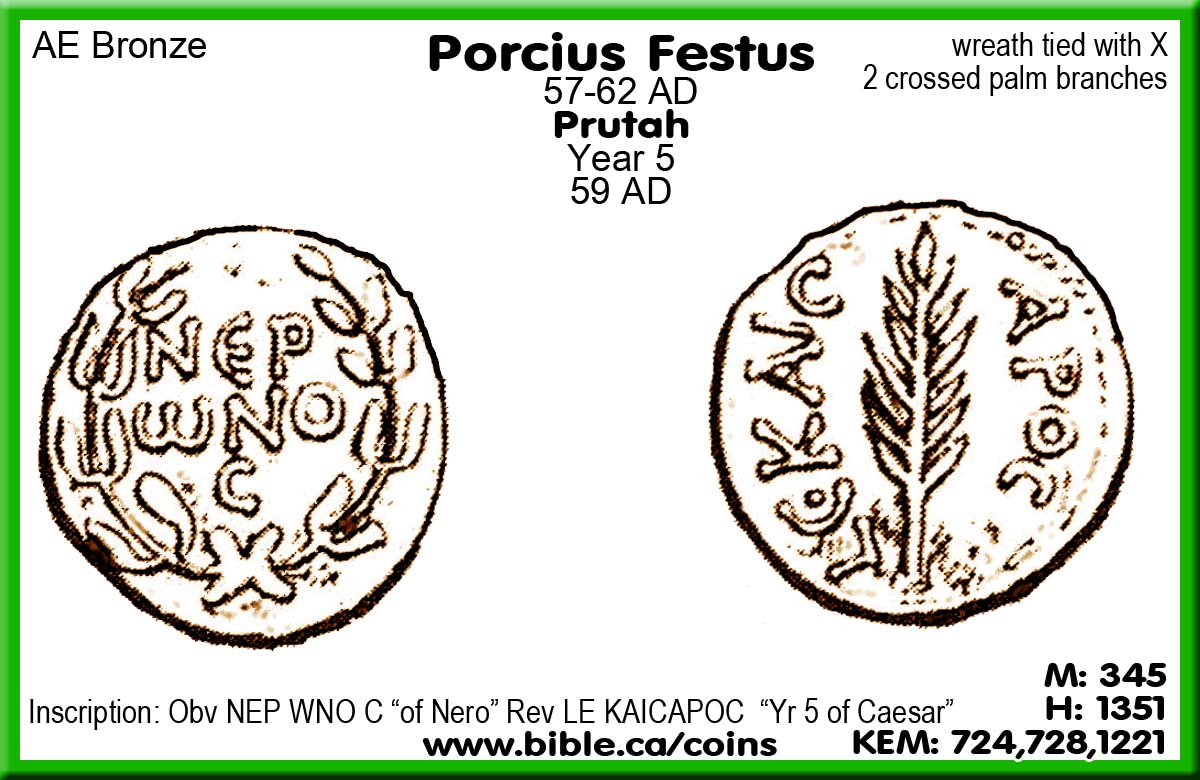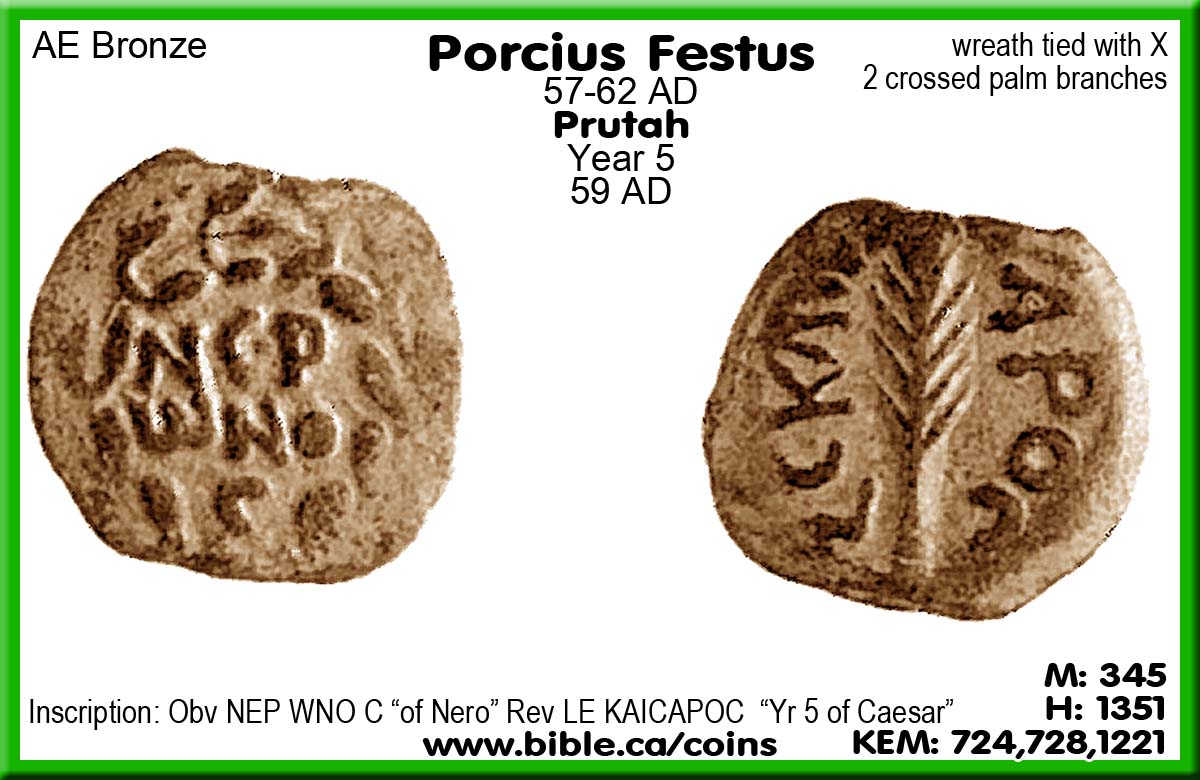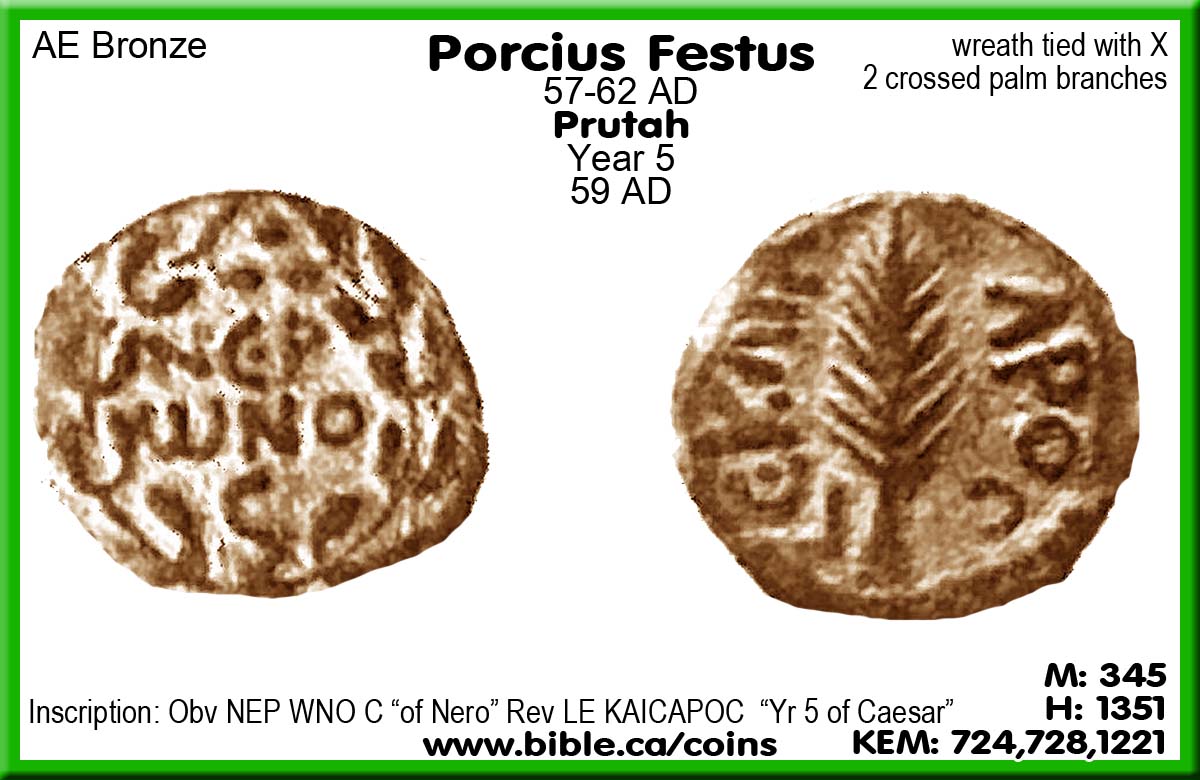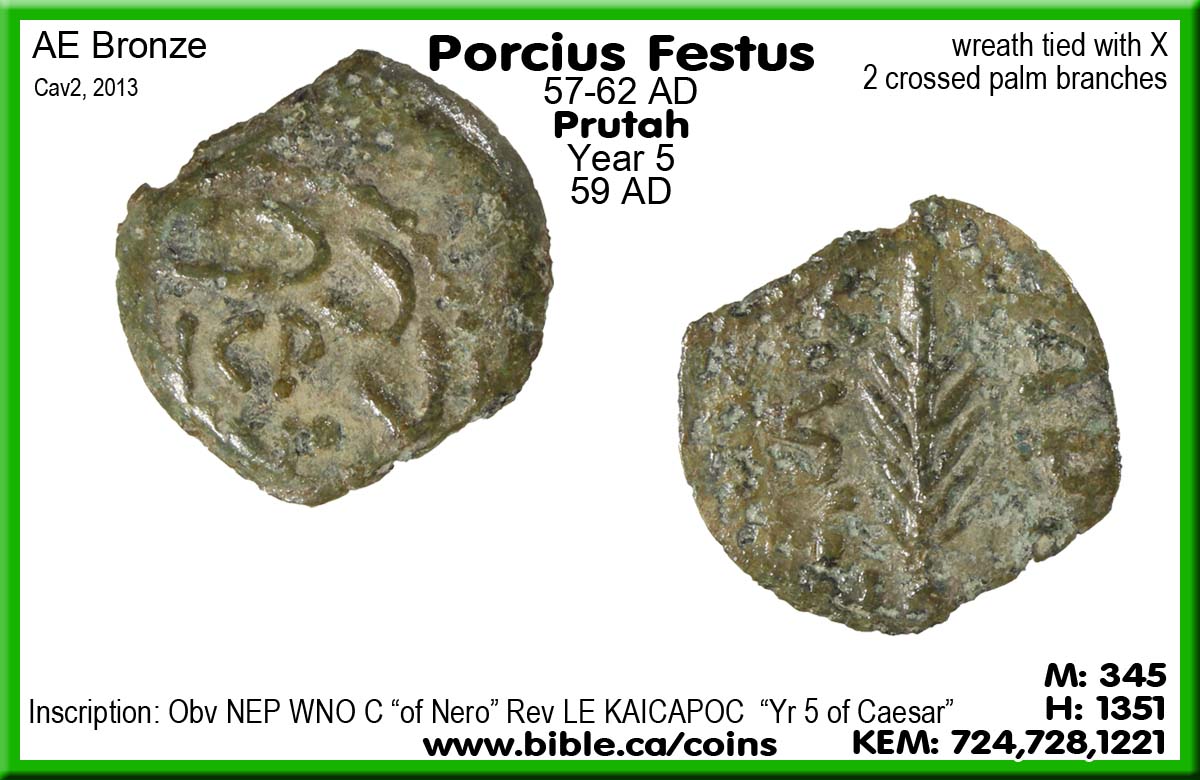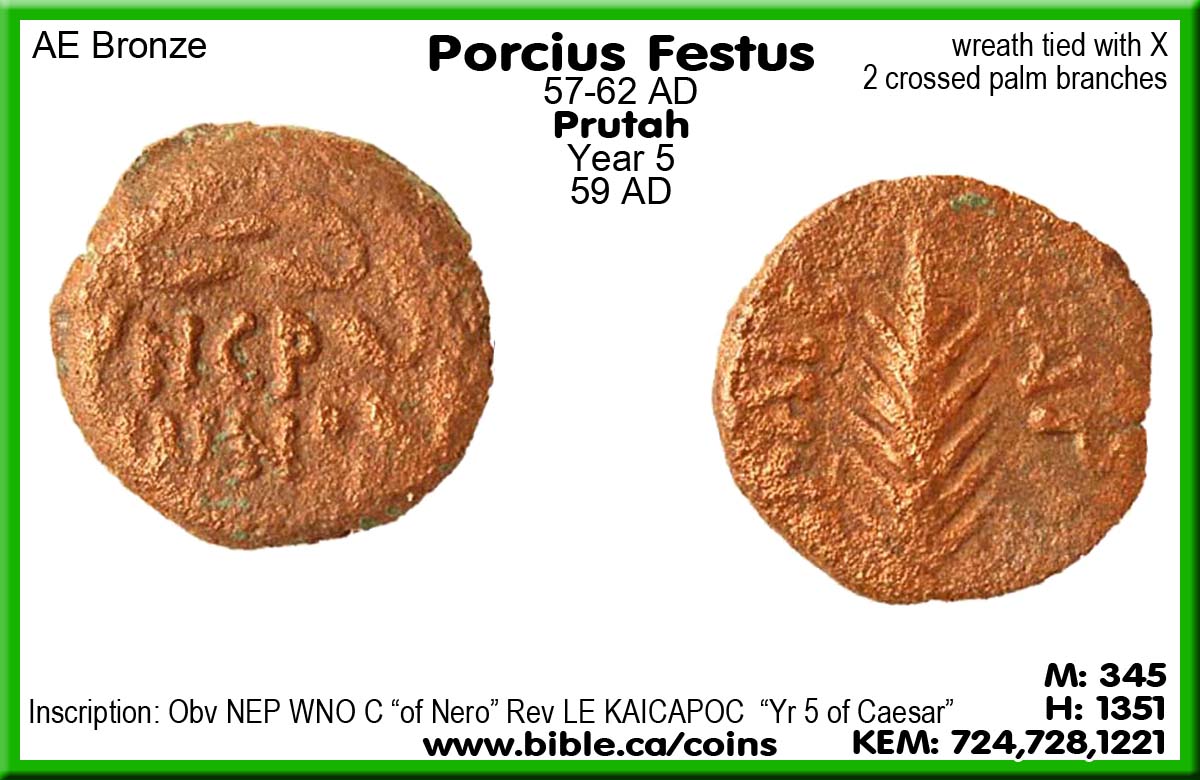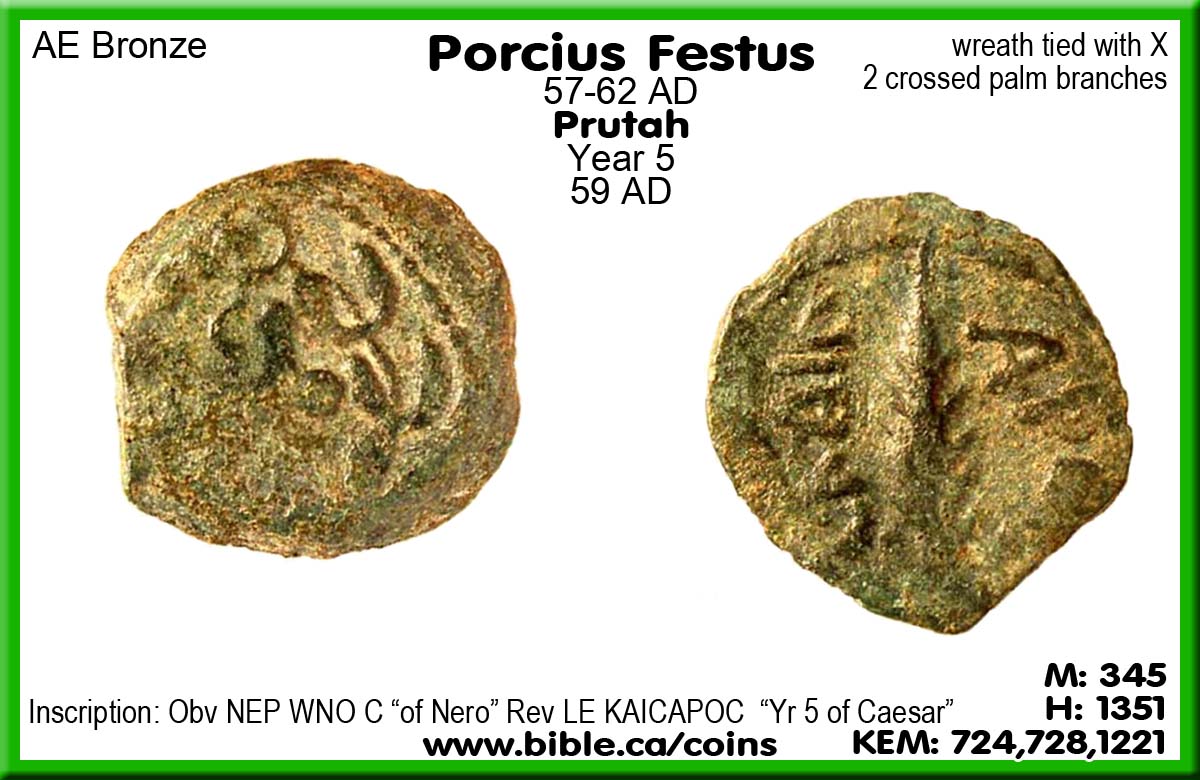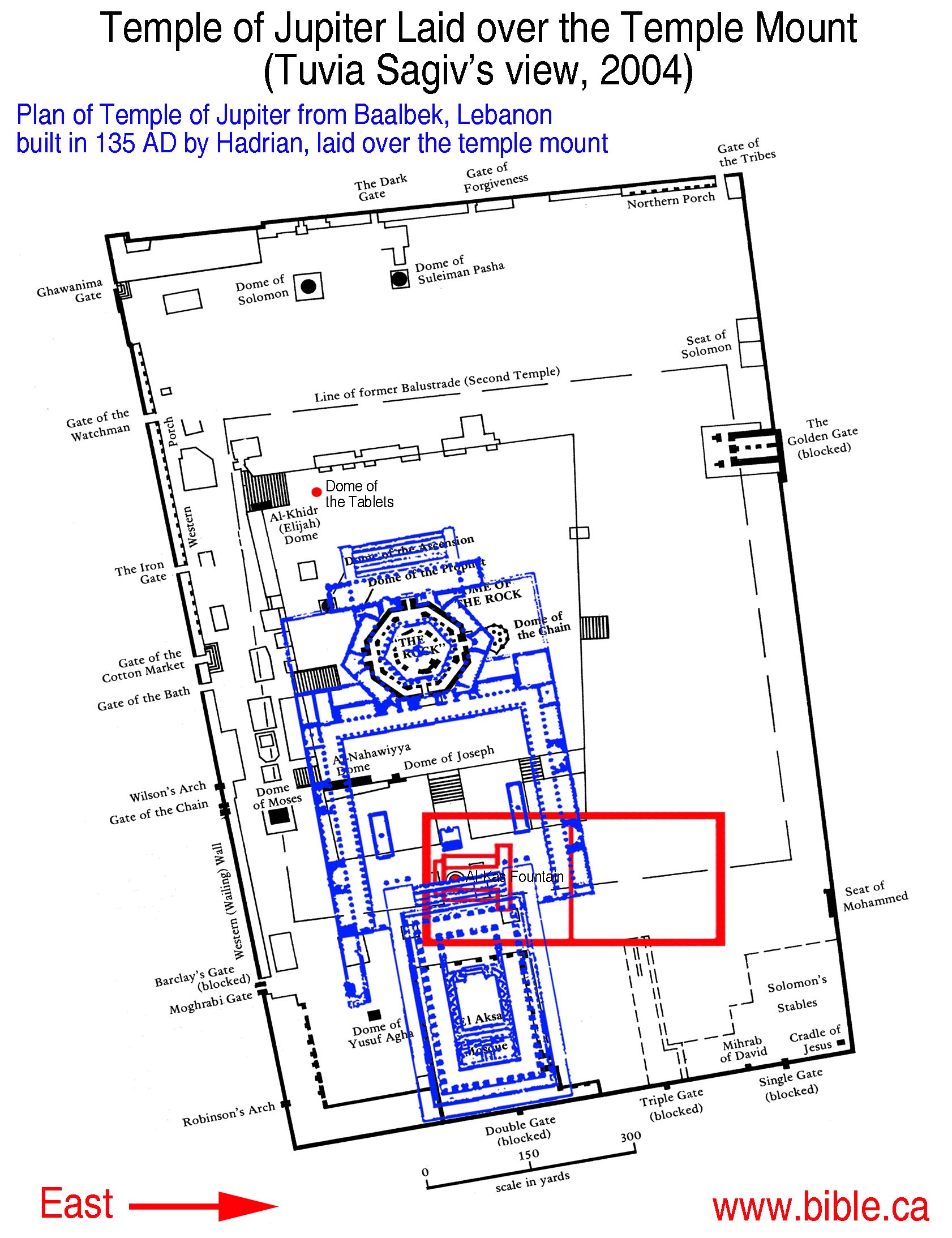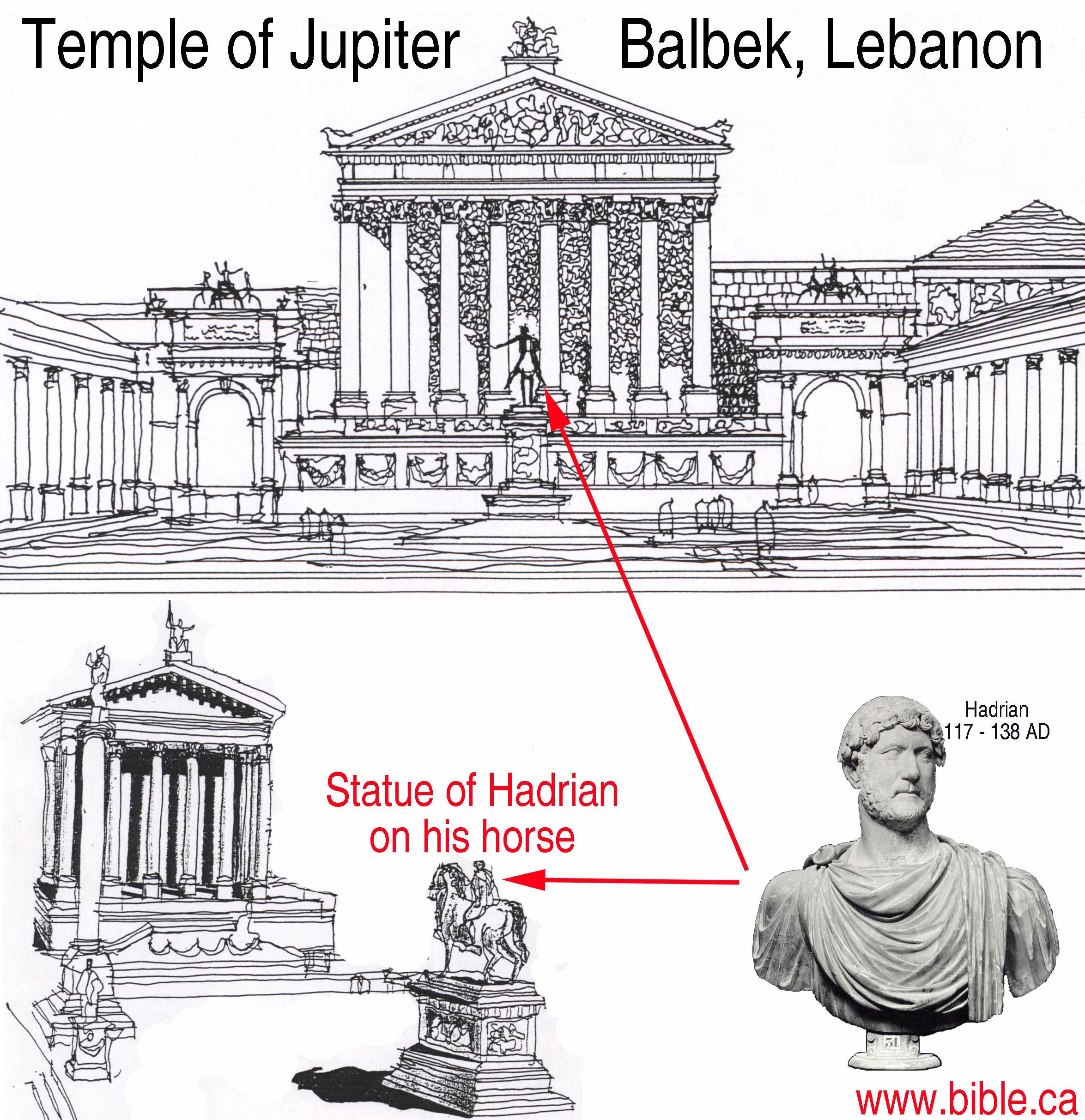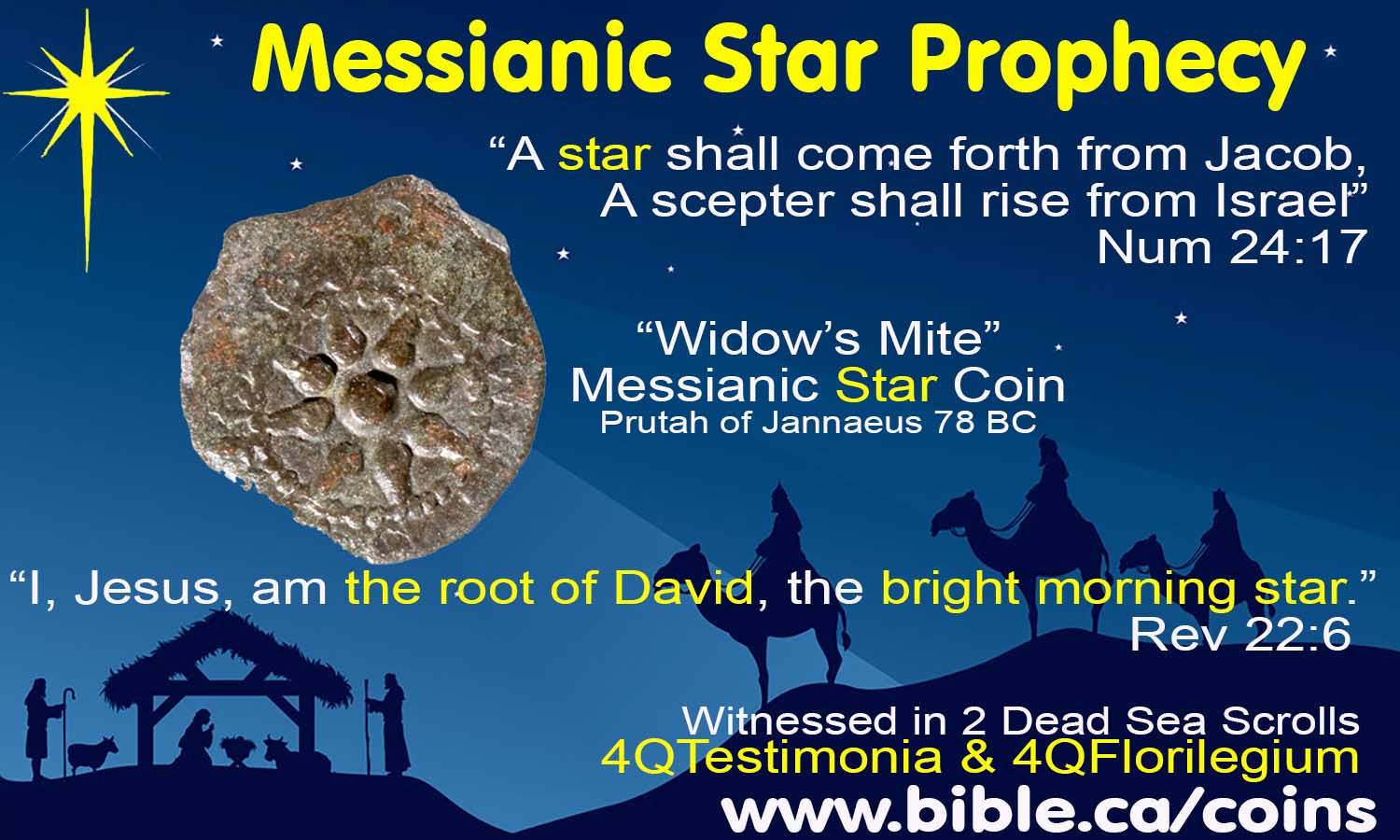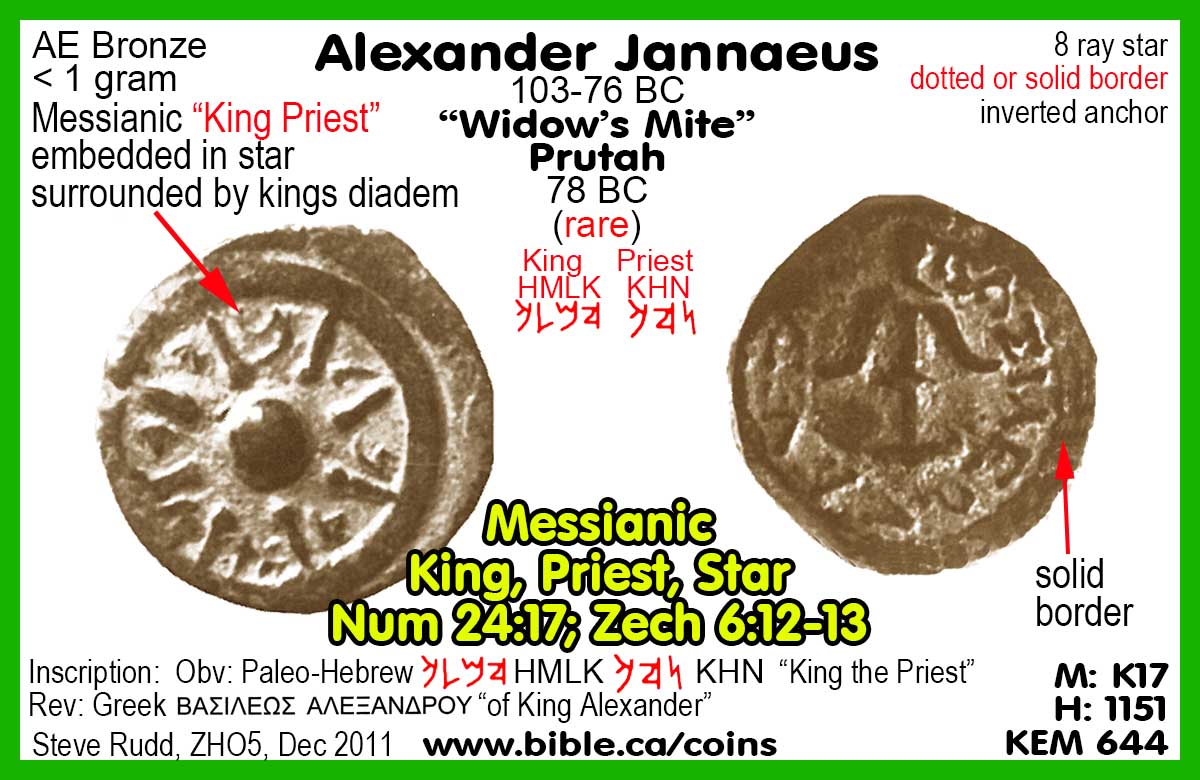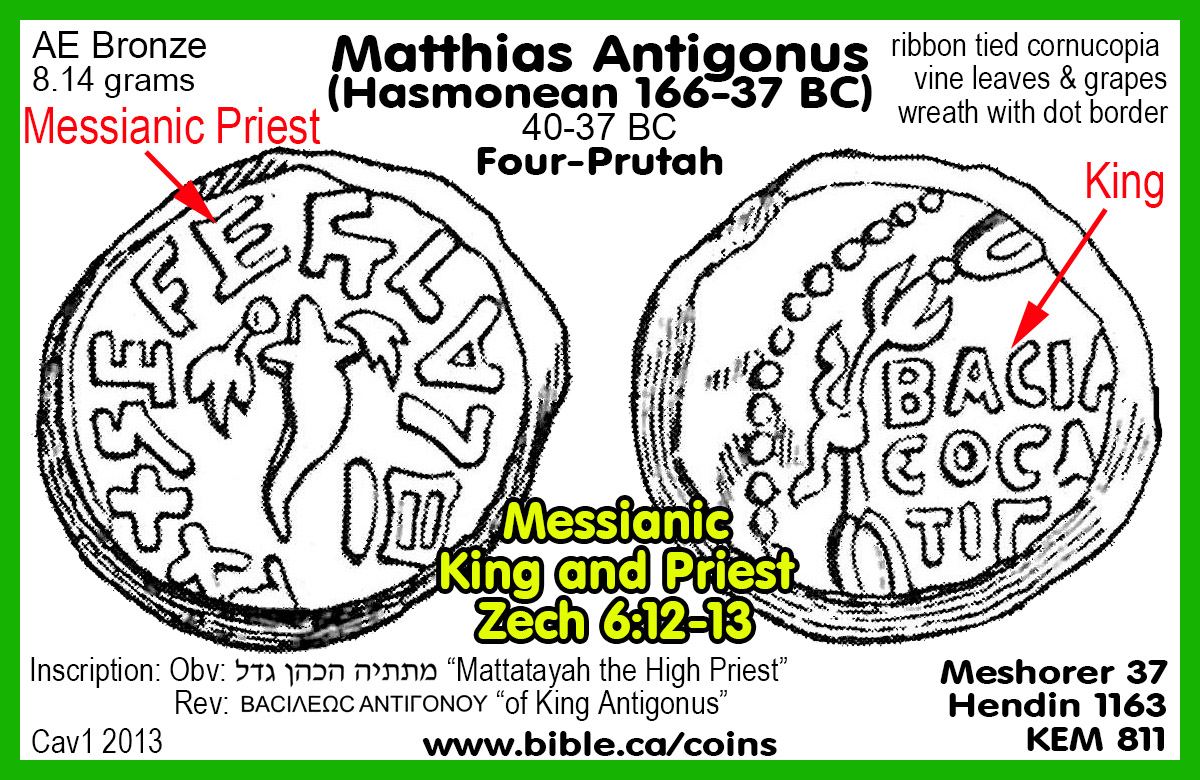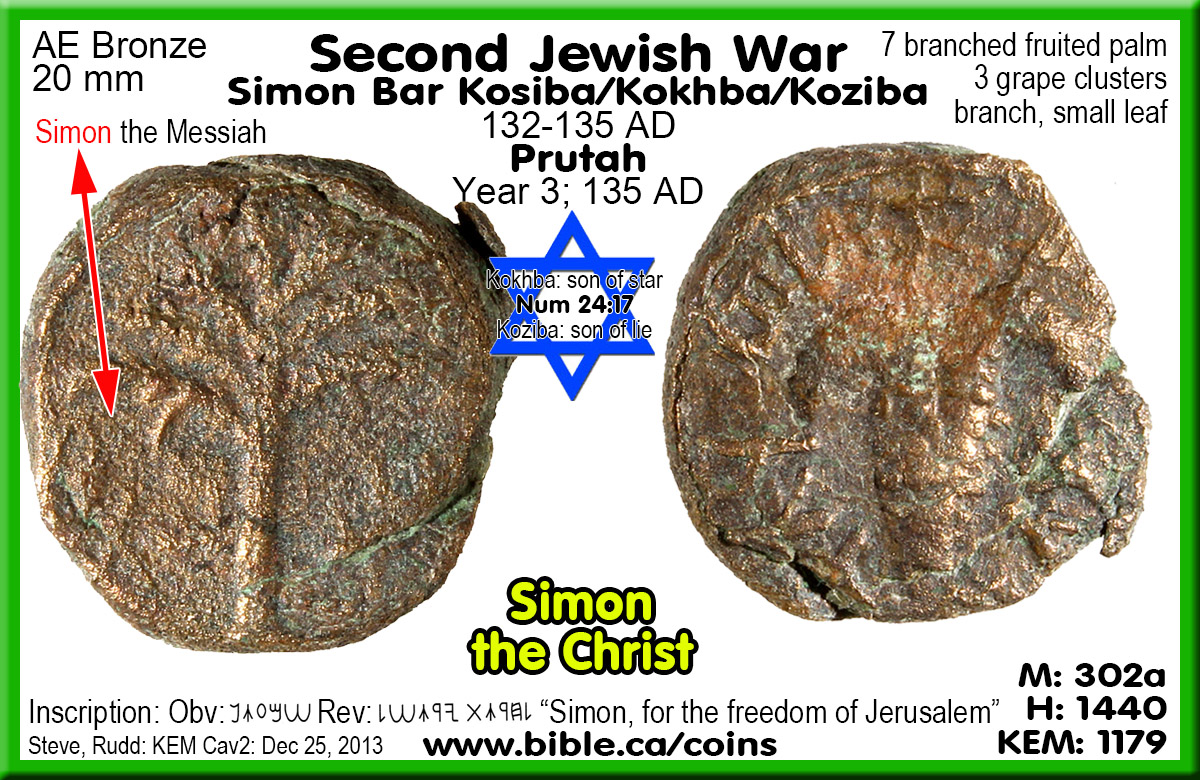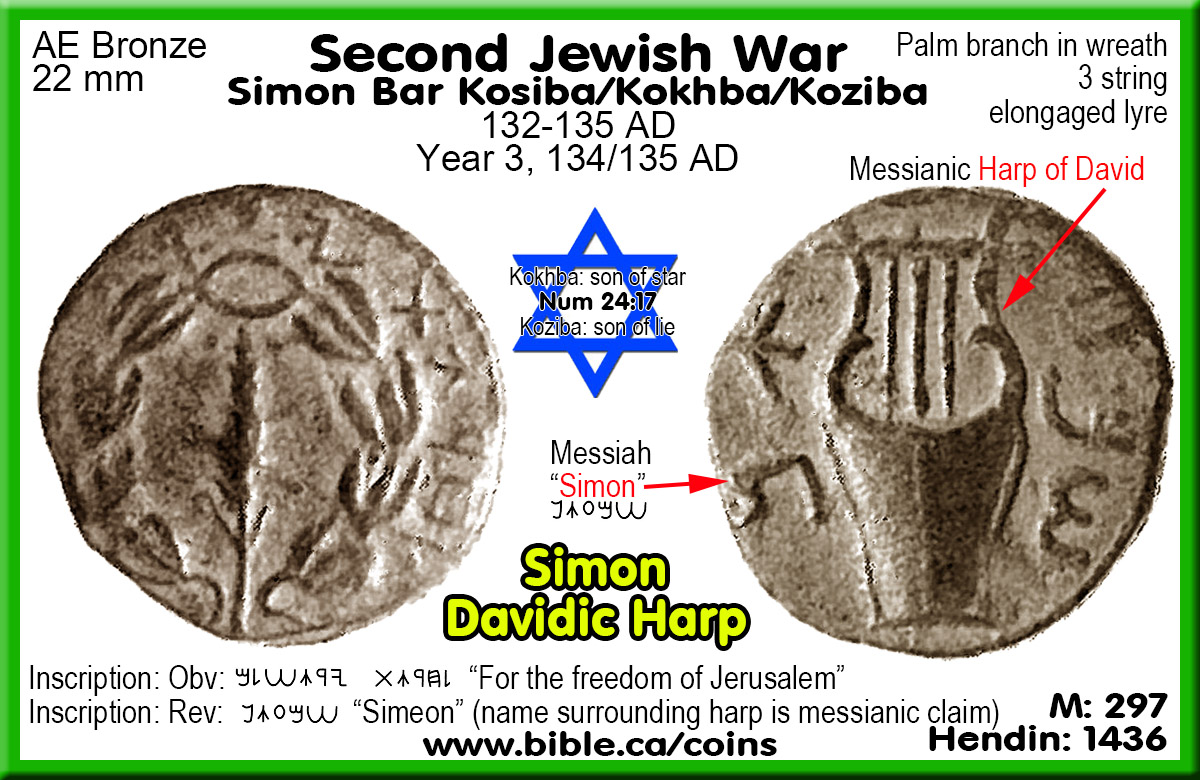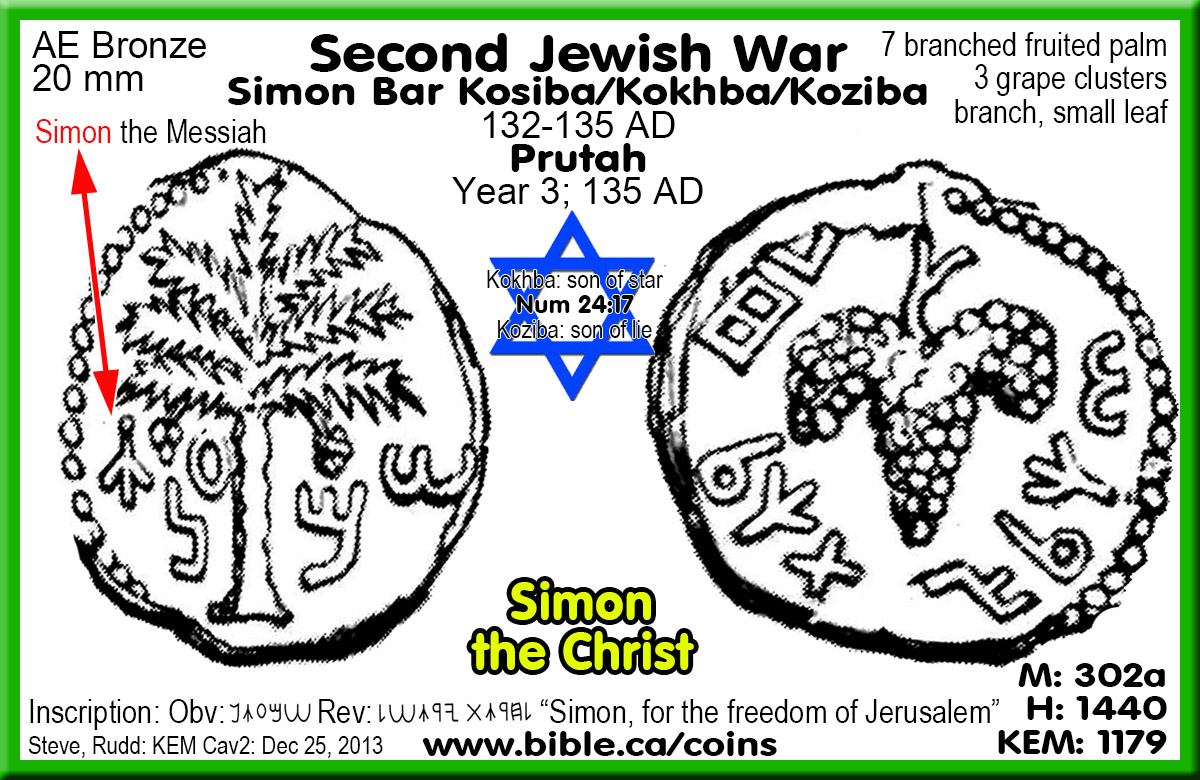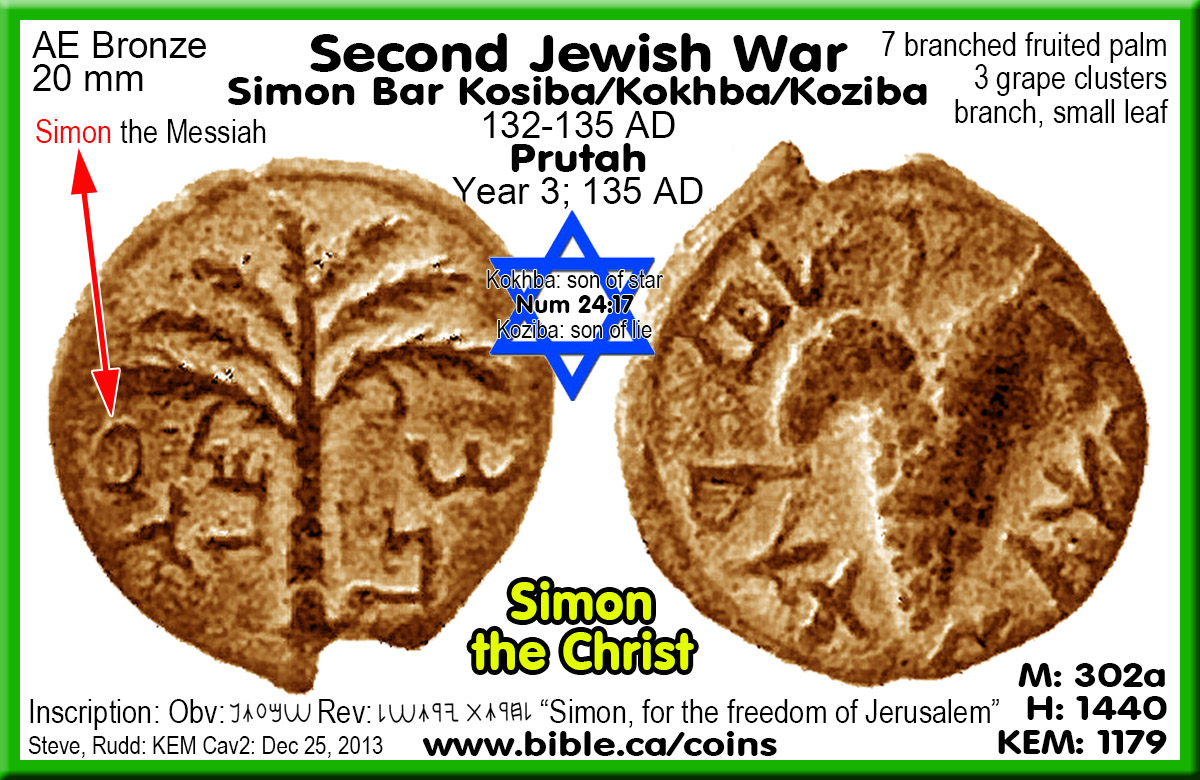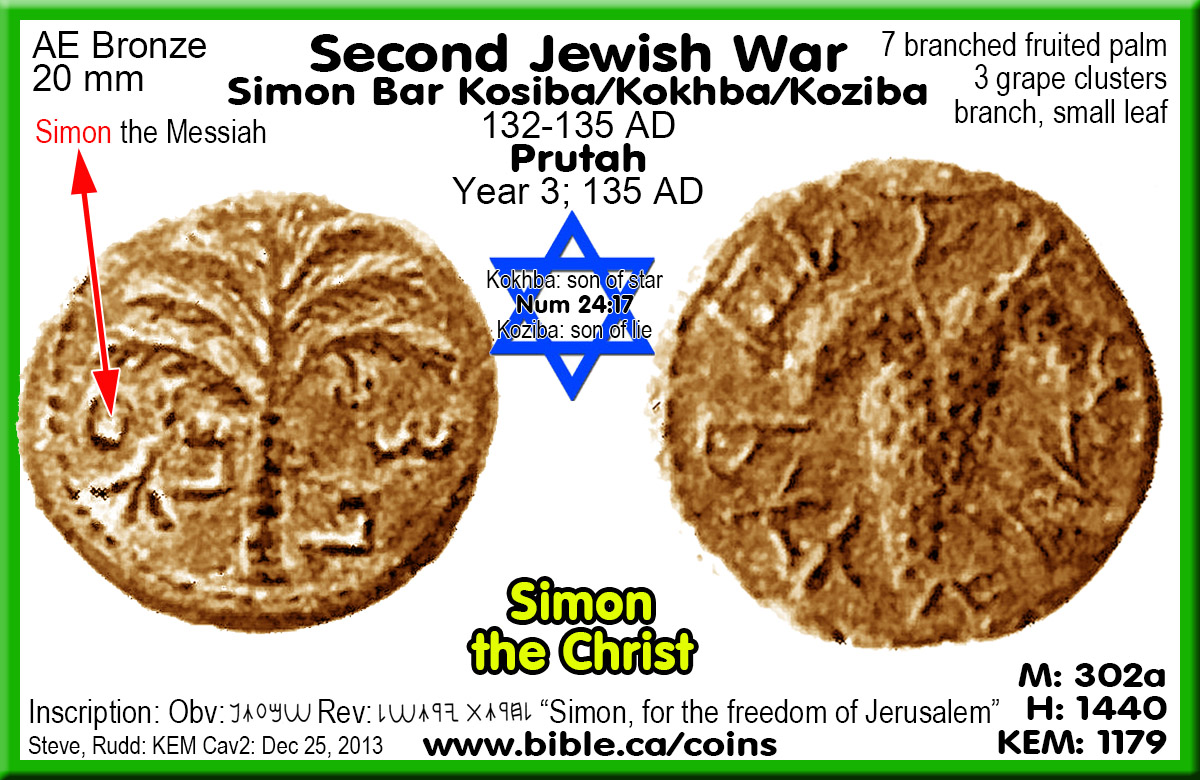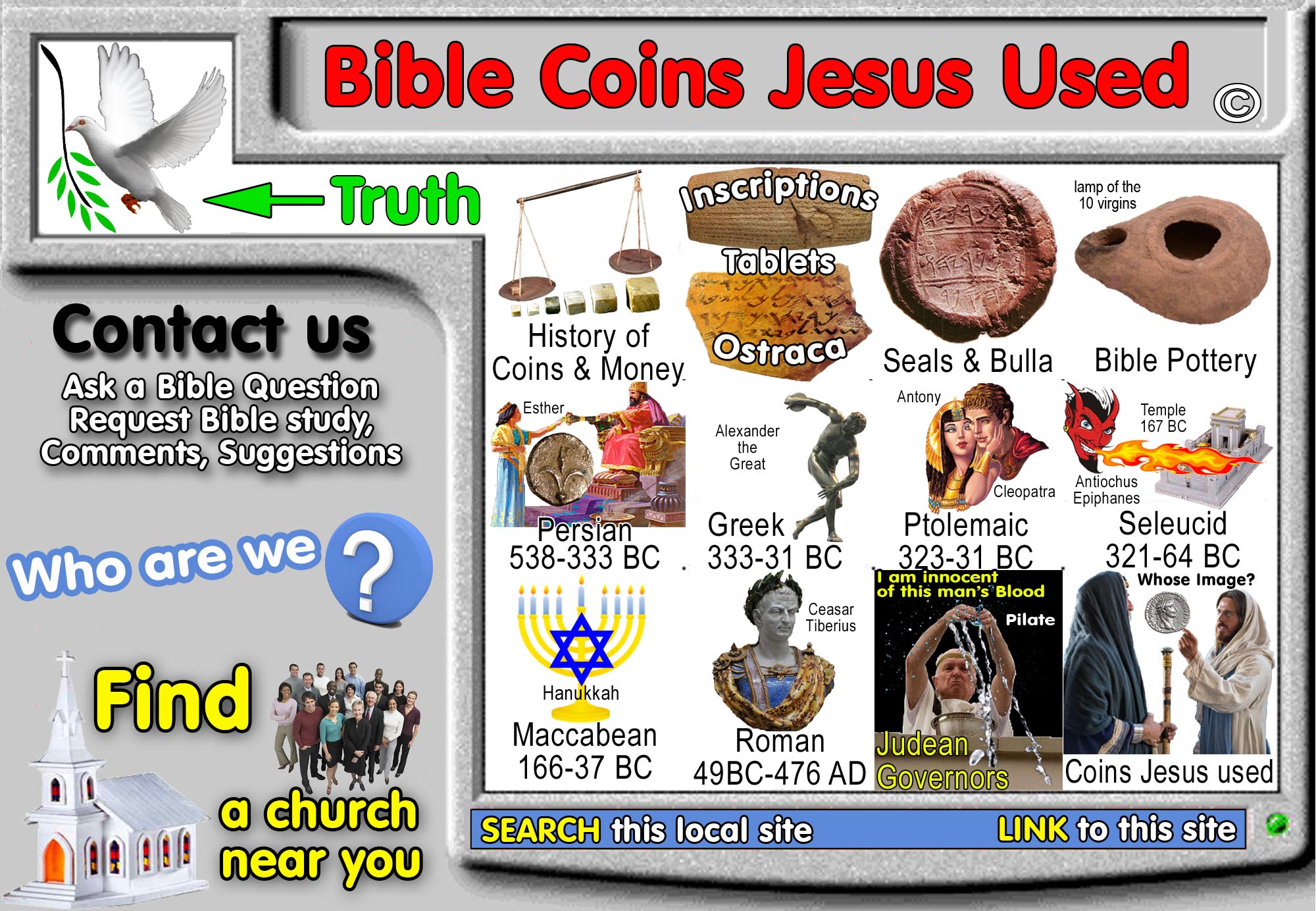The Judean Kings, Governors, Satraps, Procurators, Prefects: 587 BC - 66 AD
- Babylonian appointed governors of Judea: Gedaliah (and more)
- Persian appointed governors of Judea: Sheshbazzar, Zerubbabel, Nehemiah (and more)
- Roman appointed governors of Judea: Herod the Great, Agrippa, Pilate, Felix, Festus (and more)
- First Jewish War: 66-70 AD
- Second Jewish war: 132-135 AD (Simon bar Kokhba)
Introduction:
- From the time of the Babylonian Captivity that began in 605 BC down to 70 AD when the theocratic nation of Israel finally destroyed forever, they were under the control and domination of four foreign nations as predicted by Daniel. Of course, the whole point of Daniel's prophecy was that He would set up his eternal kingdom after the 4th kingdom of Rome came into existence.
- Babylon: 623 - 539 BC
- Persia: 539 - 333 BC
- Greece: 333 - 31 BC
- Rome: 31 BC - 476 AD
- Church (Pentecost 33 AD)
2. The Greek kingdom existed from 333 - 31 BC
a. Alexander the Great lived only ten years and ruled the world as a sole monarch from 333-323 BC
b. The early Greek/Macedonian period is 333 - 302 BC as far as classifying coins is concerned.
3. After Alexander the Great died, his kingdom was split into four Kingdoms: (Four "horns" empires after Alexander the Great)
- Ptolemy Empire (323-31 BC)
- Seleucid Empire (321-64 BC)
- Cassander (319-168 BC) We do not discuss this kingdom at all because it is far removed from land of Judah.
- Lysimachus (323-133 BC) We do not discuss this kingdom at all because it is far removed from land of Judah.
- For a short time during the Greek Empire period, the Jews gained true independence under the Maccabees (Hasmonean Era): 166-37 BC
- Rome conquered all by 31 BC and the fourth and final kingdom of Daniel's prophecy (Dan 2) came into existence.
5. The Maccabees provided a brief period of about 60 years of true independence from under the control of the Greek/Seleucid empire came to an end with the Romans and Herod the Great.
6. Herod the Great brought about huge changes in Jewish culture and worship:
a. Herod would build the Jews a temple in 18 months completed in 18 BC.
b.
In 18 BC, Herod transferred the manufacturing of the
Tyrian Shekel (official temple tax coin) from Tyre to a new mint in Jerusalem.
See outline
on the Shekel of Tyre.
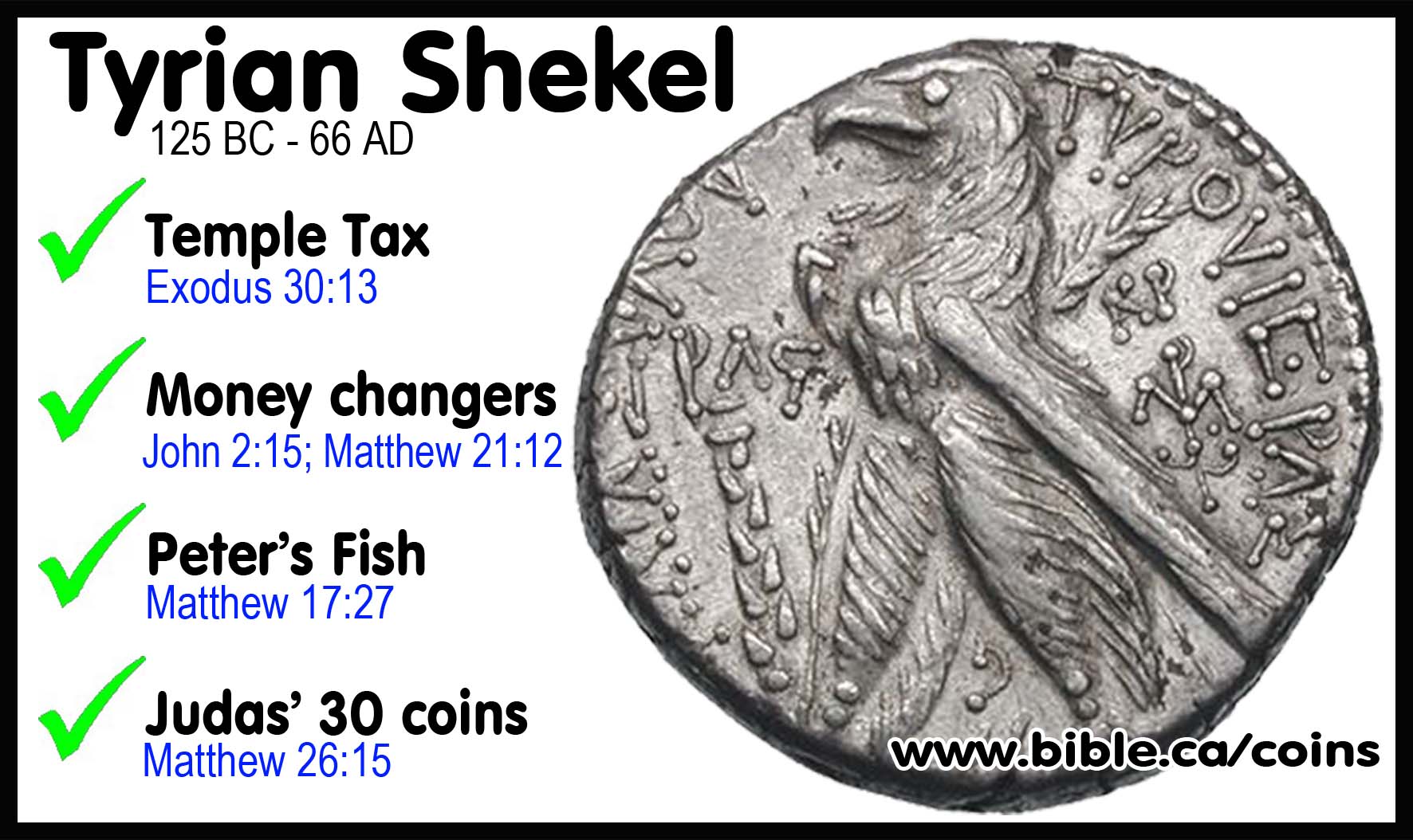
7. Jesus would be born in 2-1 BC and Herod would die in 1 BC.
8. The Roman empire would control the Jews up until the first Jewish war of 66 AD.
a. This rebellion resulted in the Romans coming down with a heavy hand and they easily crushed the rebellion and forever destroyed the temple in 70 AD.
b. A new temple had been raised from the dust, just as Jesus said: His body, THE CHURCH.
c. Jesus said the kingdom of God and the temple is not physical but within each of us!
- On Pentecost 33 AD, God set up his divine Kingdom which we know today as the Church of Christ which will never come to an end:
- "For this you know with certainty, that no immoral or impure person or covetous man, who is an idolater, has an inheritance in the kingdom of Christ and God." (Ephesians 5:5)
- "For He rescued us from the domain of darkness, and transferred us to the kingdom of His beloved Son, in whom we have redemption, the forgiveness of sins." (Colossians 1:13–14)
- Why not attend a local church that follows the pure Bible Blueprint in your own home town! Click here to find one
I. Babylonian appointed Governors of Judea:
- After the period of the kings came to an end, Israel was under foreign control right down to 70 AD with the exception of the brief Hasmonean/Maccabean rule (166-37 AD).
- First Judean Governor appointed by Nebuchadnezzar: Gedaliah
- Gedaliah was the first post 597 BC Governor in a long line of governors of Judah that date down to 70 AD.
- Full outline on Gedaliah: Gedaliah
- Gedaliah is the only governor of Judea we know about until the Persian age that began in 333 BC.
|
Gedaliah 1st Governor of Judea in 587 BC "Archaeologists are digging up bible stories!!!" 1. Glyptic artifact: Clay Bulla 2. Inscription: "Belonging to Gedaliah who is over the house" 3. Provenance: Lachish official archeological dig 1935 AD season 4. Current location: Israel Museum 5. Date: 587 BC 6. Bible verses: Jer 39-44: 2 Kings 25:22; Jeremiah 40:13–41:4 7. Events: Gedaliah, 1st Judean governor appointed by Nebuchadnezzar in 587 BC, assassinated by Ishmael and Baalis. Full outline: Gedaliah |
II. Persian appointed governors and Satraps of Judea after Jerusalem was destroyed in 587 BC:
During the Persian era we know the names of 8 governors of Judah including their several bullae, pottery handle stamps and coins!
- Sheshbazzar: The first governor: 533-520 BC
- The decree of Cyrus in Ezra 1:1 happened in 539 BC. Five years later Sheshbazzar and Zerubbabel leave for Jerusalem
- "Also King Cyrus brought out the articles of the house of the Lord, which Nebuchadnezzar had carried away from Jerusalem and put in the house of his gods; and Cyrus, king of Persia, had them brought out by the hand of Mithredath the treasurer, and he counted them out to Sheshbazzar, the prince of Judah." (Ezra 1:7–8)
- "‘Also the gold and silver utensils of the house of God which Nebuchadnezzar had taken from the temple in Jerusalem, and brought them to the temple of Babylon, these King Cyrus took from the temple of Babylon and they were given to one whose name was Sheshbazzar, whom he had appointed governor." (Ezra 5:14)
- Zerubbabel: The second governor: 520-510 BC
- Both Sheshbazzar and Zerubbabel are said to lay the foundations of the Temple:
- "Then that Sheshbazzar came and laid the foundations of the house of God in Jerusalem; and from then until now it has been under construction and it is not yet completed.’" (Ezra 5:16)
- "Now in the second year of their coming to the house of God at Jerusalem in the second month, Zerubbabel the son of Shealtiel and Jeshua the son of Jozadak and the rest of their brothers the priests and the Levites, and all who came from the captivity to Jerusalem, began the work and appointed the Levites from twenty years and older to oversee the work of the house of the Lord. Then Jeshua with his sons and brothers stood united with Kadmiel and his sons, the sons of Judah and the sons of Henadad with their sons and brothers the Levites, to oversee the workmen in the temple of God. Now when the builders had laid the foundation of the temple of the Lord, the priests stood in their apparel with trumpets, and the Levites, the sons of Asaph, with cymbals, to praise the Lord according to the directions of King David of Israel." (Ezra 3:8–10)
- The solution is simple: When Sheshbazzar was the Governor, Zerubbabel was a high ranking official. Think of Moses and Joshua, Elijah and Elisha etc. Both were present at the laying of the foundation. When Sheshbazzar died, Zerubbabel succeeded him as Governor of Judah.
- Elnathan The third governor: 510-490 BC
- Archeology has found two bullas and seals with "phwʾ" with the name of Elnathan on them.
- The first has an inscription with “Belonging to Elnathan the governor” on it.
- The second is called the Shelomith seal
with this inscription on it: “Belonging to Shelomith, maidservant
of Elnathan the governor.”
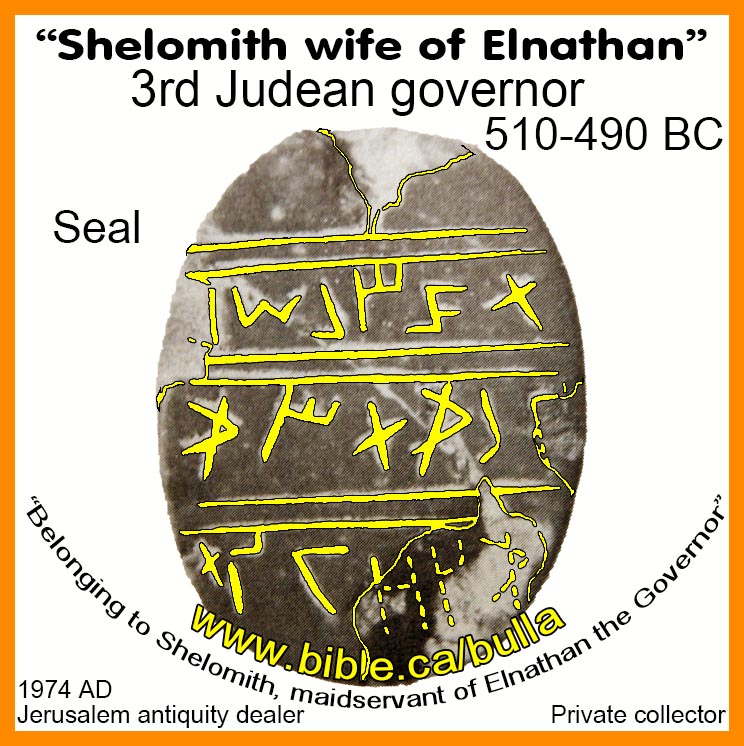
- He is not mentioned in the Bible.
- This is an excellent example of where
archeology can fill in gaps of information the Bible lacks. This of
course, does not take away from the inspiration of the bible, since there
are many facts of history the Bible does not contain. However, any time
the Bible does touch upon history it is always right 100% of the time!
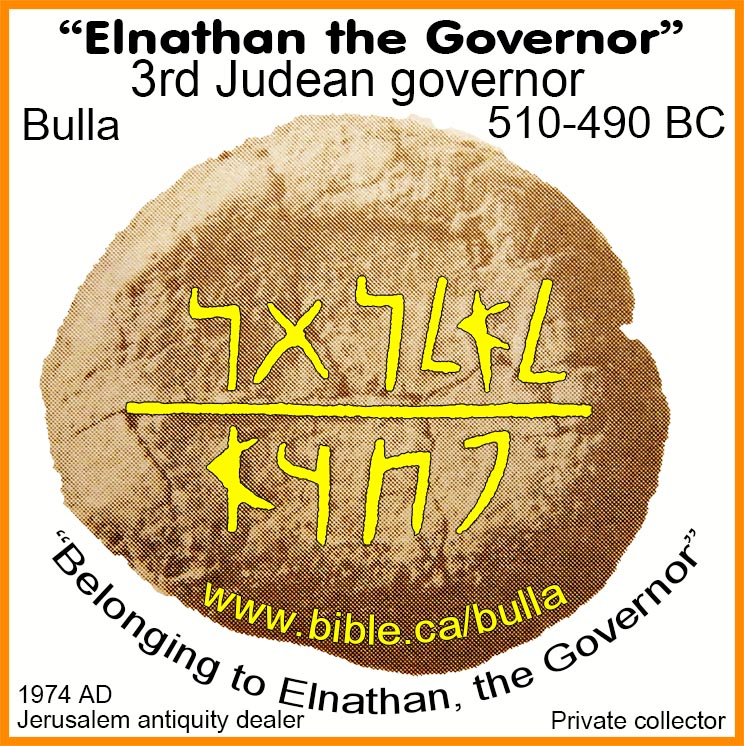
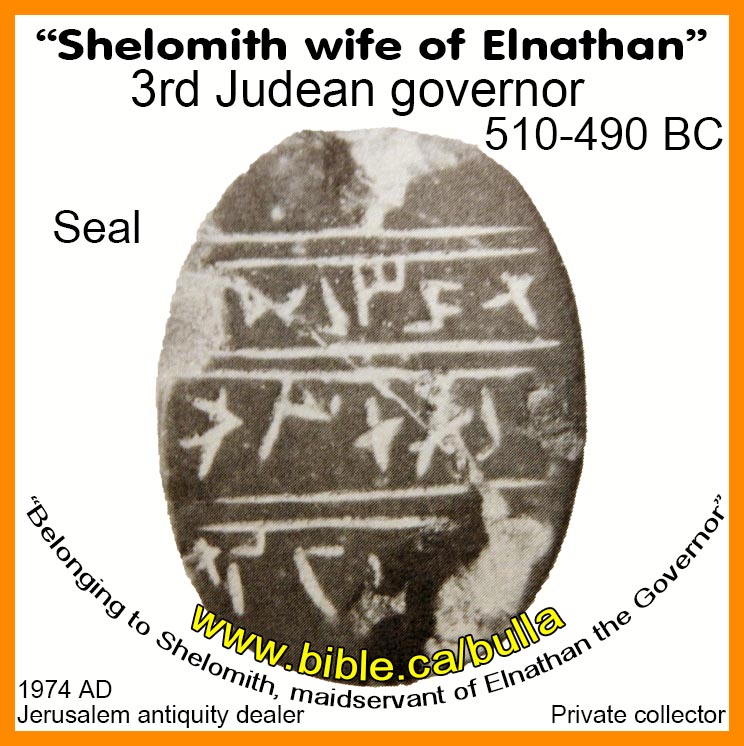

- Yehoʿezer: The forth governor: 490-470 BC
- Archeology has found a jar handle stamp impression with "phwʾ" on it and his name: “Yeho’ezer the Governor”
- He is not mentioned in the Bible
- However, excavations at Ramat Rachel in 1930 AD uncovered: "Another 130 seal impressions on jar handles found this season bring the total to 400. About 50 belong to the Iron Age and the rest to the Persian period" (Excavations at Ramat Racḥel, Yohanan Aharoni, Biblical Archaeologist, Vol 24, 1961 AD)
- Ahzai: The fifth governor: 470-460 BC
- Archeology has found a jar impression with "phwʾ" on it.
- Nehemiah: The Seventh governor: First term: 445-433 BC (20th -32nd year of Artaxerxes I who reigned 464-424BC) Second term: 429-? BC
- Ezra: Arrives in Jerusalem in 458 BC in the 7th year of Artaxerxes I, which is 13 years before Nehemiah arrives in 445 BC
- "Moreover, from the day that I [Nehemiah who is writing the book] was appointed to be their governor in the land of Judah, from the twentieth year to the thirty-second year of King Artaxerxes, for twelve years, neither I nor my kinsmen have eaten the governor’s food allowance. But the former governors who were before me laid burdens on the people and took from them bread and wine besides forty shekels of silver; even their servants domineered the people. But I did not do so because of the fear of God." (Nehemiah 5:14–15)
- "Then Nehemiah, who was the governor, and Ezra the priest and scribe, and the Levites who taught the people said to all the people, “This day is holy to the Lord your God; do not mourn or weep.” For all the people were weeping when they heard the words of the law." (Nehemiah 8:9)
- Sanballat and Tobiah opposed Nehemiah in 445 BC in Neh 2:10
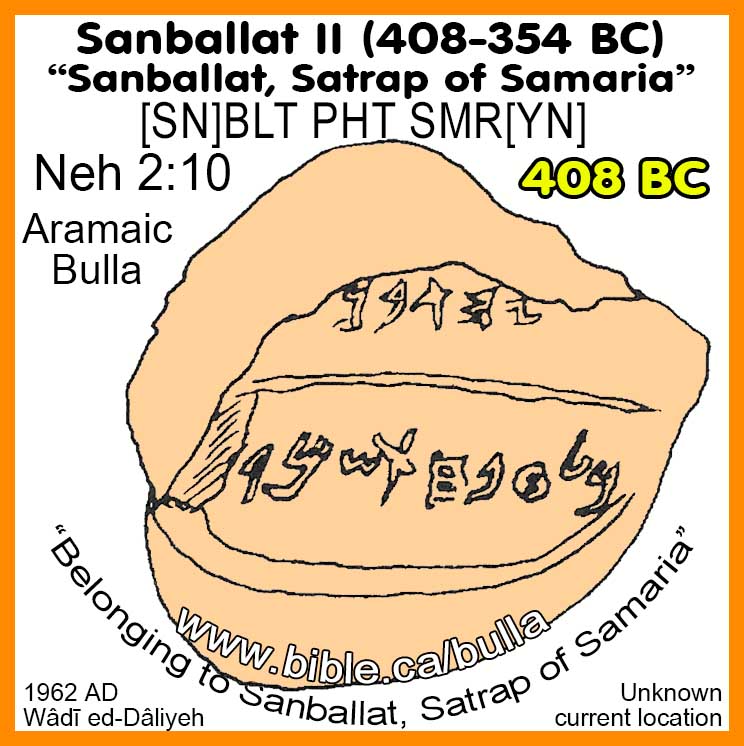
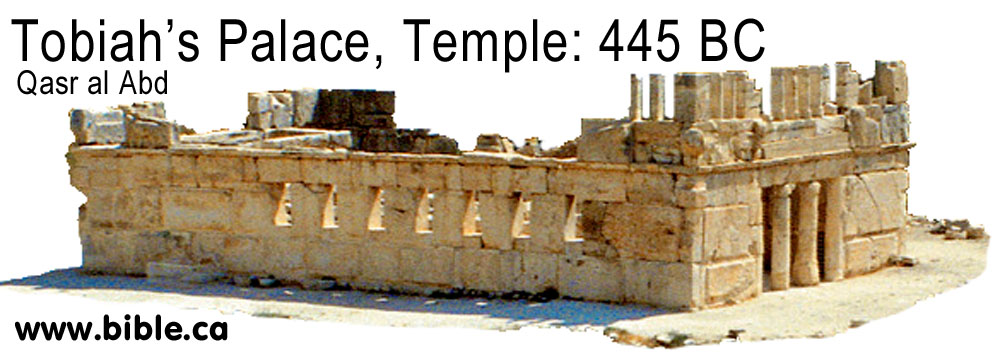
- "Aramaic dedication inscription of
Qaynu son of Gashmu, king of Qedar, on a silver bowl from Tell
el-Mashkhuta, Egypt. Four of the silver bowls bear Aramaic dedicatory
inscriptions to the goddess Han-Ilat. One of the inscriptions reads:
“That which Qaynu, son of Gashmu, king of Qedar, brought in offering to
Han-Ilat.” An analysis of the bowls and their inscriptions has led
scholars to conclude that the Gashmu mentioned in the inscription is the
very same Gashmu (or Geshem) mentioned in Nehemiah 2:19, 6:1,2,6."
(Gashmu, Nehemiah’s Adversary , Bible and Spade, Vol 1, No 3, p82, 1972
AD)
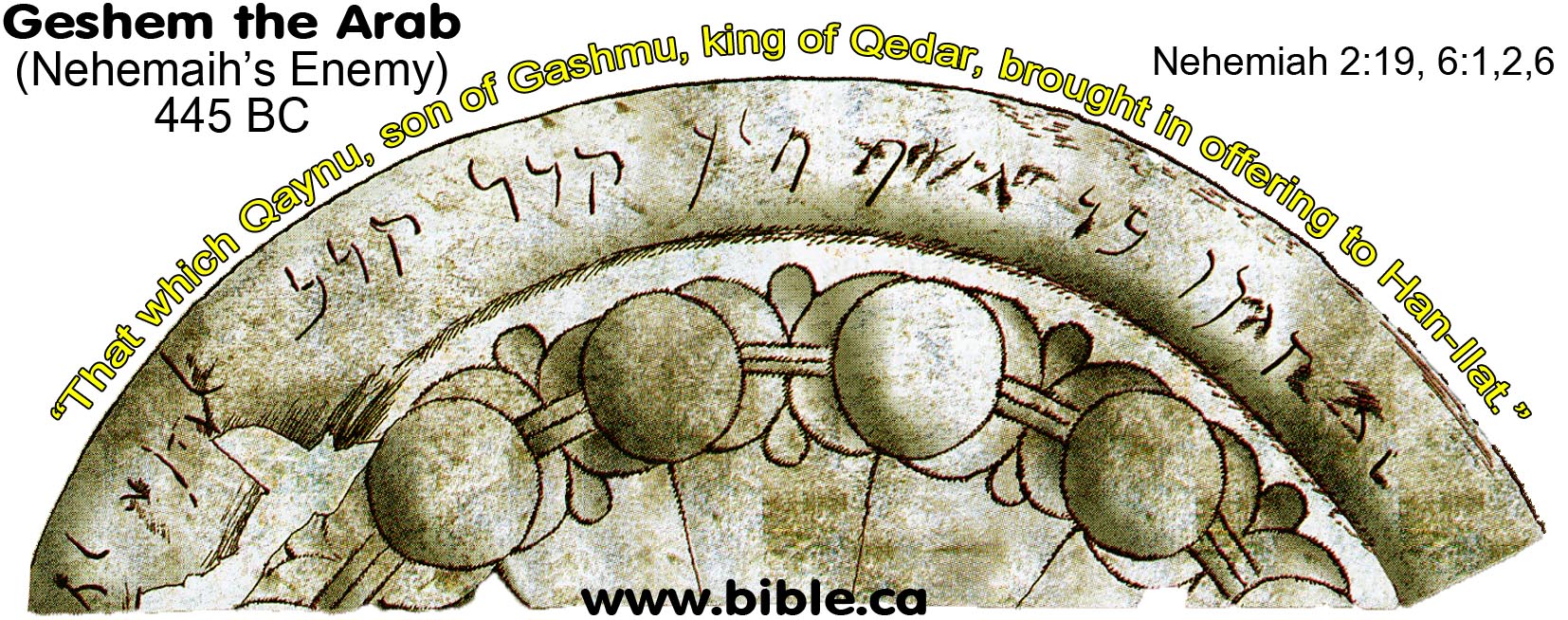
- Bagohi: The sixth governor: 409 BC
- Archeology has found the Persian Elephantine Papyus with "Bagohi the satrap of Judah" and "Sanballat satrap of Samaria" in the text of the same "Temple Papyri" letter.
- This is the only reference to Bagohi we have and we would not know about him if we did not have the 28 Elephantine Papyrus discovered in 1904 BC
- More on the
Elephantine Papyrus.
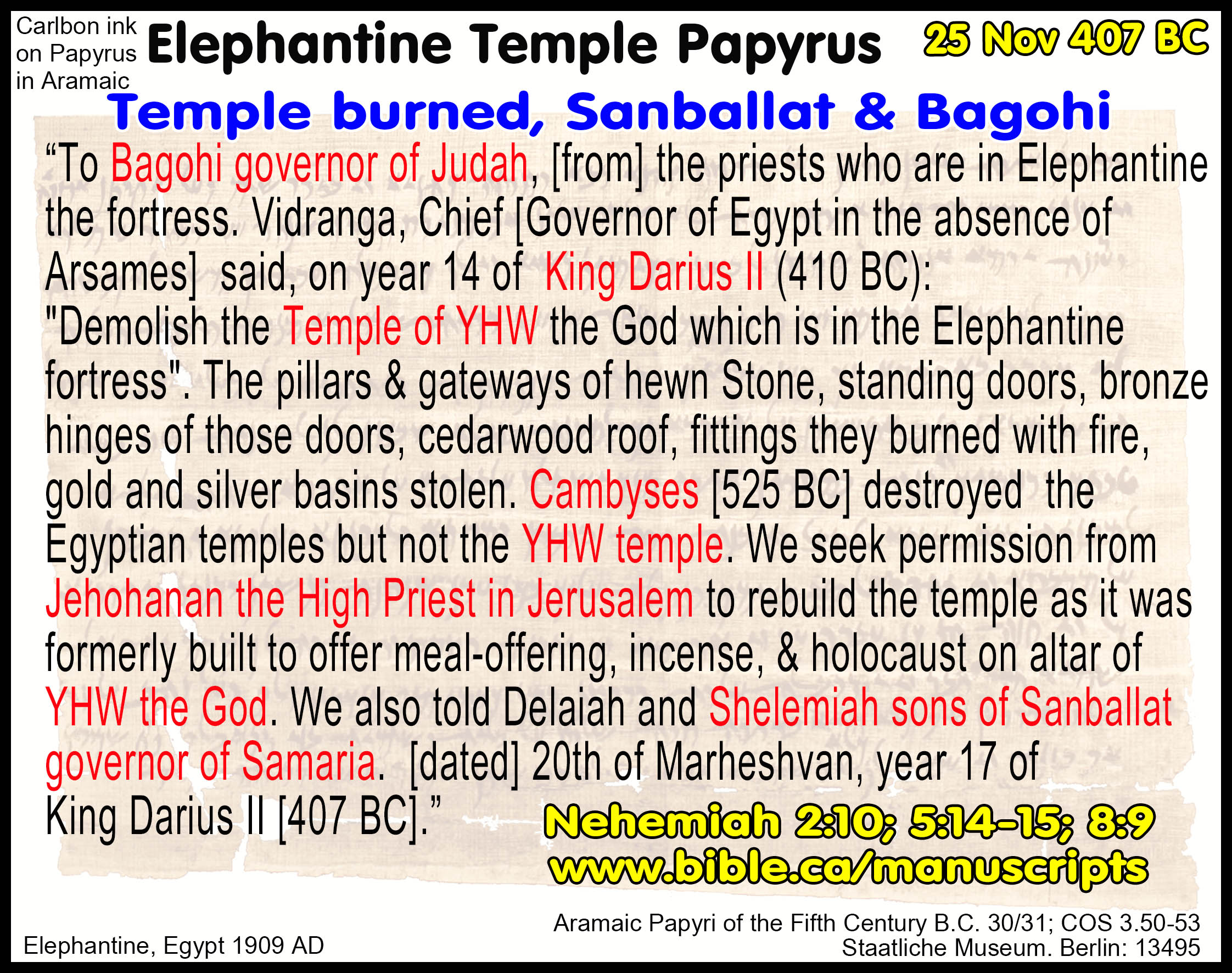
- "Hezekiah": Governor of Judea: 350-302 BC
- Hezekiah was the last governor of the Persian Empire and governed after Alexander the Great started the Greek empire in 333BC.
- Hezekiah, therefore, is unique in that he governed Judea through the transitional period between the Persian and Greek empires.
- Archeology has found two coins with his name as governor.
- We know about him only through coins he minted
- Some coins contained the full inscription naming Hezekiah as the governor: "YHZQKYH HPHH" (Yehezqiyah the Satrap) (Meshorer: Coins 22-23);
- Others, like this one, "YHZQYH" (Yehezqiyah) (Meshorer: Coins 24-26) only mention Hezekiah without the PHH (Hebrew: Peheh)
- See the page on Yehezqiyah
"Hezekiah" for more details on his coin!
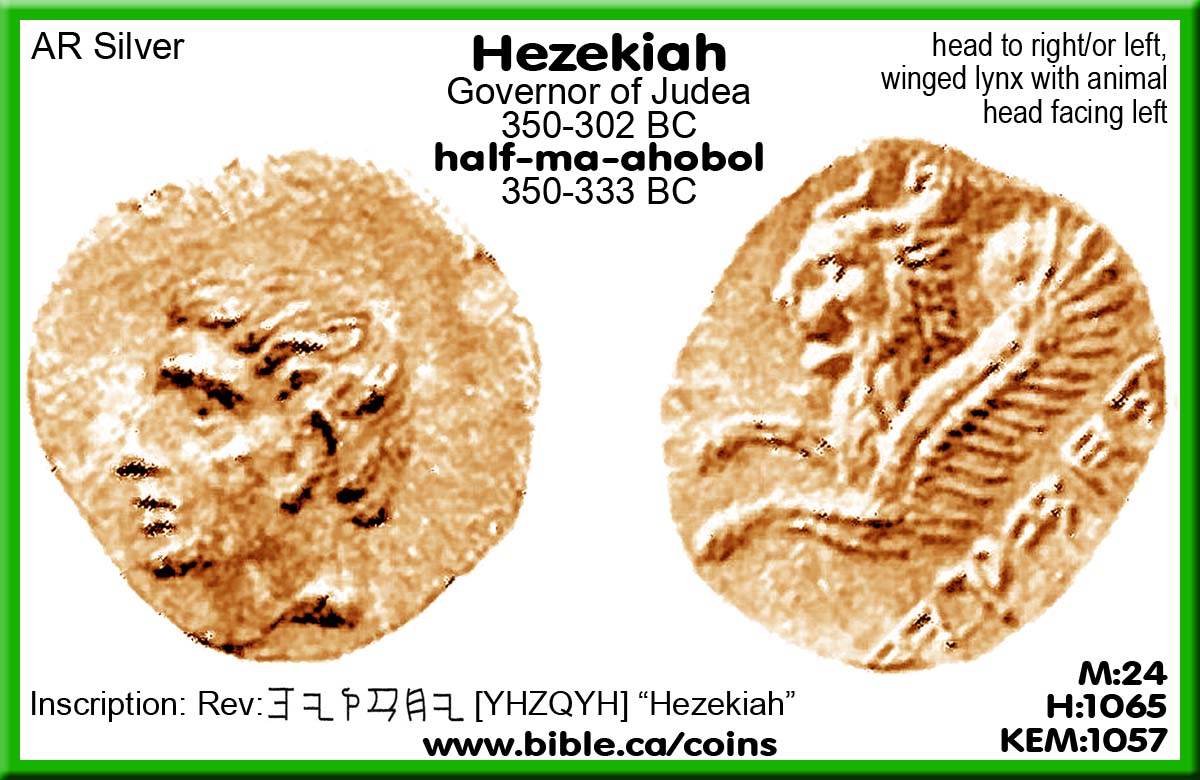
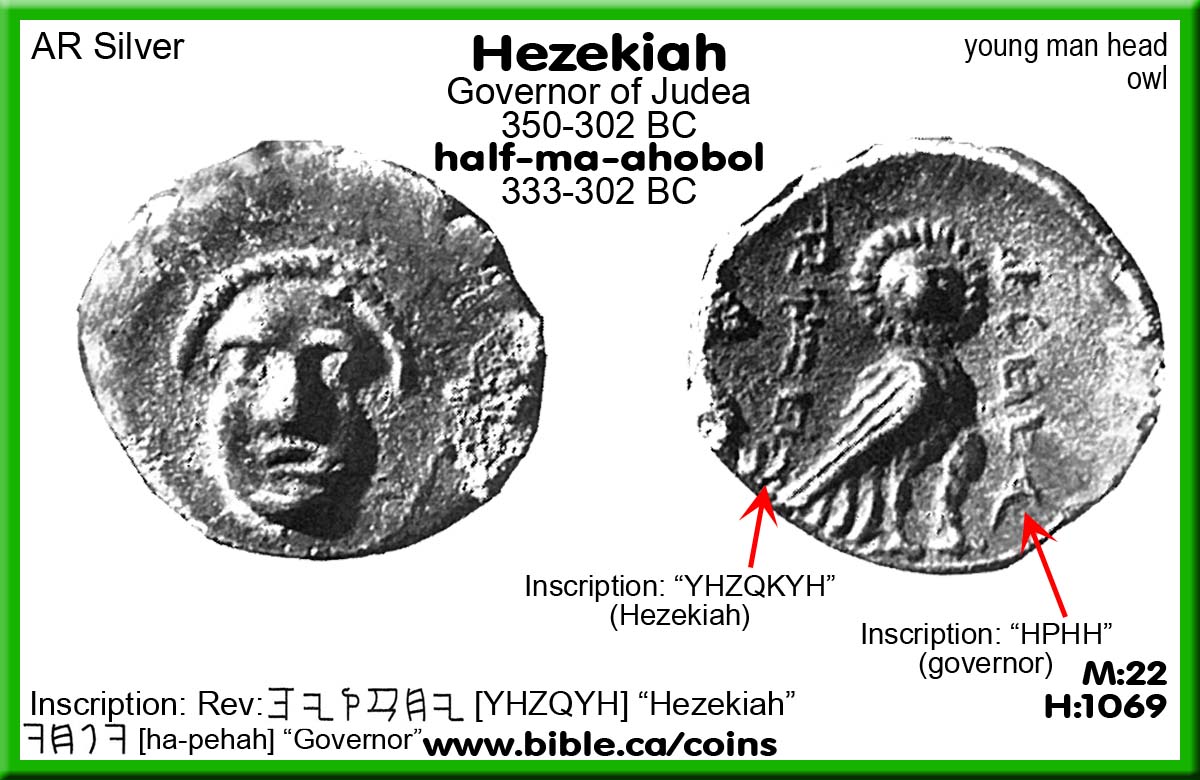
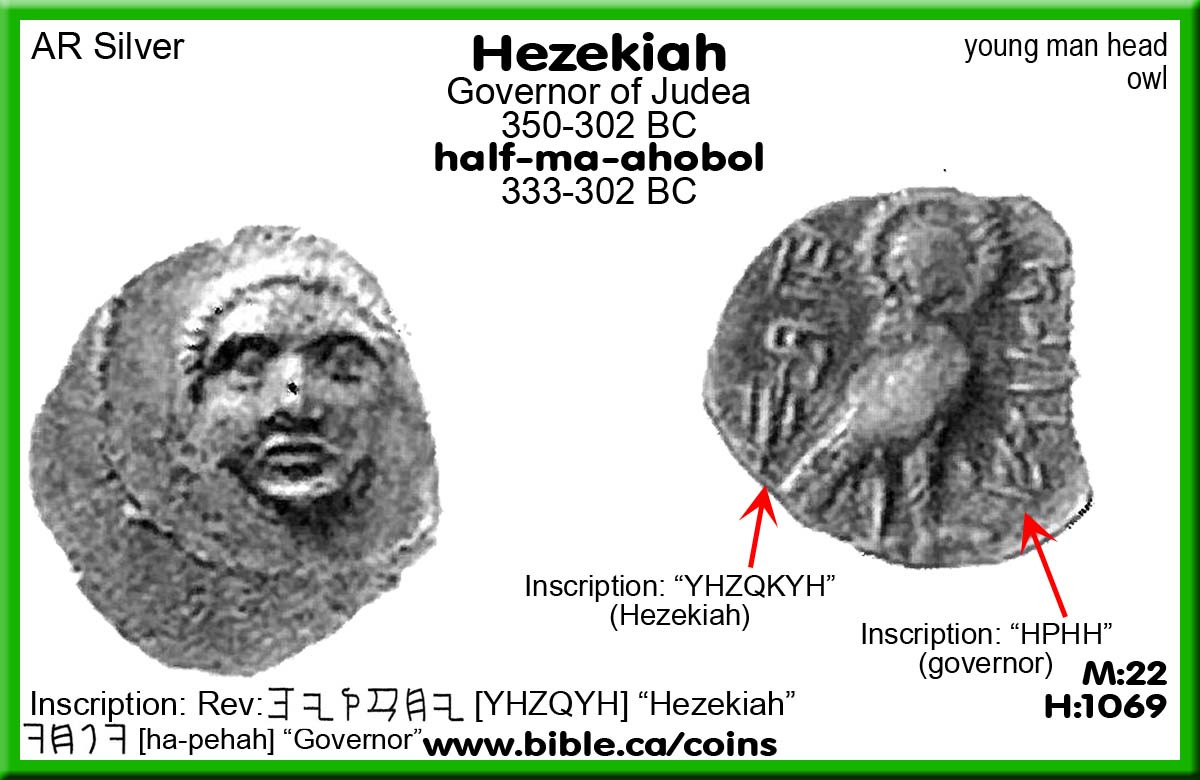
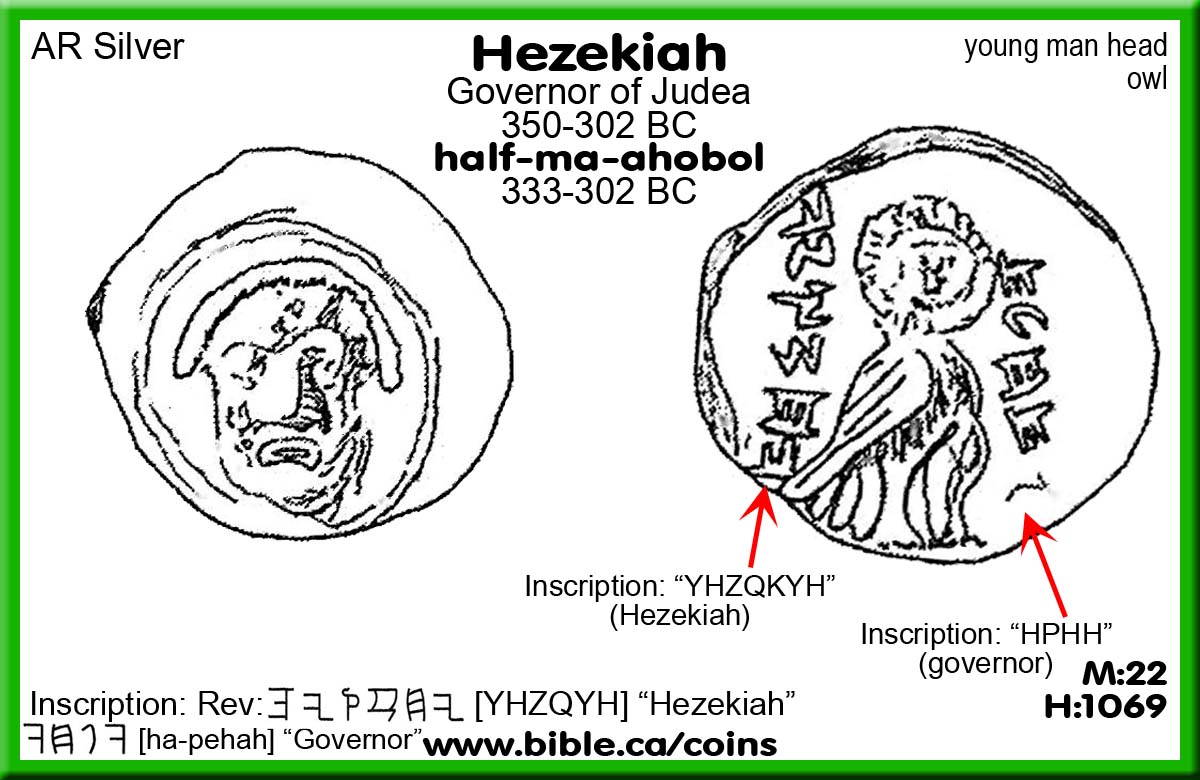
III. Hasmonean Governors and kings: a period of short Judean independence
Hasmonean rulers and kings click here.
For full details on the Hasmonean rulers and Kings click here.
- 175-163 Antiochus IV Epiphanes (Seleucid king)
- 167 Antiochus IV desecrates Temple
- 166 Revolt of Mattathias. dies 166: 1 Macc. 1,2; 2 Macc. 6; Jos Ant. 7:265-272
- 166-160 Judas Maccabeus (1 Macc. 3-4; Jos Ant. 7:287-292)
- 164 Temple liberated. Hanukkah started: Jn 10:22
- 160-143 Jonathan (1 Macc. 9-10; Jos. Ant. 8:46-212)
- 143-135 Simeon, 1 Macc 13-14; Jos Ant. 8:218-228; Wars 1:50-60
- 135-104 John Hyrcanus I, Jos Ant. 8:228-299; Wars 1:61-69
- 125 Tyre liberated from Seleucids. Tyrian Shekel Year 1
- 110 Full Judean independence from Seleucids
- 104-103 Aristobulus I: Jos Ant. 8:301-319; Wars 1:70-84
- 103-76 Alexander Janneus, Jos Ant. 8:320-406; Wars 1:85-106
- 76-67 Hyrcanus II (Salome Alexandra) Jos Ant. 8:399-432; Wars 1:107-119,270
- 67-63 Aristobulus II, Jos Ant. 14:4-28; Wars 1:120-126
- 64 Roman general Pompey the Great Annexes Syria
- 63 Roman General Pompey captures Jerusalem and reappoints Hyrcranus II as high priest. Jos Ant. 14:4-28; Wars 1:120-126
- 63 Hyrcanus II repointed high priest. Jos Ant. 14:4-28; Wars 1:120-126
- 49 Julius Caesar crosses the Rubicon river, becomes dictator
- 44 Julius Caesar murdered
- 40-37 Antigonus II, Jos Ant. 14:335-480; Wars 1:250-357
- 37 Aristobulus III briefly appointed High Priest
- 40-36 Hycranus II exiled to Parthia
- 35 Hycranus II lives with Babylonian Jews
- 36 Mark Antony kills Antigonus, ending Hasomean rule
- 31Octavian (Augustus) defeats Mark Antony and Cleopatra in Battle of Actium
- 30 Herod executes Hycranus II after inviting him home to Jerusalem
- 30 BC Judah’s independent rule ends under Roman control when Herod ends Hasmonean dynasty by killing Hycranus II, the last living Hasmonean Judean Governor.
IV. Roman appointed Governors of Judea:
A. List of Judean governors appointed by the Romans:
- Judean Governor Archelaus 1 BC-6AD
- Joseph moves from Egypt to Nazareth
- under Governor Antipas: Mt 2:22
- Judean Governor Coponius 6-9 AD
- Judean Governor Marcus Ambibulus 9-12 AD
- Judean Governor Annius Rufus 12-15 AD
- Judean Governor Valerius Gratus 15-26 AD
- Judean Governor Pontius Pilate 26-36 AD
- Jesus begins to proclaim gospel (Luke 3:23) 30AD
- Jesus Died 3 April 33 AD
- Judean Governor Marcellus 36-37 AD
- Judean Governor Marullus 37-41 AD
- Ababus predicts famine: 40 AD (Acts 11:28; Jos. Ant. 20.100-101)
- Judean Governor Cuspius Fadus 44-46 AD
- Governor Tiberius Alexander 46-48 AD
- Governor Cumanus 48-52 AD
- Governor Antonius Felix 52-57 AD
- Paul before Felix, imprisoned 2 years (Acts 24) 55-57 AD
- Judean Governor Porcius Festus 57-62 AD
- Judean Governor Albinus 62-64 AD
- Judean Governor Gessius Florus 64-66 AD
- 1st Jewish War: The Great Revolt 66-70 AD
- Jerusalem and Temple destroyed: 70 AD Lk 21:20; Mt 24:1:14
- Jewish Rebellion in diaspora in Egypt
- Alexandria, Cyrene Cyrenaica, Cyprus
- (under Trajan )116-117 AD
- 2rd Jewish War, Bar-Kokhba Revolt 132-135AD
- 135 Hadrian expels Jews, renames Jerusalem Aelia Capitolina and renames Judah “Palestine” (after the Philistines), builds temple of Jupiter on Temple Mount.
B. Emperors of the Roman Empire: for details click here
- 49-44 Julius Caesar (Emperor 1) crosses the Rubicon river, becomes dictator
- 31 Octavian (Augustus) defeats Antony in Battle of Actium becomes emperor 31 BC - 14 AD
- 14-37 Caesar Tiberius
- 37-41 Caesar Caligula
- 41-54 Caesar Claudius
- 54-68 Caesar Nero (Nron Qsr = “666”, Greek transliterated into Hebrew)
- 69 Caesars (3) Galba, Otho, Vitellius
- 69-79 Caesar Vespasian
- 79-81 Caesar Titus
- 81-96 Caesar Domitian
- 138-161 Caesar Antoninus Pius
C. Chronological account of New Testament and Roman events
49 Julius Caesar (Emperor 1) crosses the Rubicon river, becomes dictator
44 Julius Caesar murdered. Octavian is Julius’ only heir
36 Mark Antony kills Antigonus, ending Hasmonean rule
31 Octavian (Augustus) defeats Antony in Battle of Actium becomes emperor 31 BC - 14 AD
30 Antony & Cleopatra commit suicide ending Ptolemaic rule
23 Caesar Octavian (Augustus) given tribunician powers (Second Settlement)
20 Herod begins building temple: Jos. Ant. 15.380
12 Augustus given title “pontifex maximus” (Highest religious position)
12 Temple precincts completed: Jos. Ant. 15.420
7 Aristobulus dies
4 Antipater poisons Pheroas, Antipater executed.
4 Archelaus, Antipas and Philip begin as administrators, co-regents.
1 BC Lunar Eclipse 10 January; Herod Slaughters Babies
1 BC Herod the Great dies: Antiquities 17.167-181
1 BC Archelaus, Antipas, Philip II succeed Herod as Tetrarchs: Lk 3:1
1 BC Archelaus 1BC-6AD Judea
1 BC Antipas 1BC-39AD Galilee Perea
1 BC Philip II 1BC-34AD Panea, Ituraea, Trachonitis, Lysanias
Jesus in Jerusalem temple age 12: Lk 2:42
14-37 Caesar Tiberius
29 John the Baptist begins preaching: Lk 3:1
32 Herod Antipas, Galilean Governor, beheads John: Mt 14:3
37-41 Caesar Caligula
37-43 King Herod Agrippa I, given territory of Philip II by Caligula
39 King Herod Agrippa I, given territory of Antipas by Caligula
41-54 Caesar Claudius, gives Agrippa I all lands Herod the Great ruled
43 King Herod Agrippa I, kills James, dies of worms: Acts 12 (Because his son, Agrippa II is 17 year old, the territory given to Cuspius Fadus in 44 AD)
49-100 Herod Agrippa II becomes king, territory of Agrippa I
49 Jerusalem council, Paul’s 2nd Journey: Acts 15
54-68 Caesar Nero (Nron Qsr = “666”, Greek transliterated into Hebrew)
57 Paul before Festus & Agrippa, sent to Rome: Acts 25-26
60 Paul leaves Rome: Acts 28:30
69 Caesars (3) Galba, Otho, Vitellius
69-79 Caesar Vespasian
70 Titus destroys Temple on the same day Nebuchadnezzar did same in 587 BC on 10th Ab. (Jer 52:12-13; Jos. Wars 6.250)
King Agrippa II buys a copy of Josephus’ book “Wars”: Apion 1.51
79-81 Caesar Titus
81-96 Caesar Domitian
138-161 Caesar Antoninus Pius
D. Coins of the Roman Period Judean Governors:
- Herod the Great (39 BC - 1 BC)
- Herodian Chronological notes on the birth of Jesus in 1 BC. Three common mistakes are made in the Herodian timeline that we have fixed:
i. The date for the death of Herod the Great is 1BC not 4 BC. According to Josephus, Herod reigned 37 years counting from his appointment by the Mark Antony and the Roman Senate, or 34 years counting from his conquest of Jerusalem. Josephus dates the first of these events in two ways: by the Roman consular date and by the Greek 184th Olympiad. However, Appian's history (Civil Wars 5.8.75) places Herod's appointment in the next consular year, as does the history of Antony as recorded by Josephus himself. Seeking to resolve these contradictory statements, we read that Josephus says elsewhere that the government of the Hashmoneans, which started in 162 BC, lasted 126 years until Antigonus was defeated by Herod in the conquest of Jerusalem. Herod’s victory was thus in (162 – 126) = 36 BC, in exact agreement with another passage in Josephus that places Herod's taking of Jerusalem 27 years to the day after the city fell to Pompey, which was on the Day of Atonement, 63 BC. The 34 years from the capture of Jerusalem thus ended in 36 – 34 = 2, i.e. the regnal year that began in the fall of 2 BC and extended to the fall of 1 BC. All of these figures work out exactly if Herod was appointed by the Romans in 39 BC, captured Jerusalem on the Day of Atonement in 36 BC, and died in early 1 BC, i.e. shortly after the total lunar eclipse of January 10, 1 BC. None of these figures given by Josephus would be correct if Herod was appointed by the Romans in 40 BC, captured Jerusalem in 37 BC, and died in 5 or 4 BC, as maintained in the older, and now superseded, scholarship largely based on Emil Schürer's work over a hundred years ago.
ii. In failing to realize that Herod’s successors, Archelaus, Antipas & Philip II were co-regent with Herod 3 years before he died which was 4 BC. This explains why the first coins of Philip were dated “year 5”. He started minting in the second year of his sole reign after Herod died. In a strange co-incidence, the two errors have the effect of not changing the traditional dates for the END of their 3 reigns. So they began to function as administrative assistant governors in 4 BC and as “Caesar certified” governors (Tetrarchs) in 1 BC after the death of Herod.
iii. The 29 days between the partial lunar eclipse in 4 BC and Passover that year was insufficient time to accommodate all the events that Josephus describes related to the death of Herod, but there was sufficient time for them (89 days) between the full lunar eclipse of 10 January 1 BC and the Passover that year. (Rodger Young)
- Herod's only
silver coin: The shekel of Tyre minted in
Jerusalem: full
outline

- Herod the Great: Prutah 22-10 BC
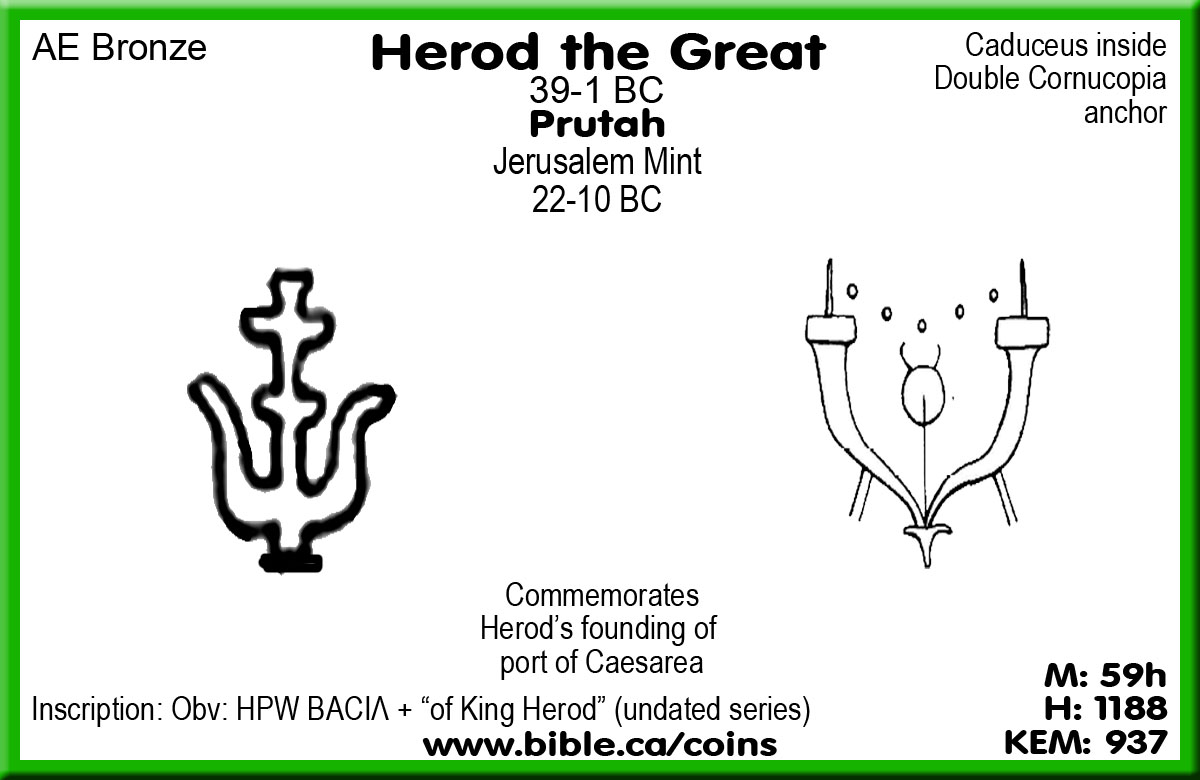
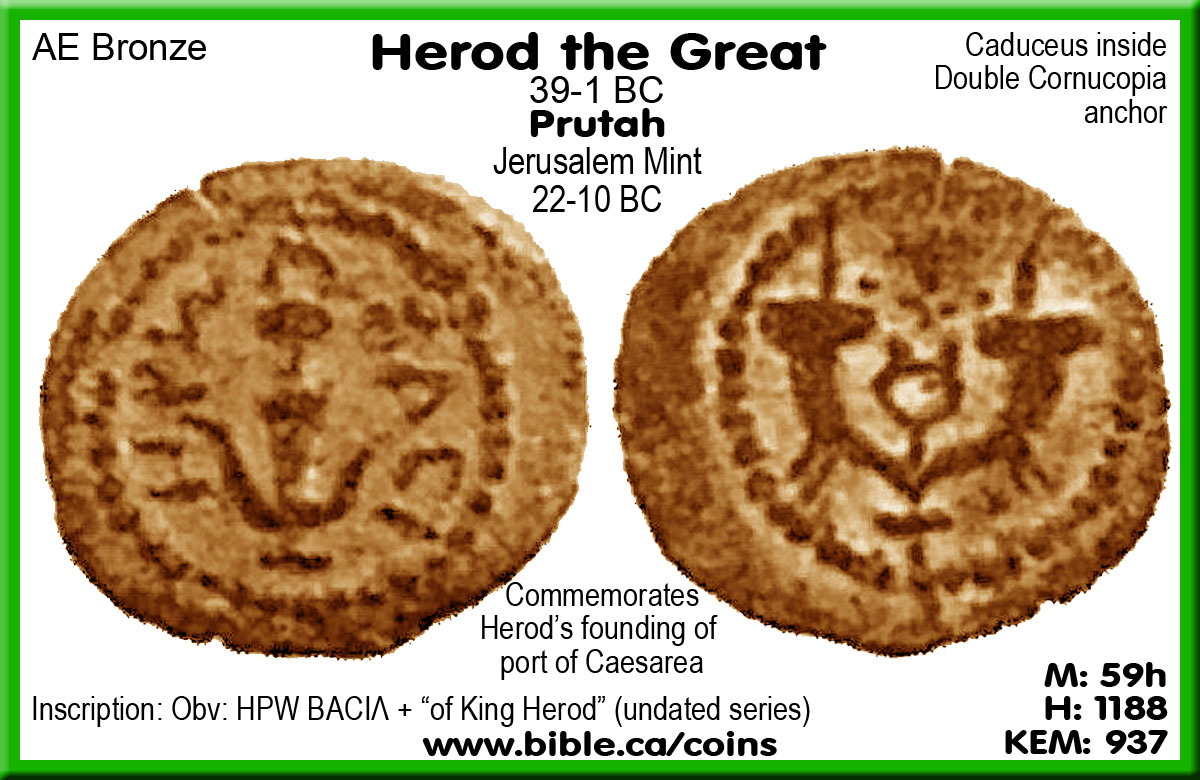
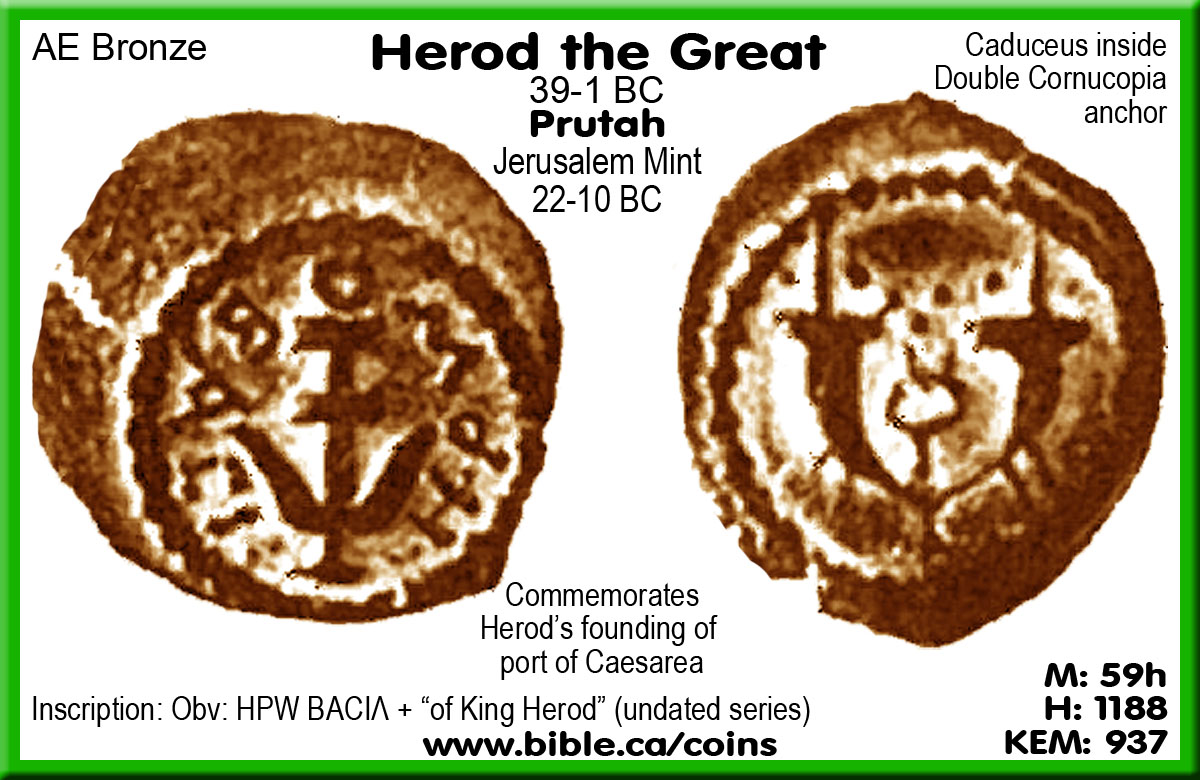
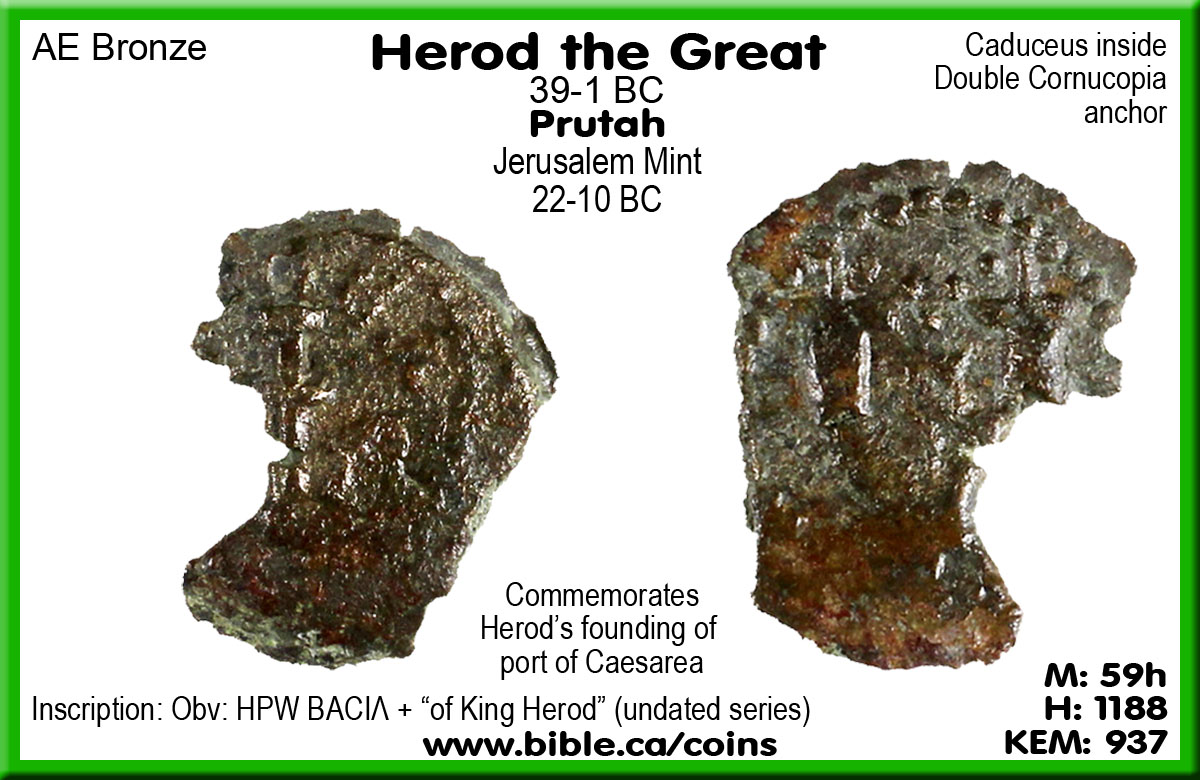
- Herod the Great: Prutah
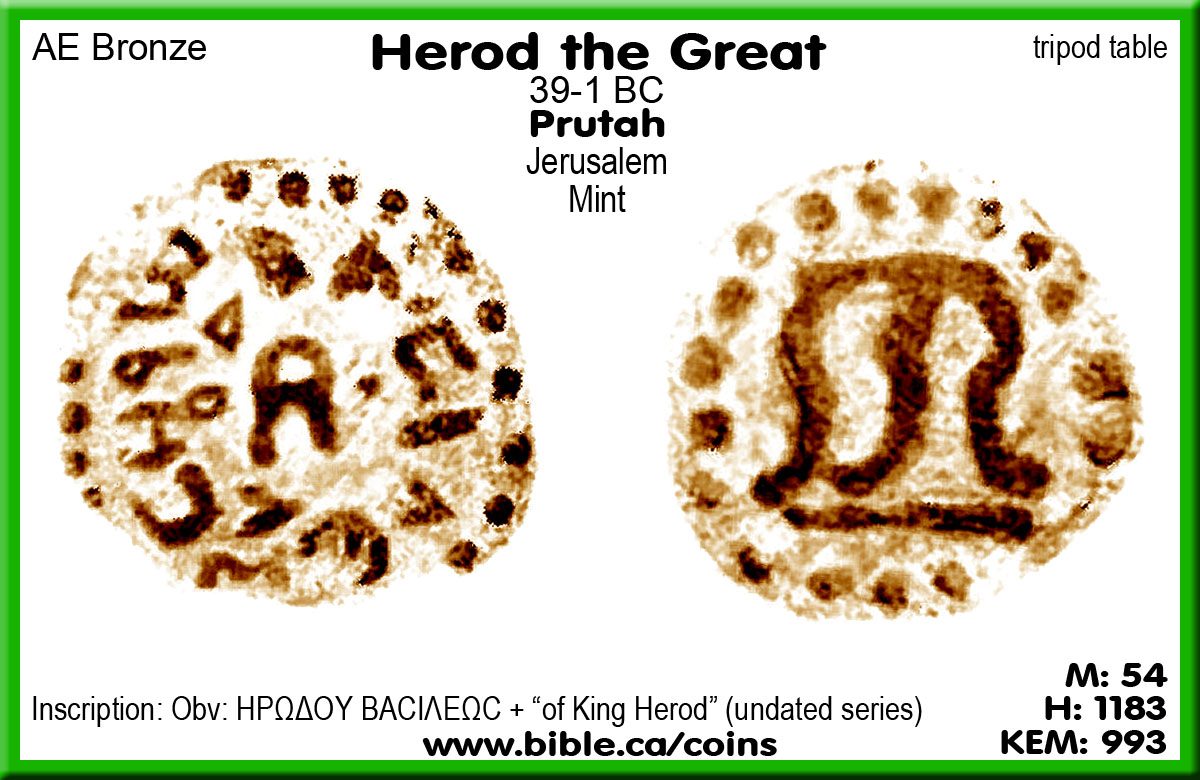
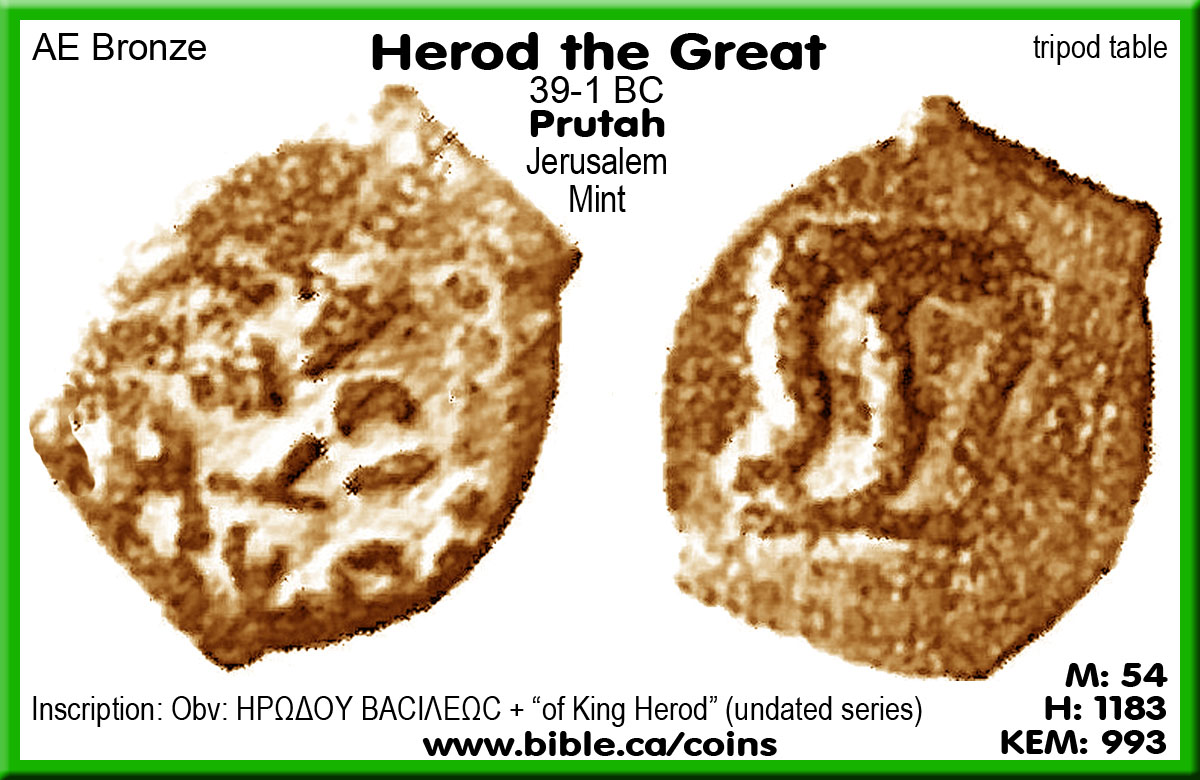
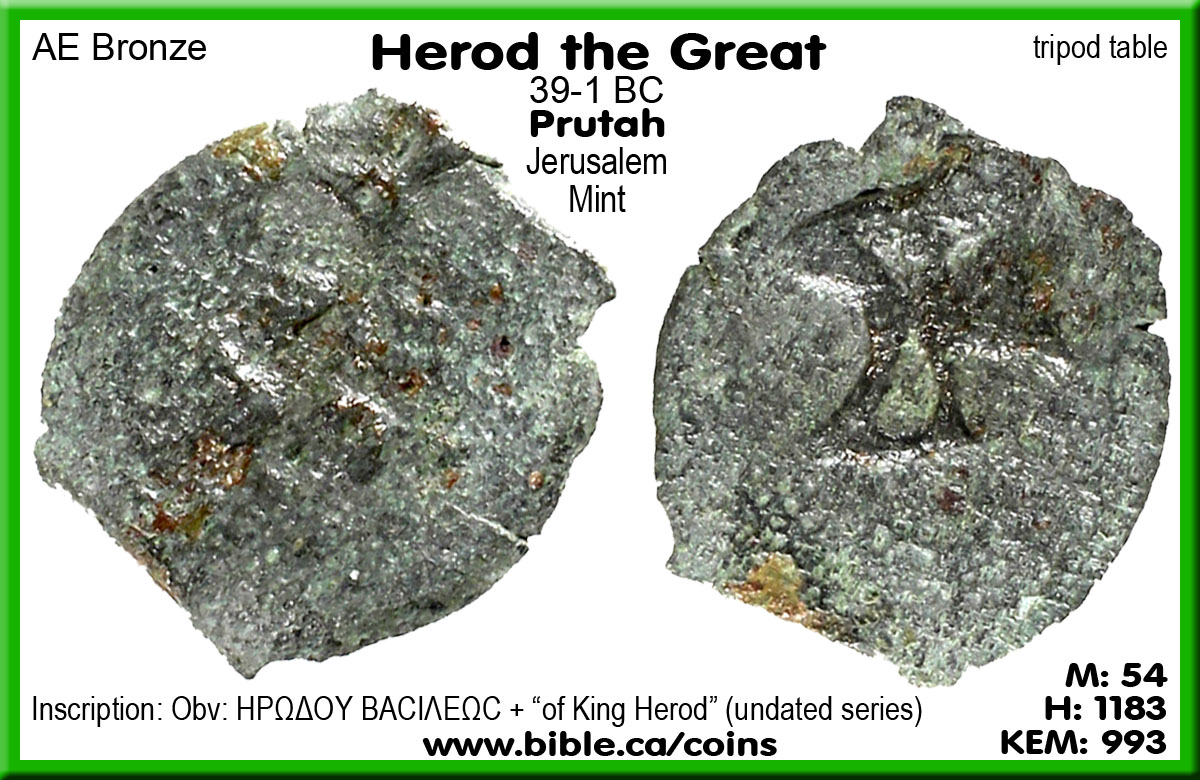
- Herod the Great: 2 Prutah
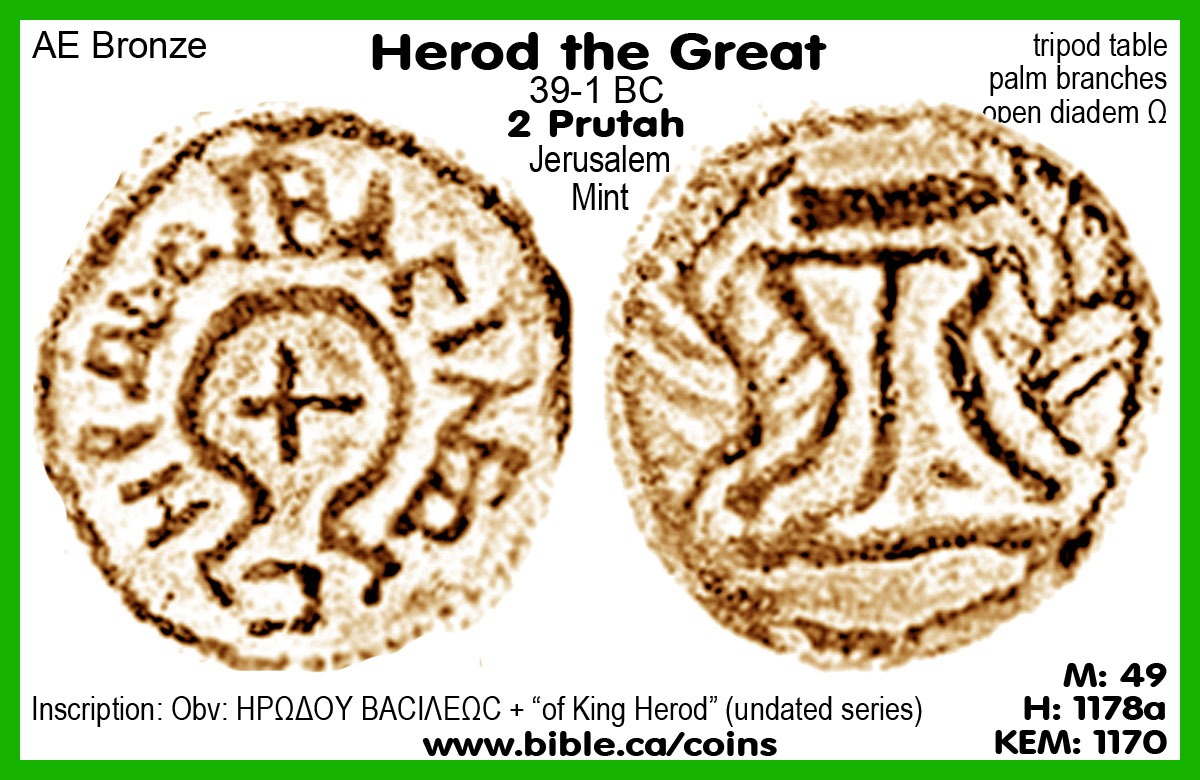
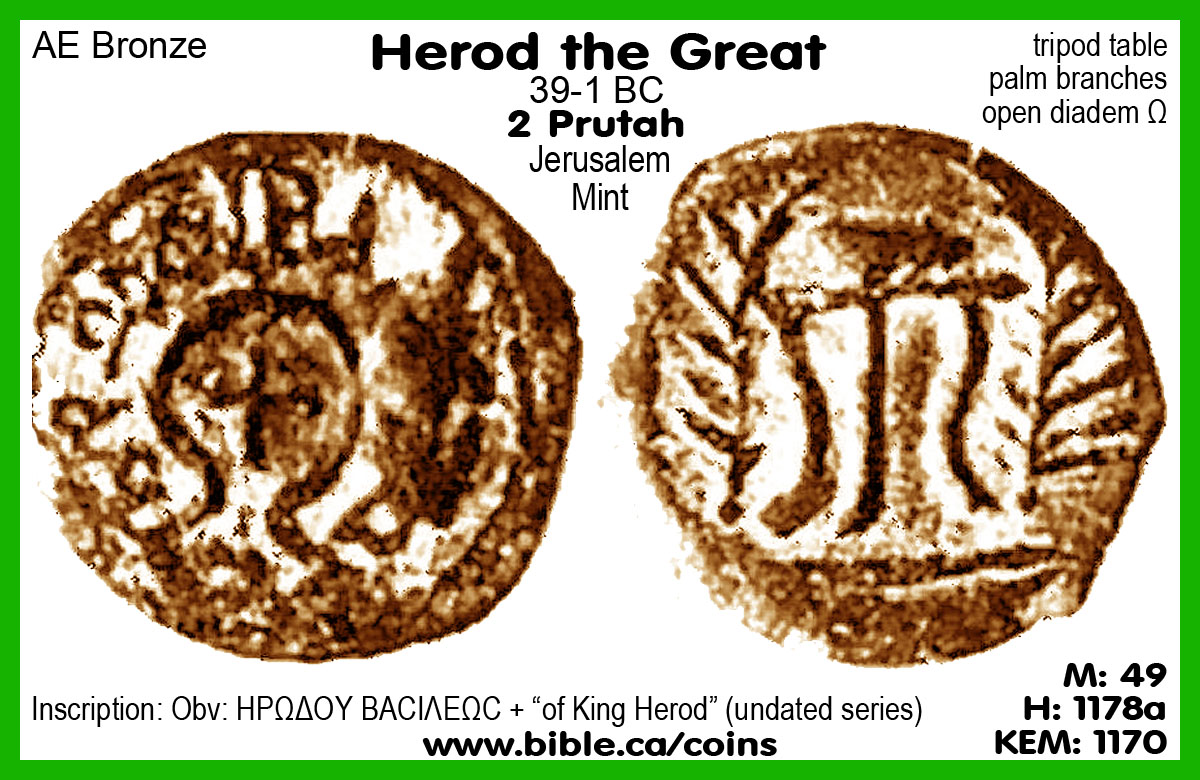
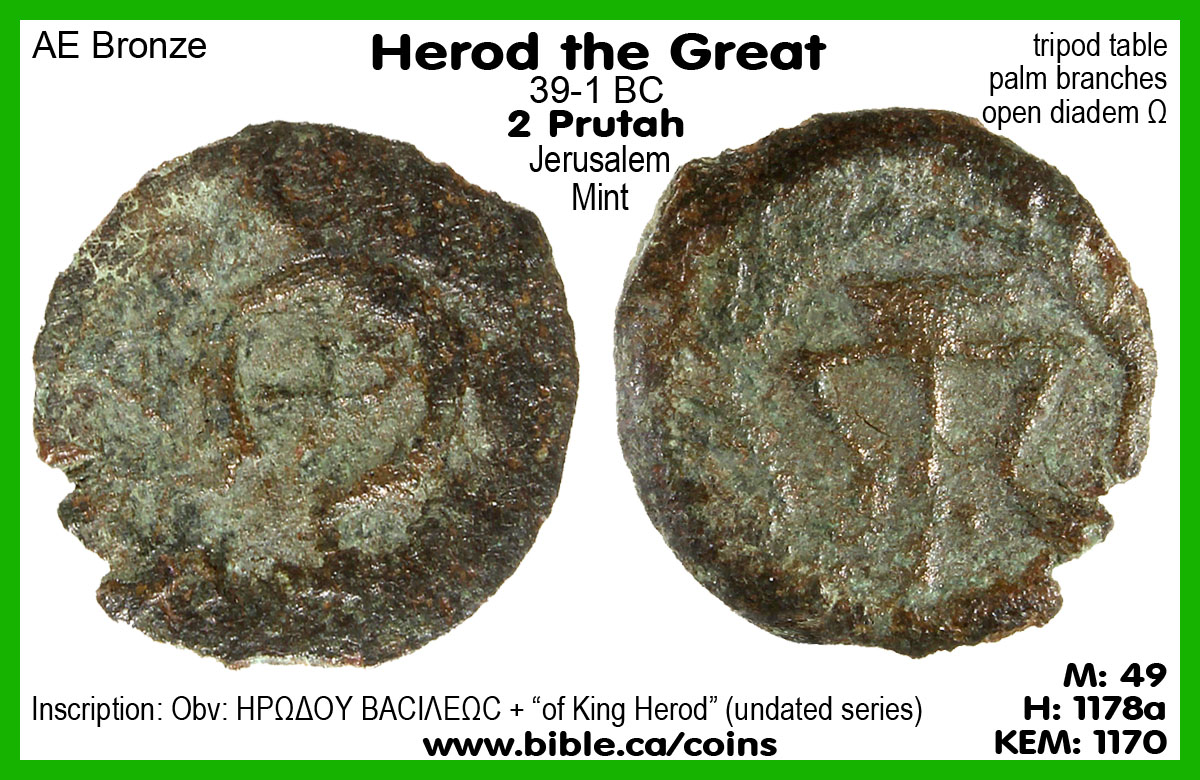
- Herod the Great: 4 Prutah
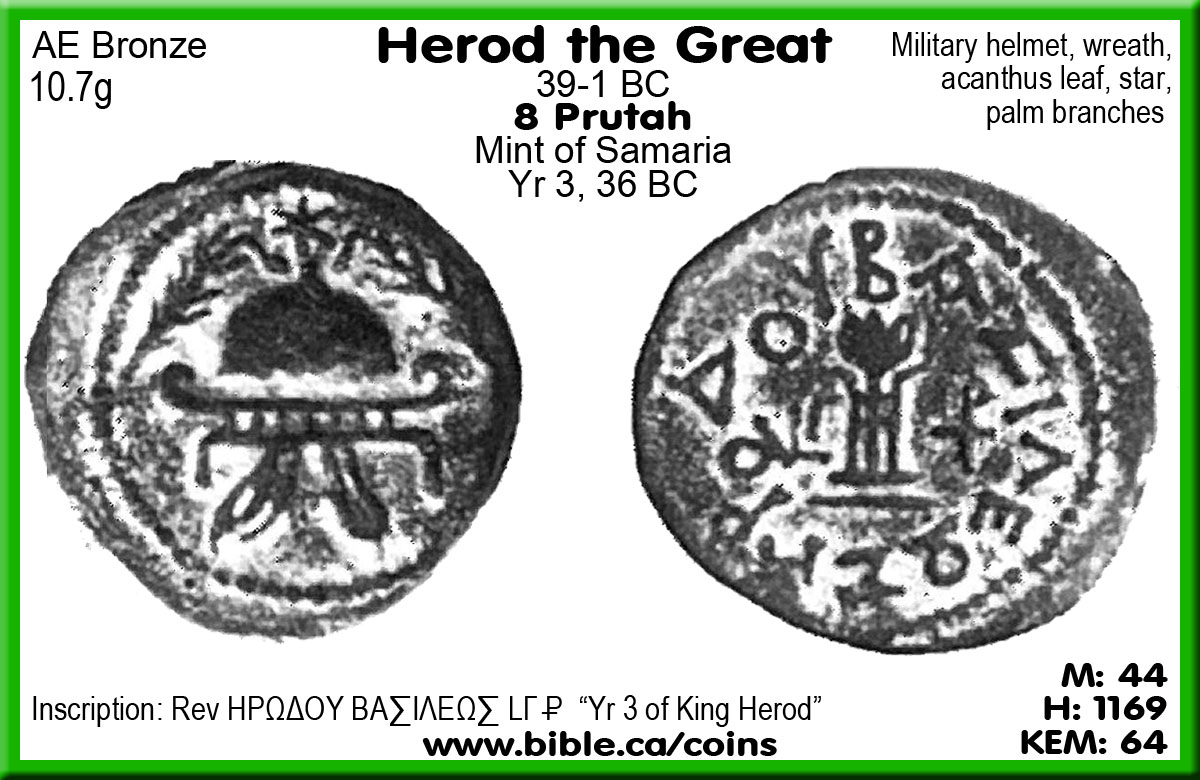
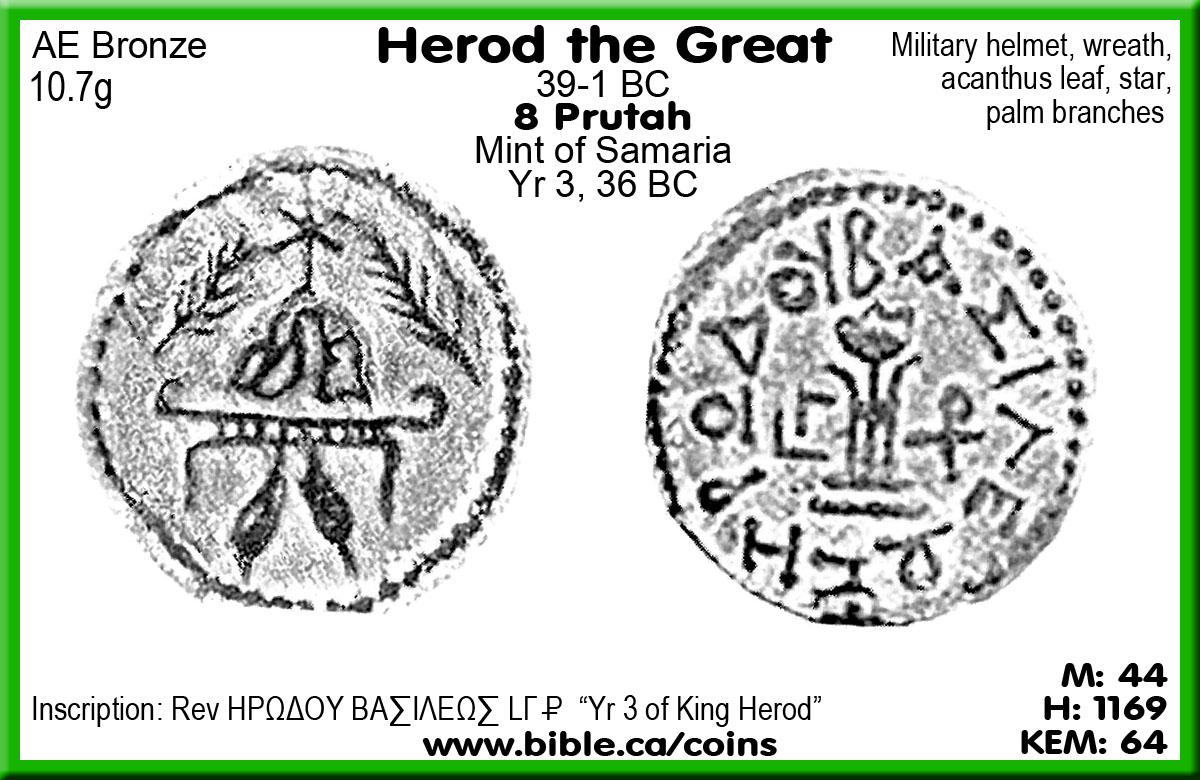
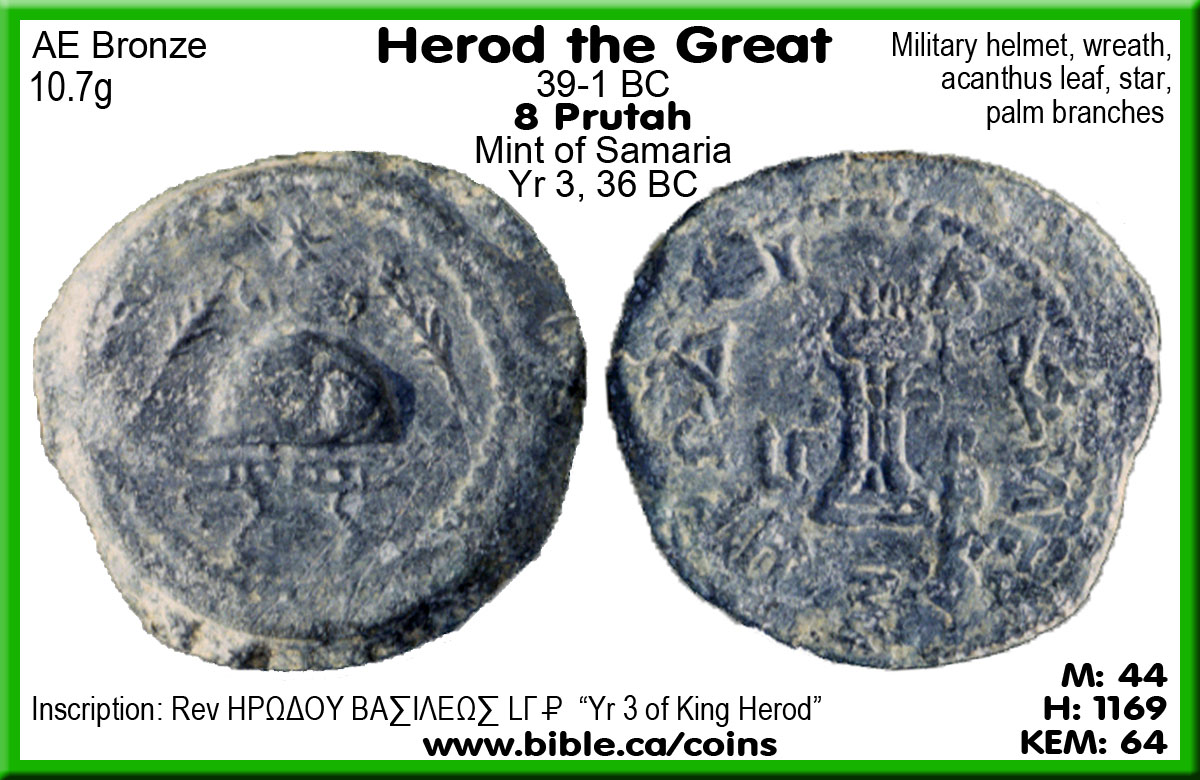
- Archelaus (1 BC - 6AD) COMING 2017
- Coponius (6-9 AD)
- Marcus Ambibulus (9-12 AD)
- Coins of Marcus Ambibulus: Prutah Year 39 of Augustus: 9 AD
Marcus Ambibulus:
Prutah Year 40 of Augustus: 10 AD
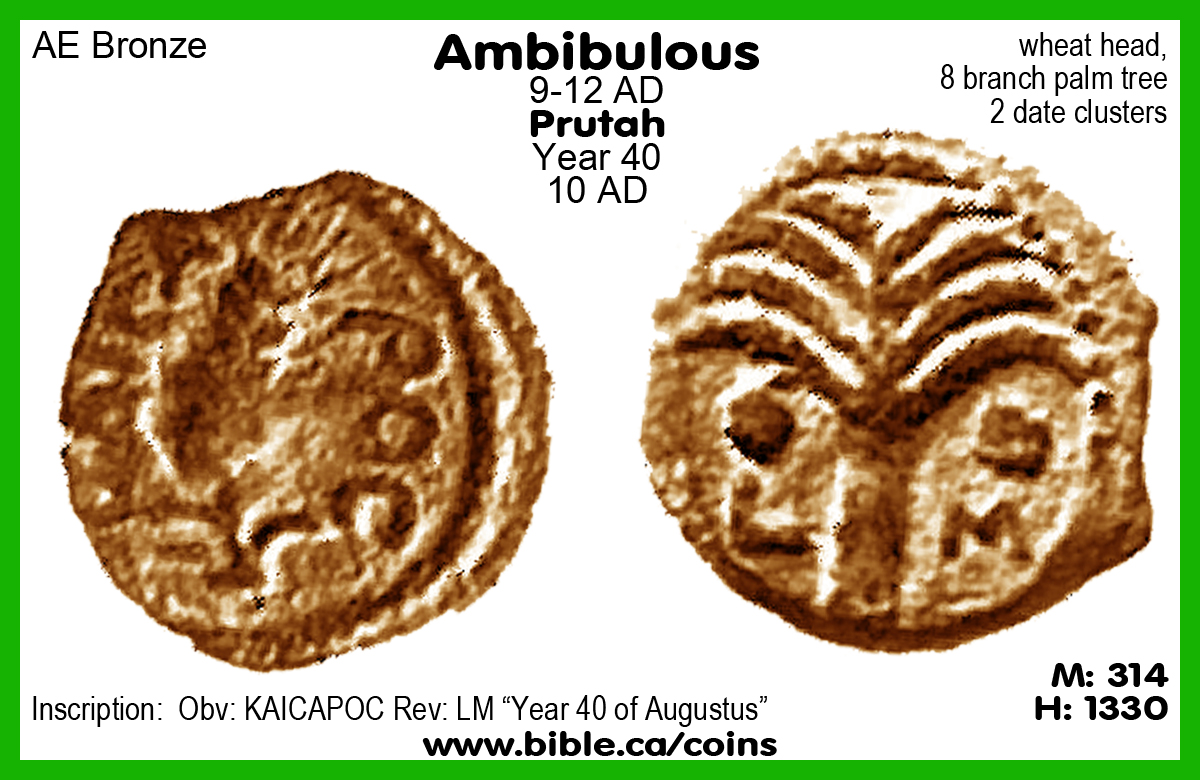
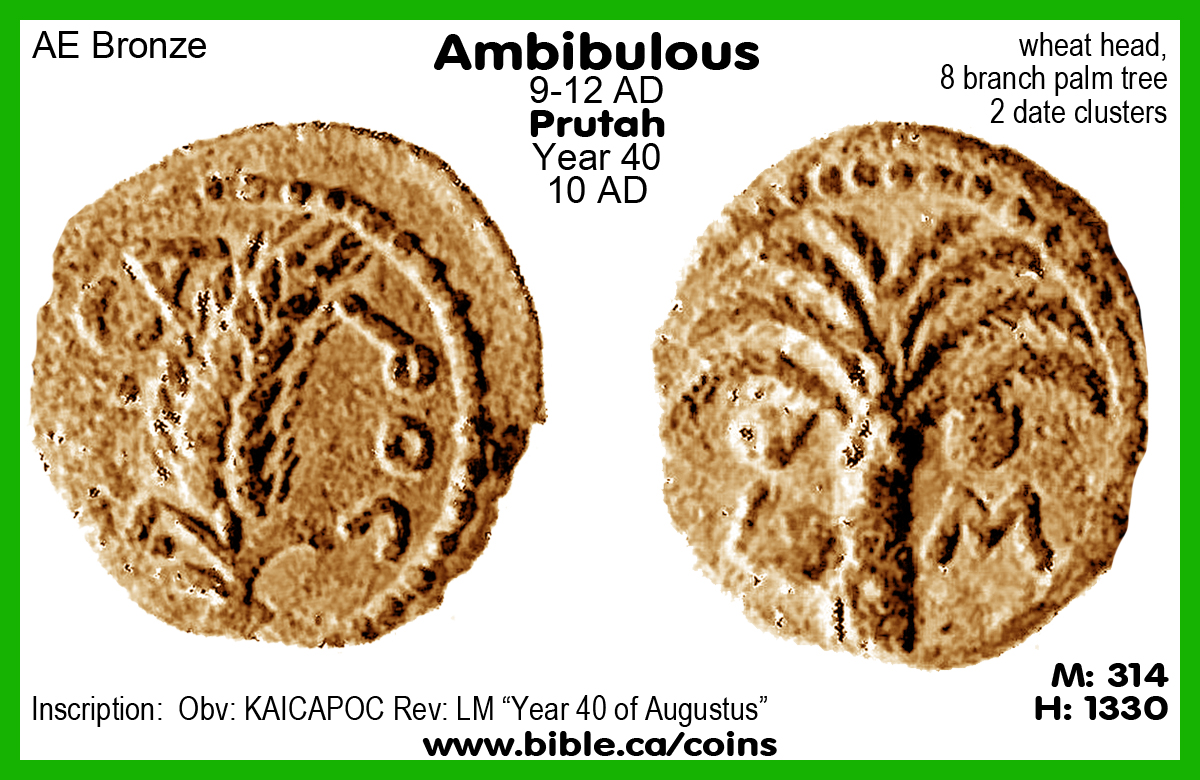
- Annius Rufus (12-15 AD
- Varerius Gratus (15-26 AD)
- Coins of Valerius Gratus: Prutah Year 4 of Tiberius: 18 AD
- Valerius Gratus: Prutah Year 5 of
Tiberius: 19 AD
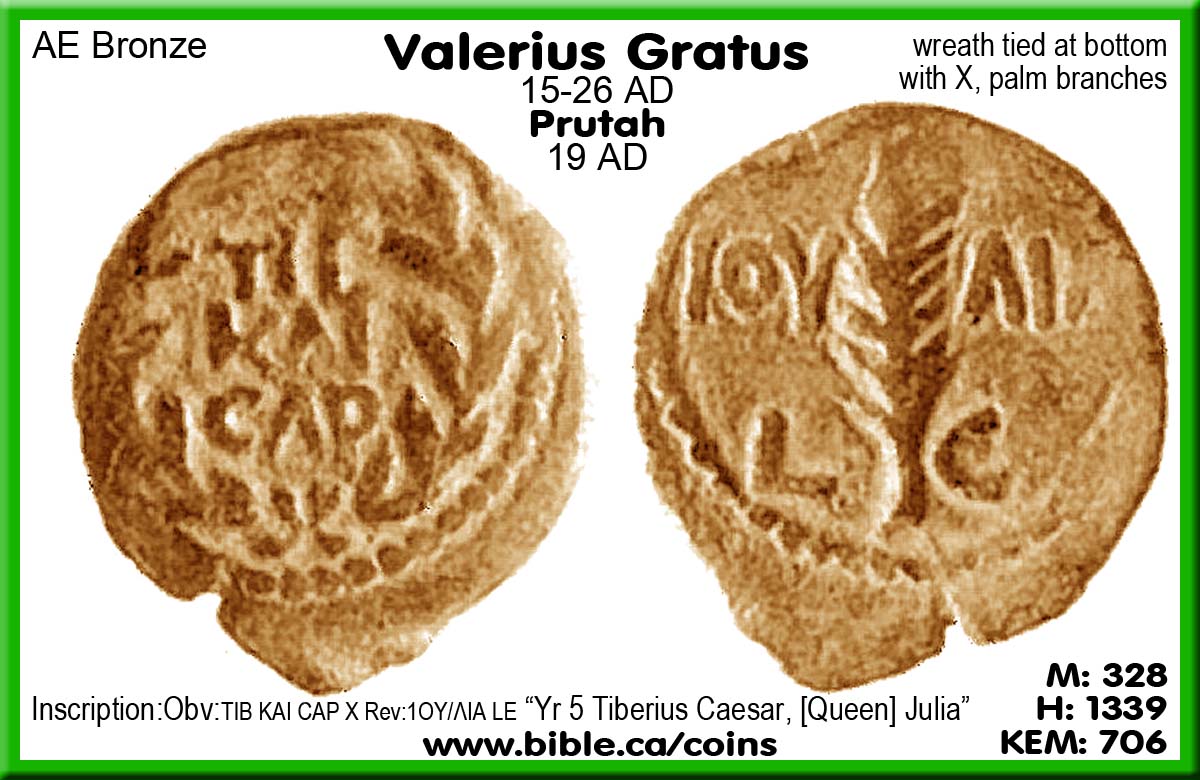
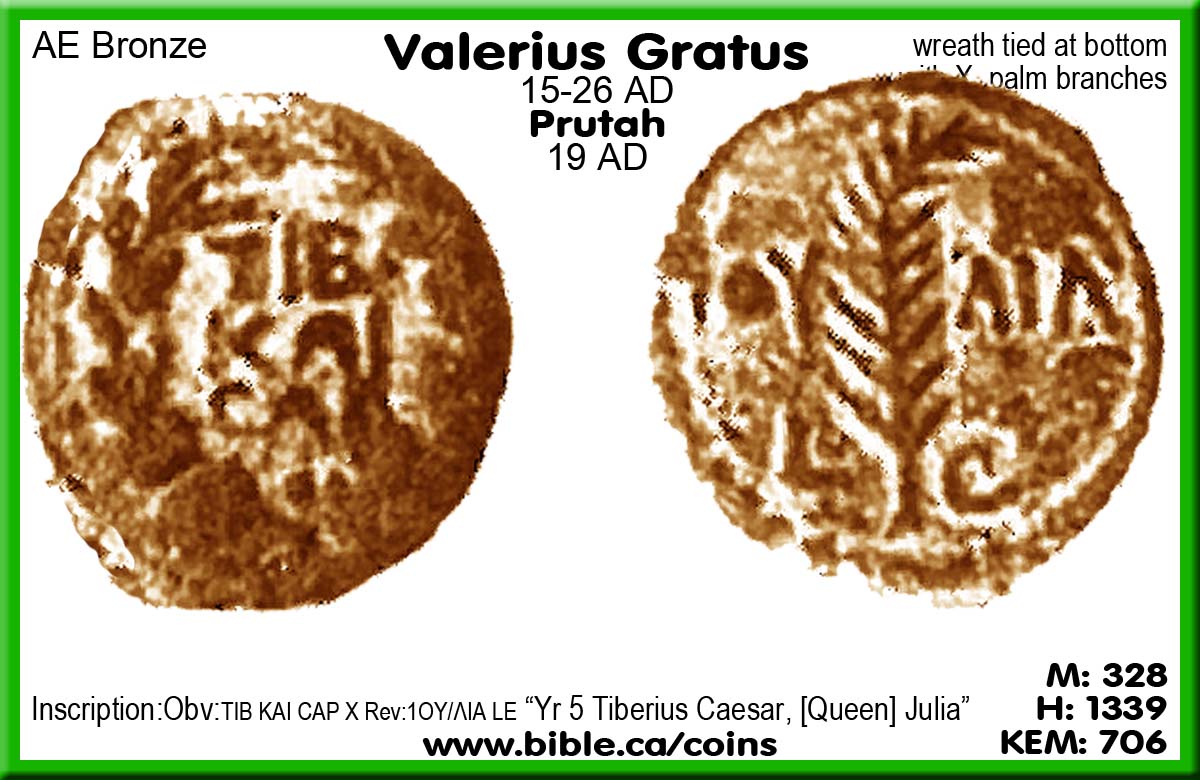
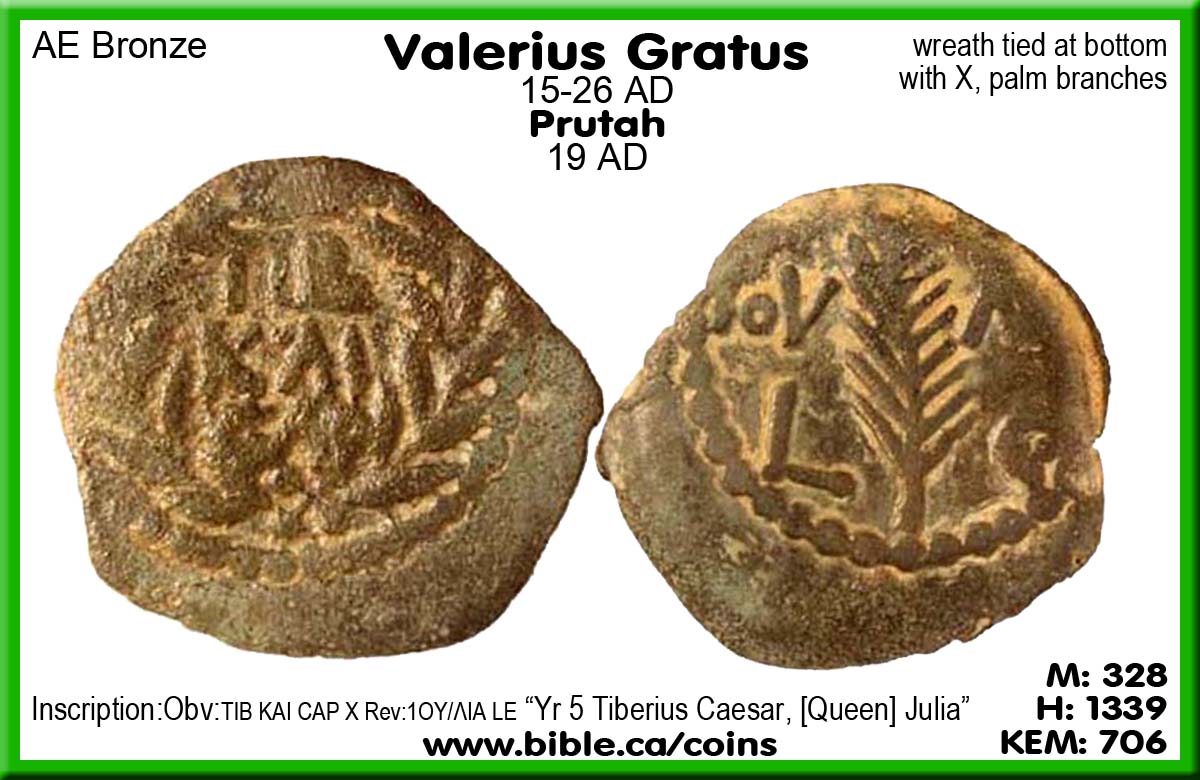
- Valerius Gratus: Prutah Year 11 of
Tiberius: 25 AD
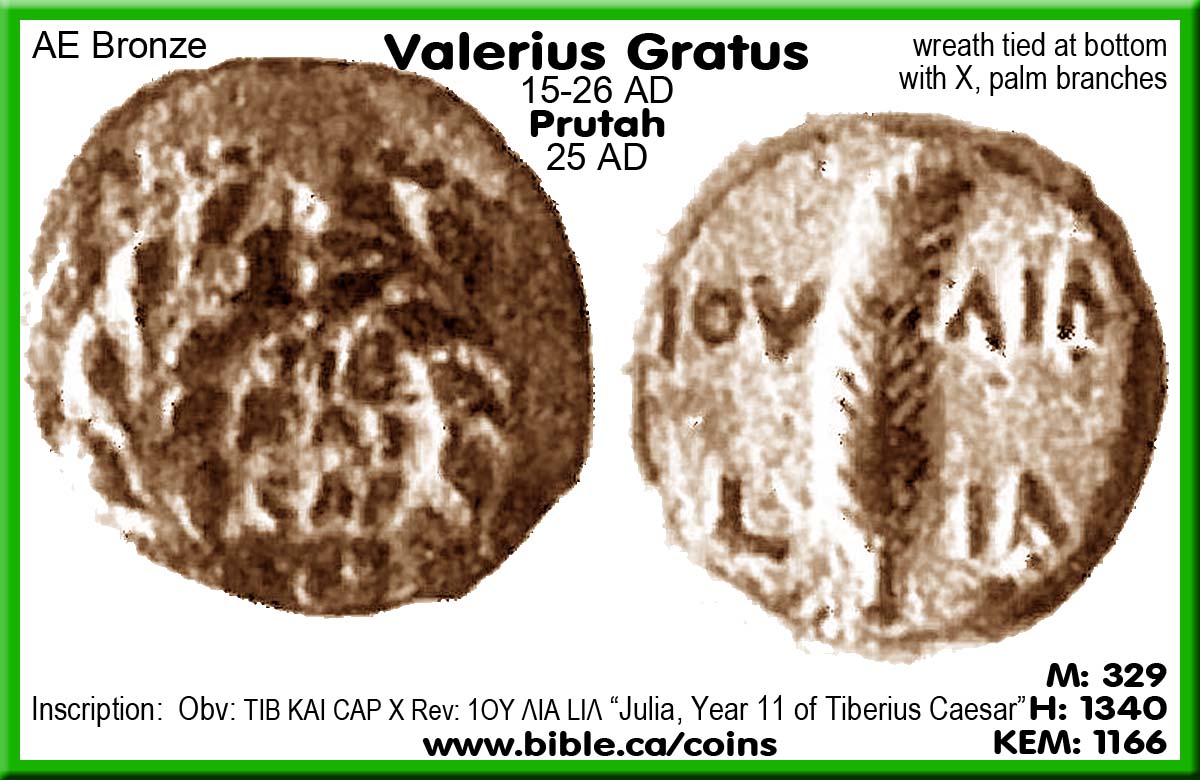
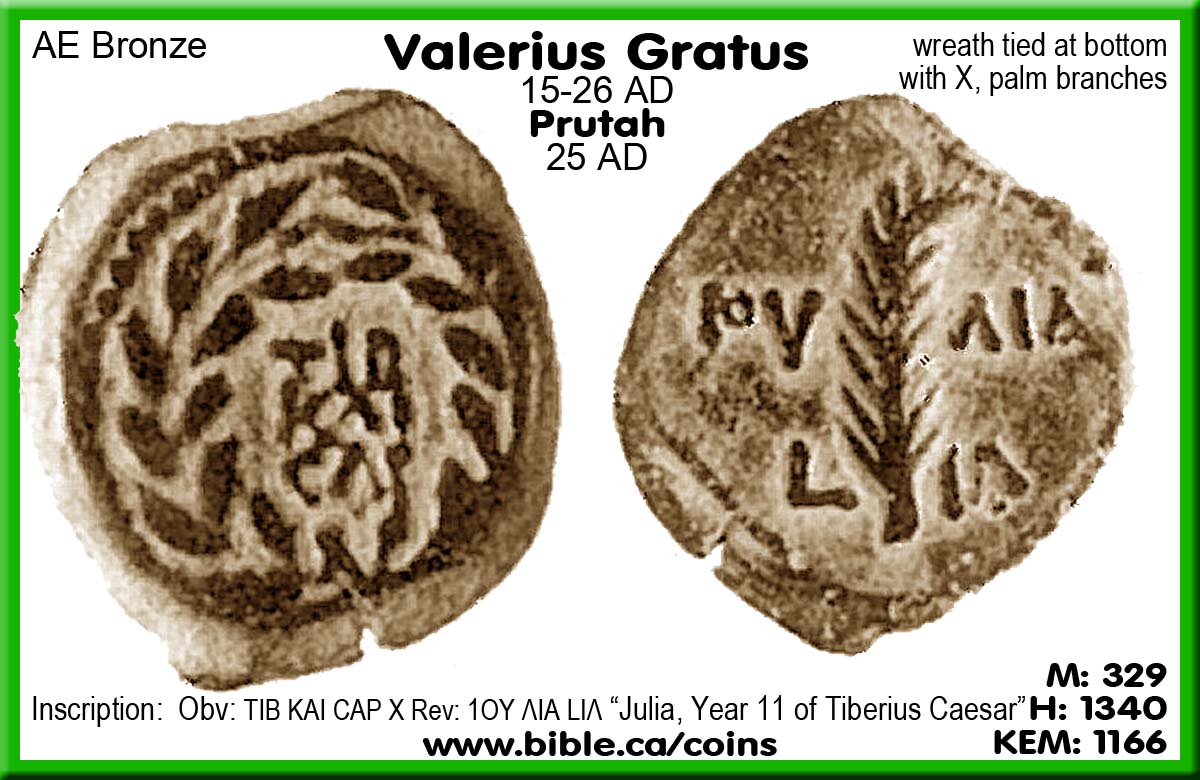
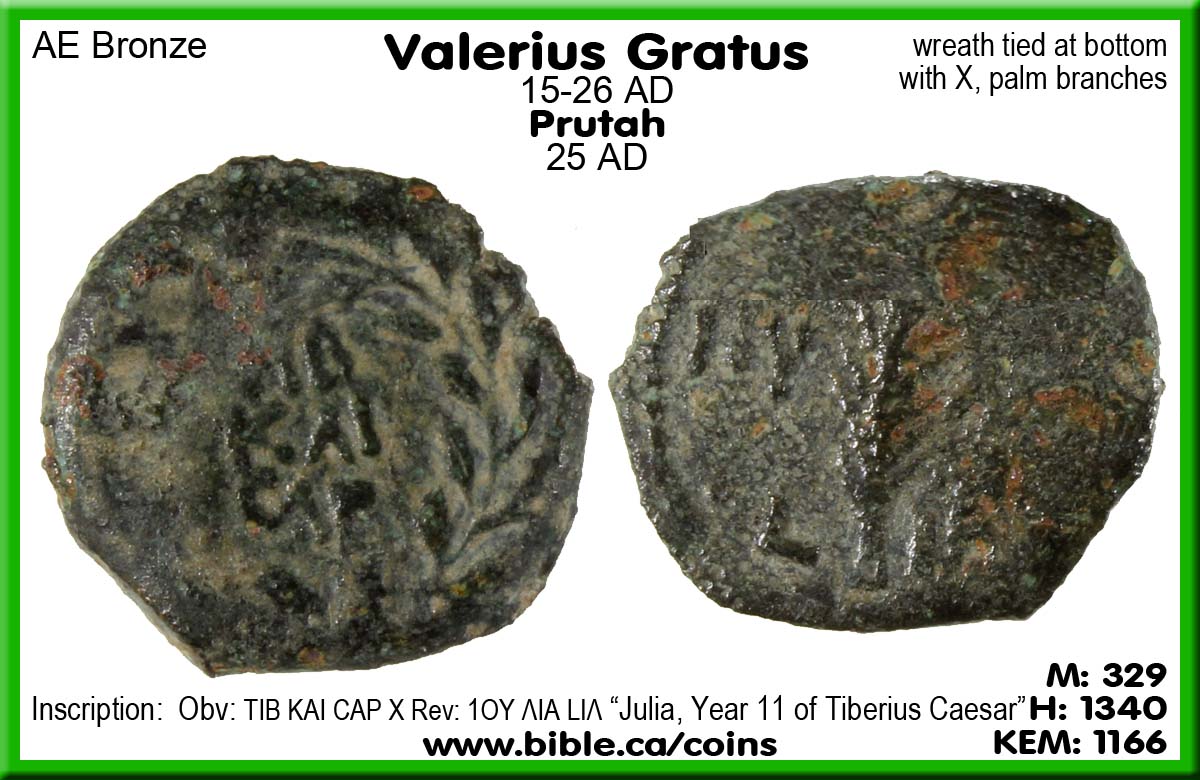
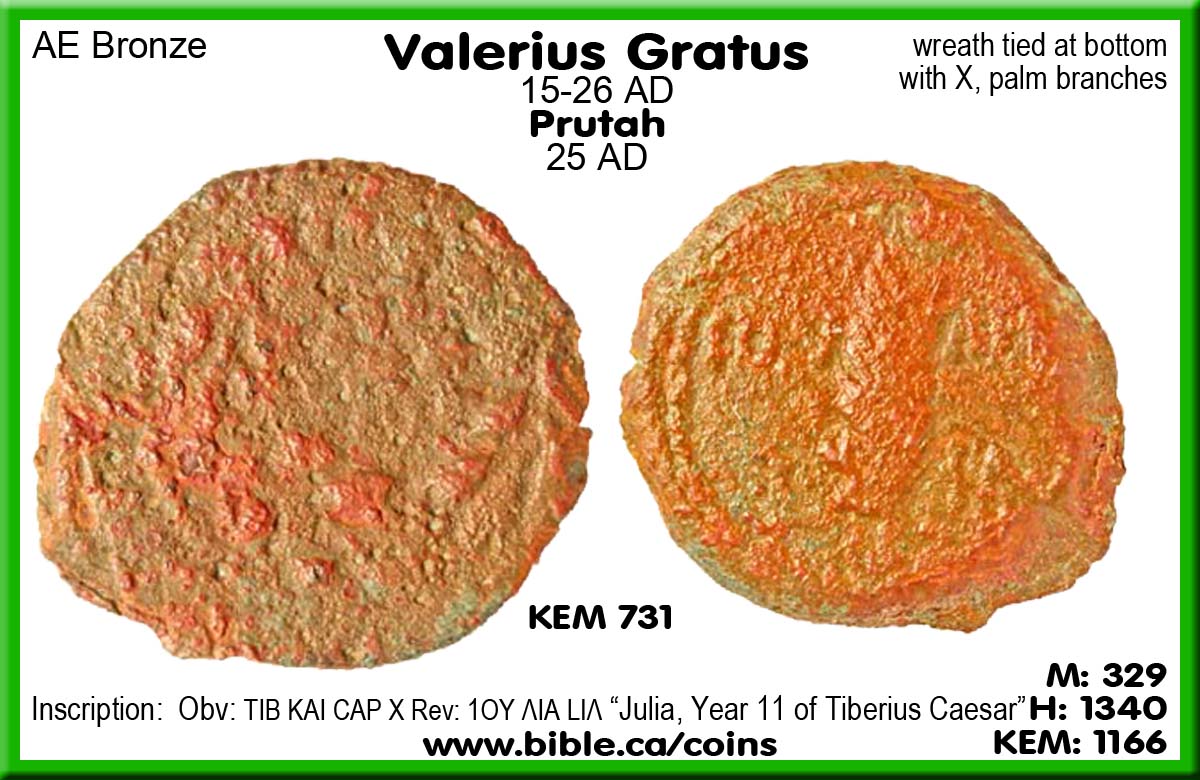
- Pontius Pilate (26-36 AD)
- Marcellus (36-37 AD)
- Marullus (37-41 AD)
- King Agrippa I (37-43 AD)
- Herod Agrippa I served two roles in Judean government under the Romans as both "Governor" and "King":
- Made king in 37-41 AD, then both king and governor for 2 years after Marullus: 41-43 AD
- Herod Agrippa I was eaten by worms in Acts 12.
- Coins of King Agrippa I: Prutah Year 6
of Agrippa: 42 AD
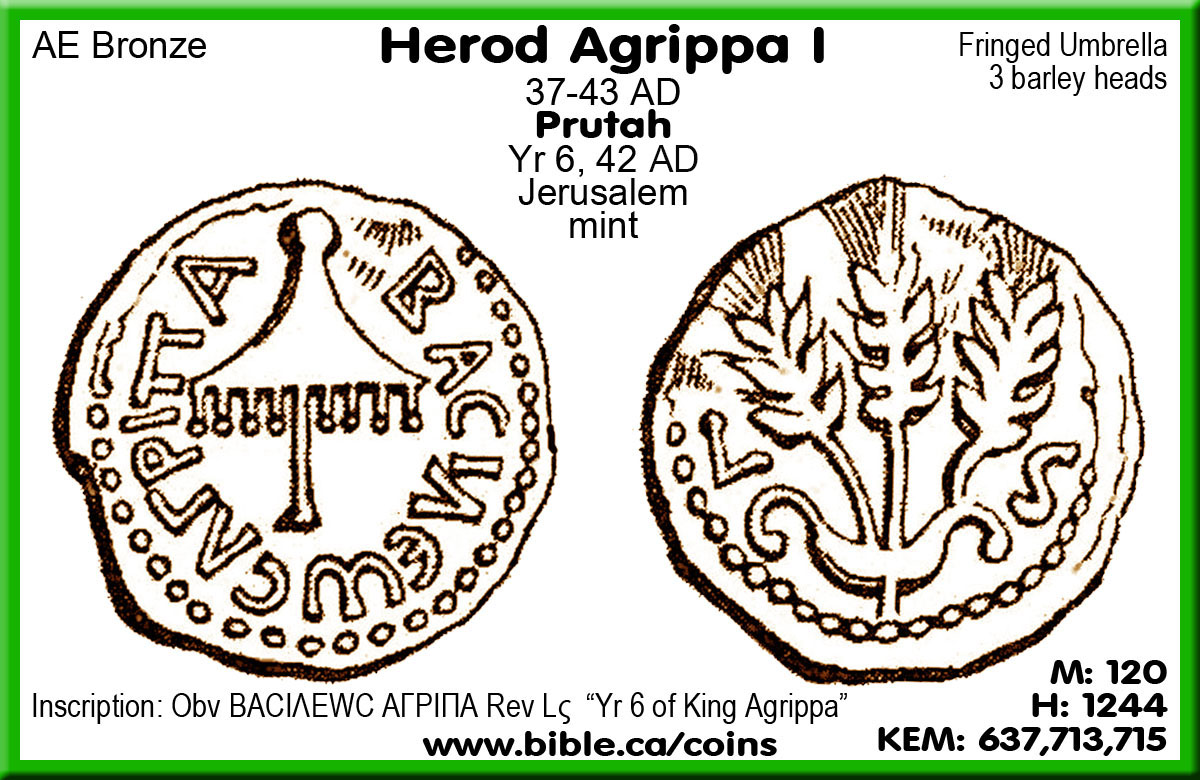
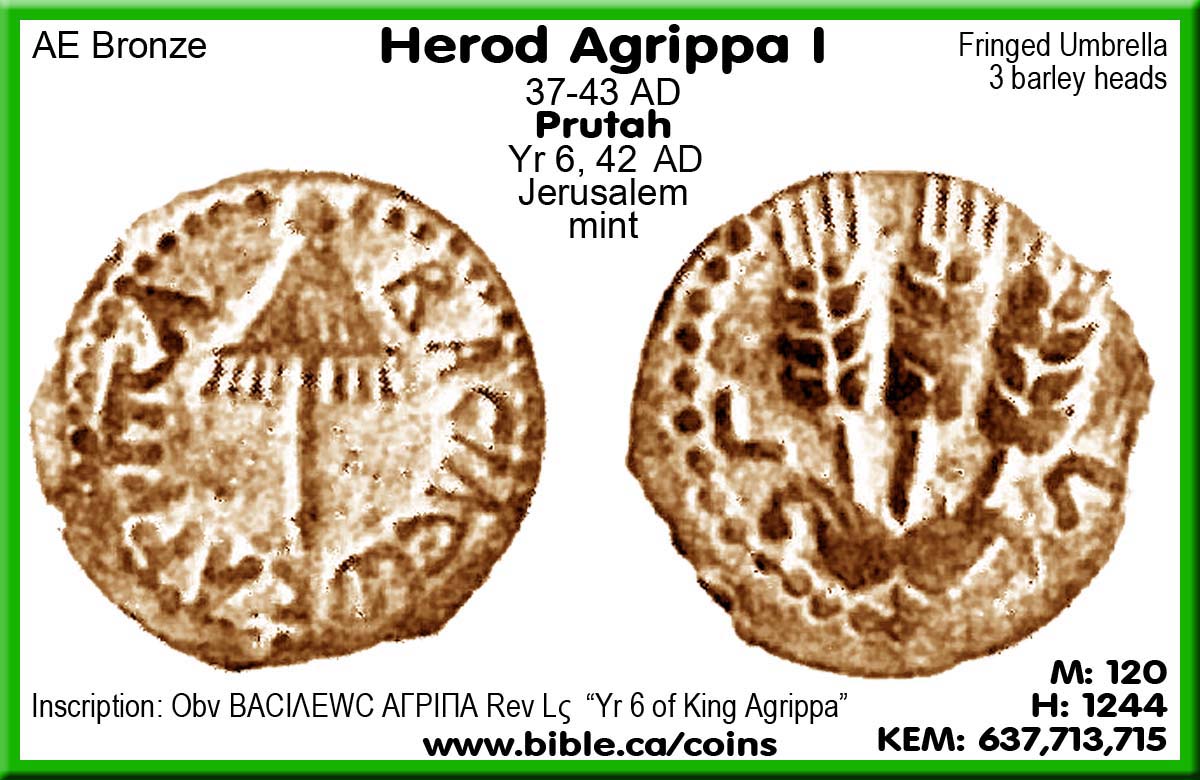
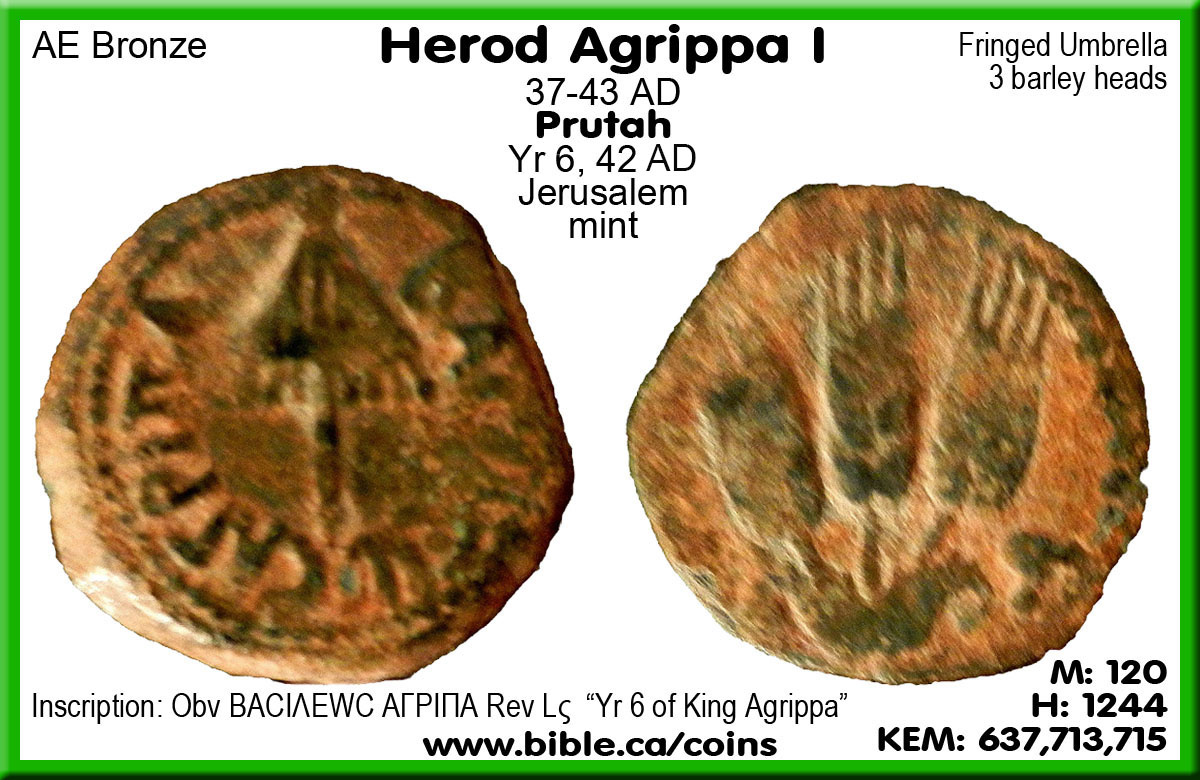
- Coin die of King Agrippa I: (Note: This
is a fabrication, replica)
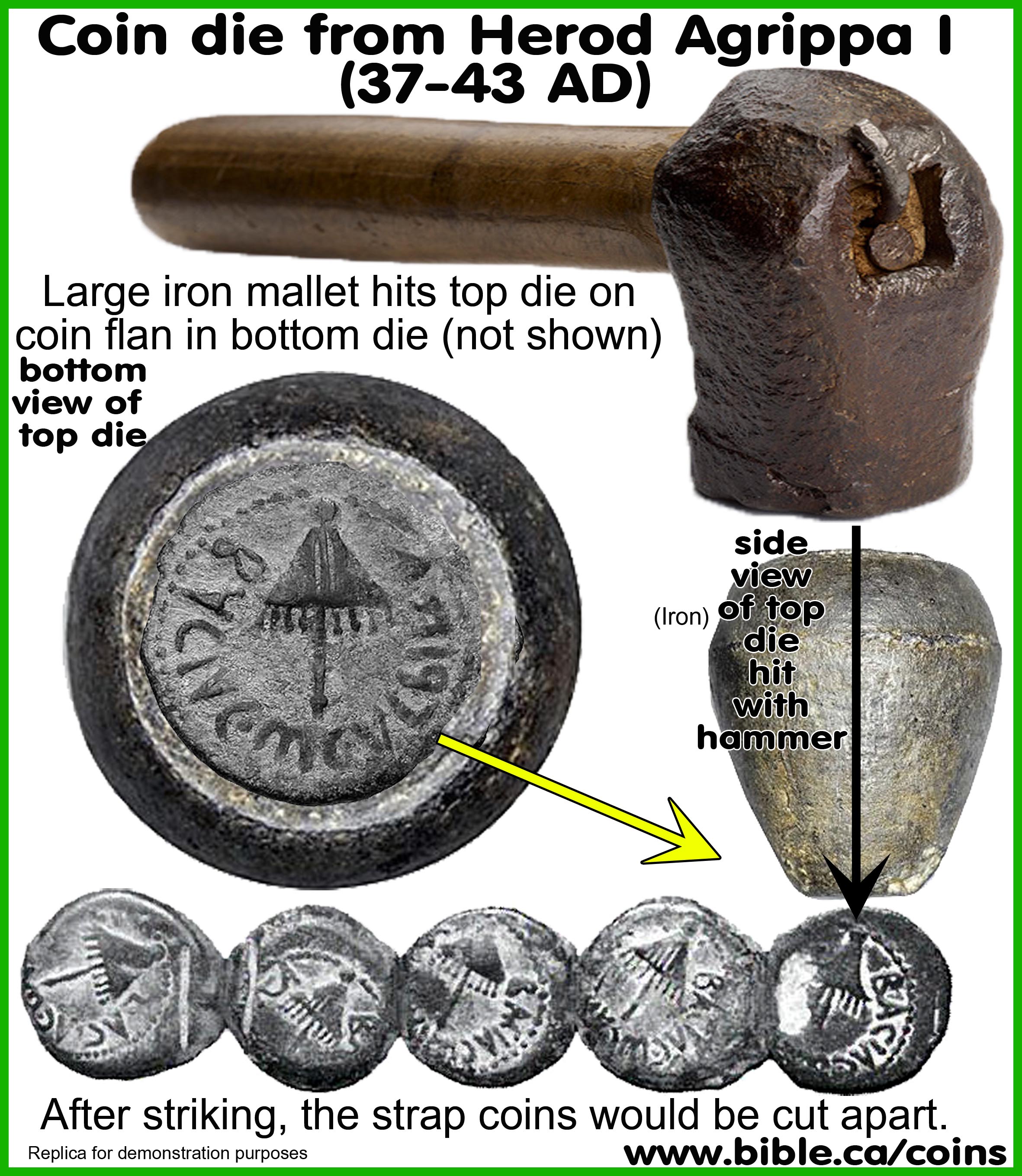
- Cuspius Fadus (44-46 AD)
- Tiberius Alexander (46-48 AD)
- Cumanus (48-52 AD)
- Antonius Felix (52-57 AD)
- Coins of Antonius Felix: Prutah Year 14 of Claudius: 54 AD
- Porcius Festus (57-62 AD)
- Coins of Porcius Festus: Prutah Year 5 of Nero: 59 AD
- Albinus (62-64 AD)
- Gessius Florus (64-66 AD)
V. The Two Jewish Wars: 66-60 AD and 132-135 AD
When the first Jewish revolt broke out and this ended the Governors of Judea appointed by Rome.
A. First Jewish War: 66-70 AD (74 including Masada)
- Gamla coin of the First Jewish war 66
AD
The Gamla coin was a crude bronze replica of the Silver Jerusalem Shekel. It is difficult to read the inscription and it may be in either Paleo-Hebrew or Aramaic. If the inscription is in Paleo-Hebrew, then the inscription reads "for the redemption of Holy Jerusalem" or "for the redemption of Gamla". If Aramaic it would read: "Year 1 to the freedom of the Jewish people. The famous Josephus had joined the rebellion and was living at Gamla. The Romans conquered Gamla, (Aramaic for Camel after the shape of the hill the town was built upon) and Josephus surrendered.
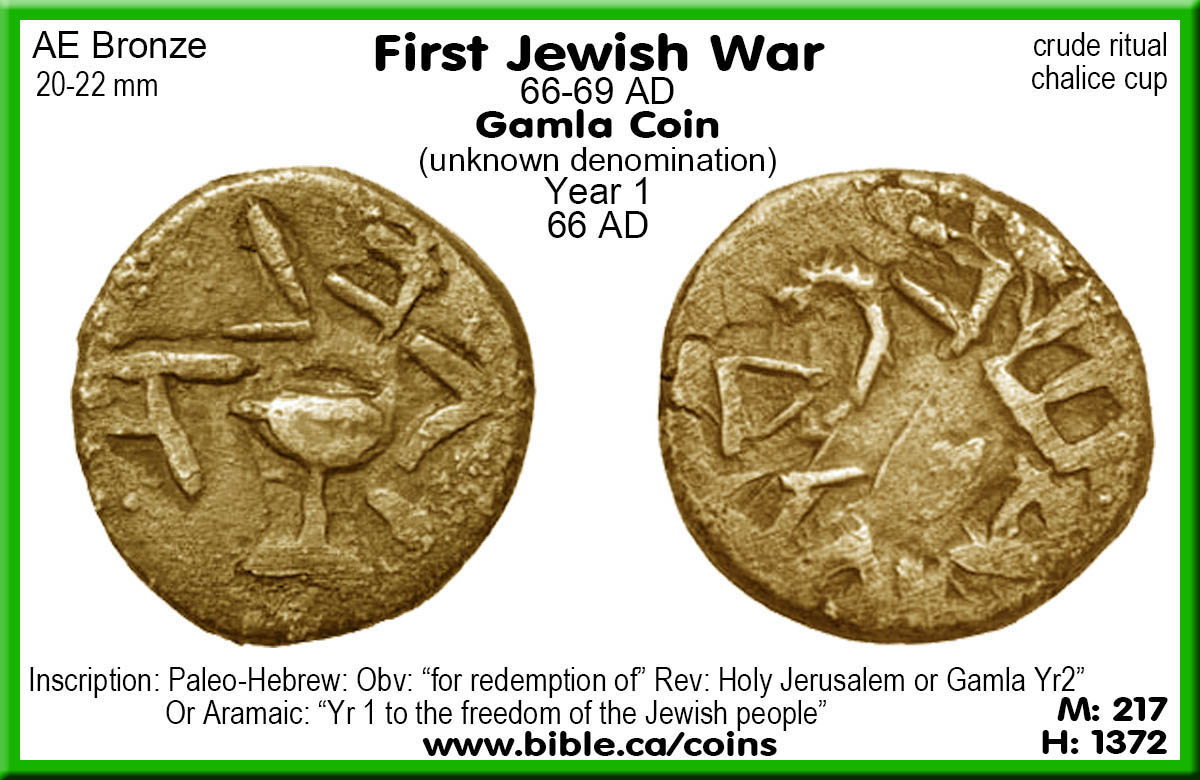
- First Jewish war Prutah: Year two of first Jewish independence war: 67 AD
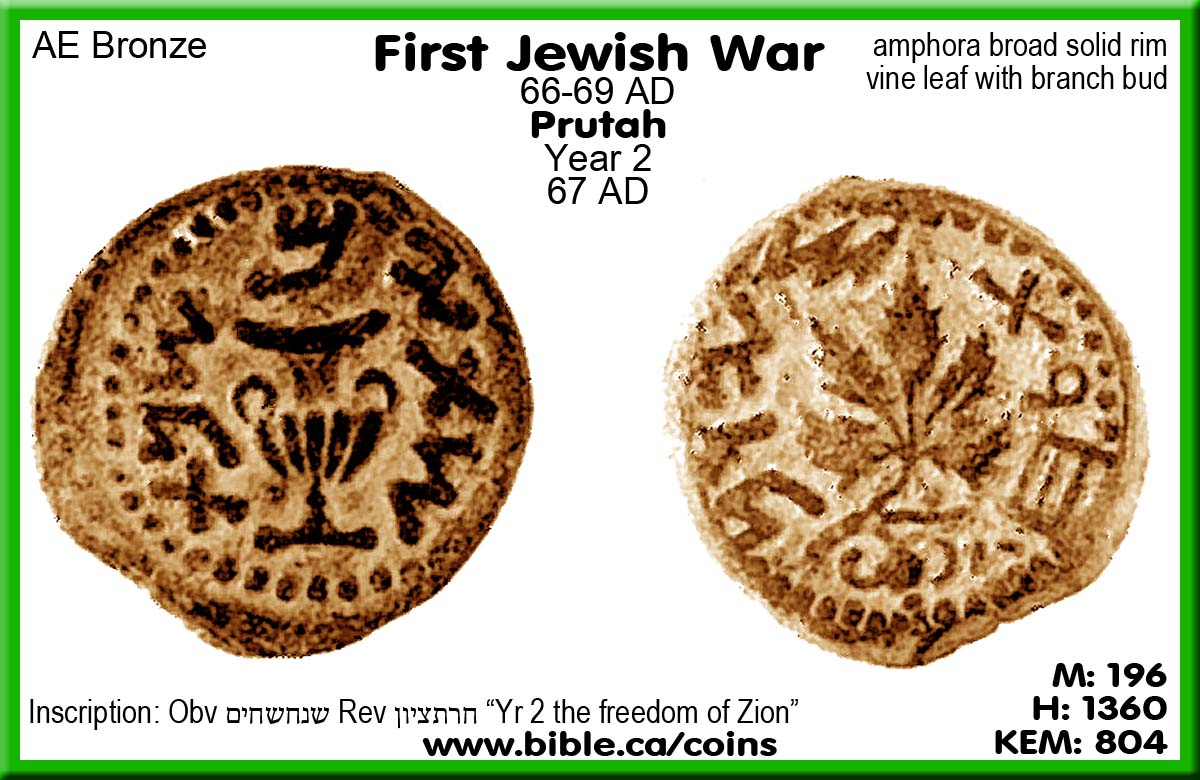
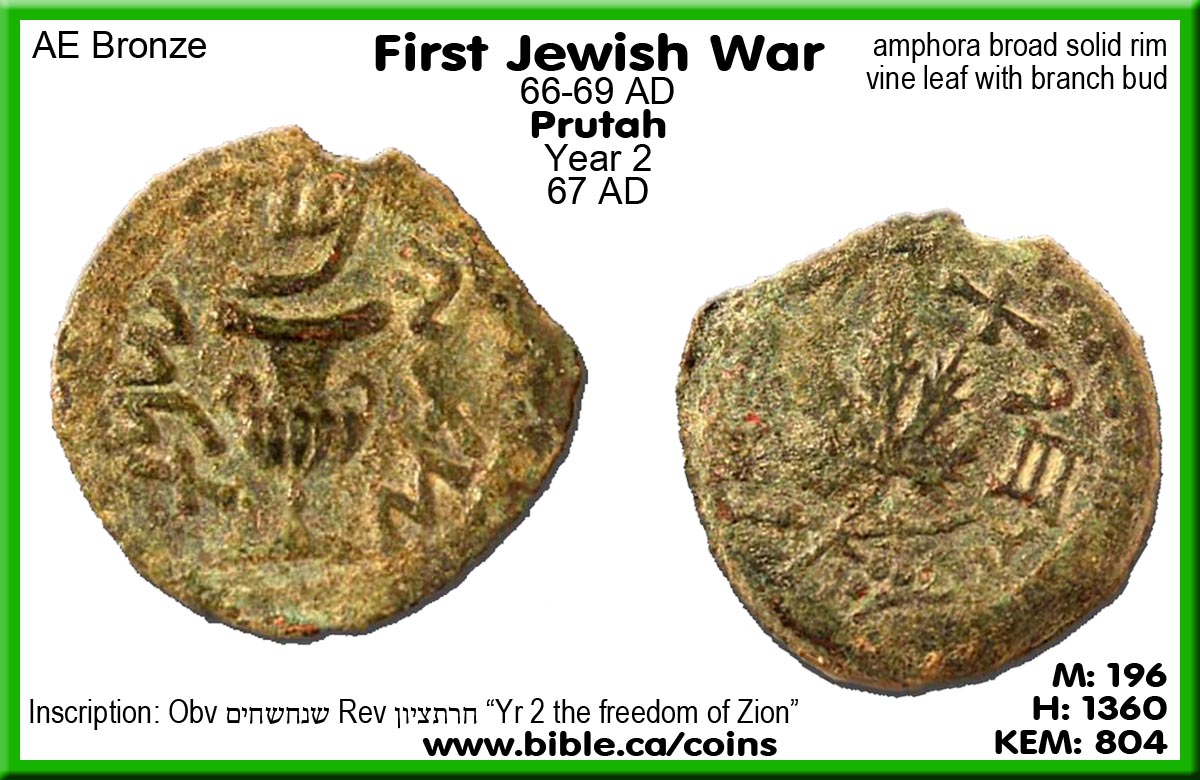
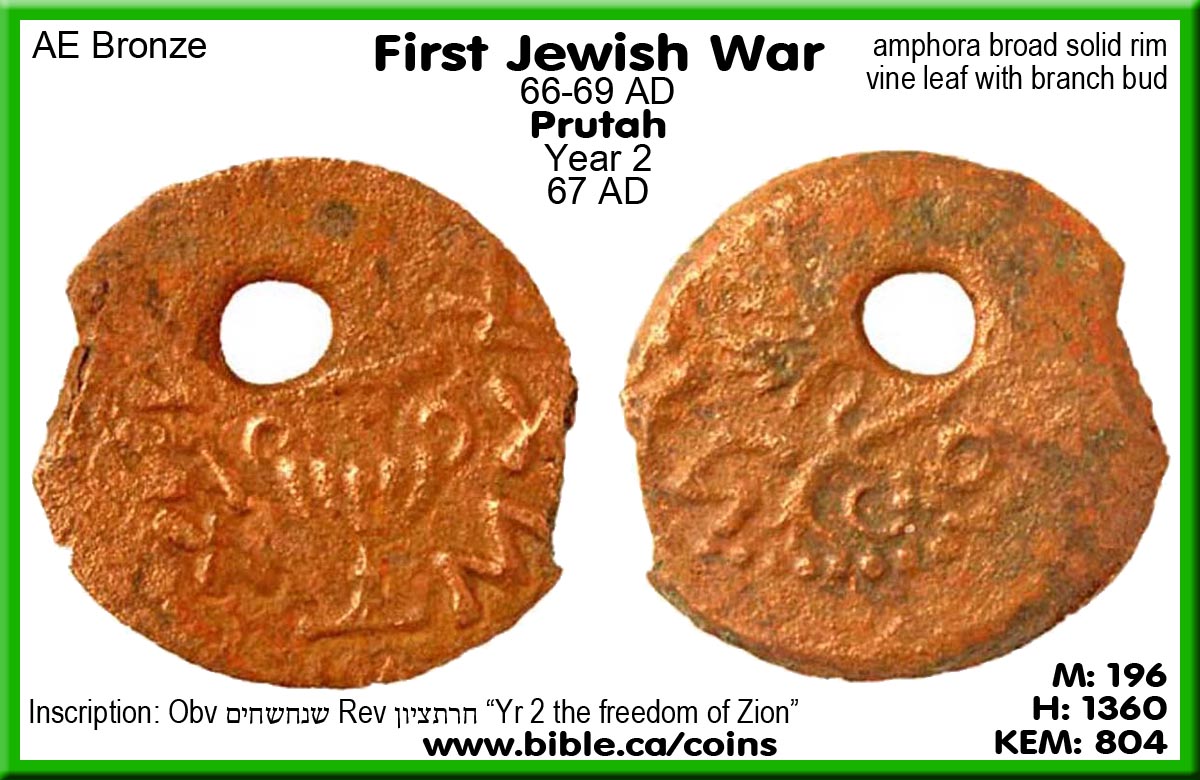
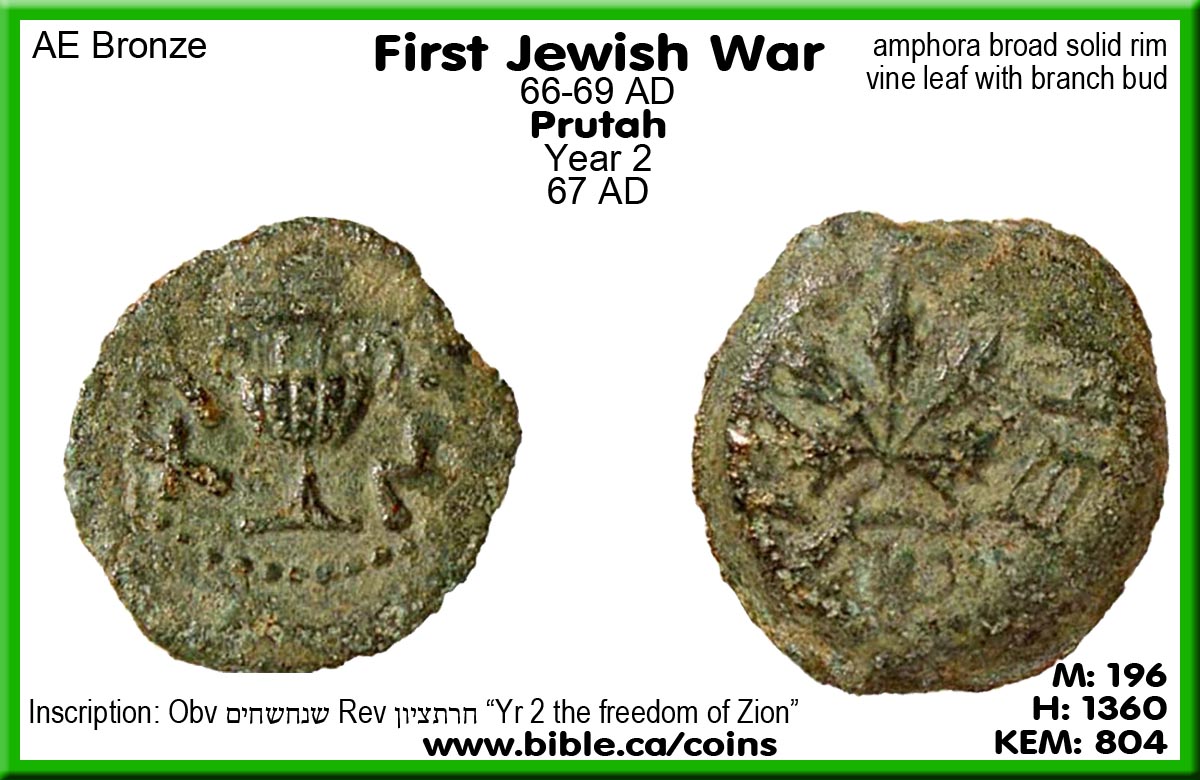
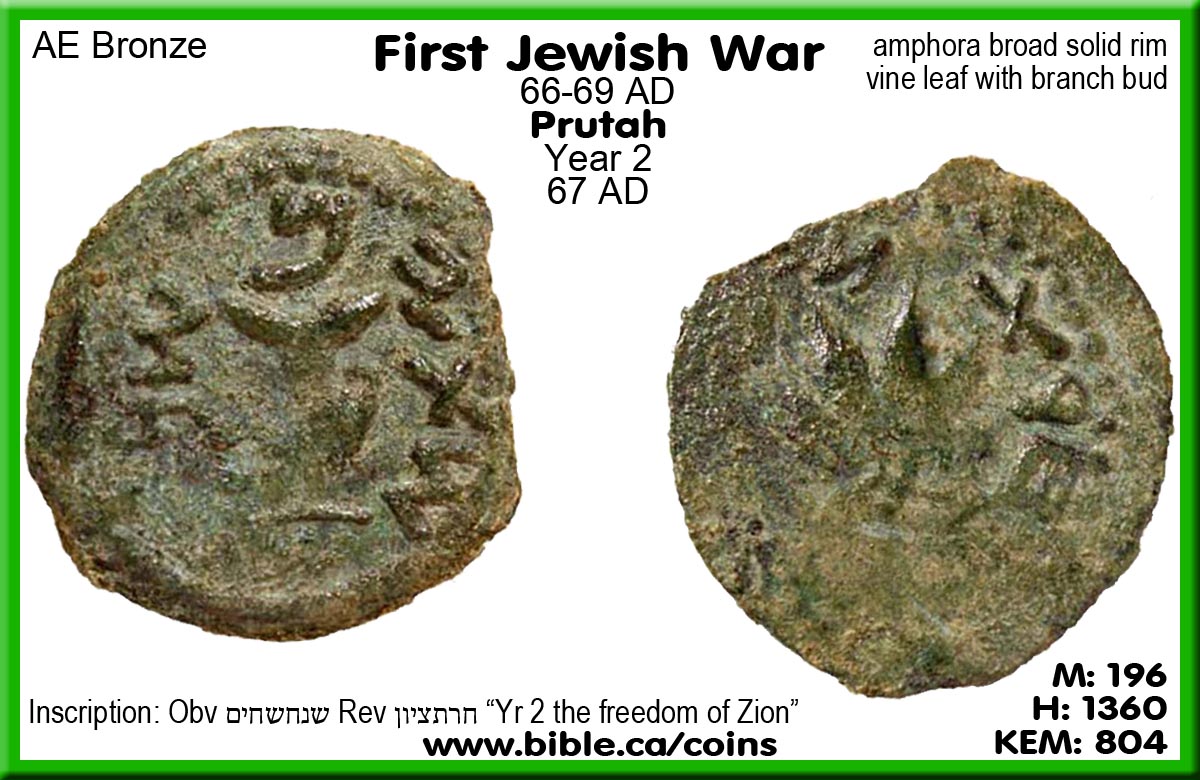
- First Jewish war Prutah: Year three of first Jewish independence war: 68 AD
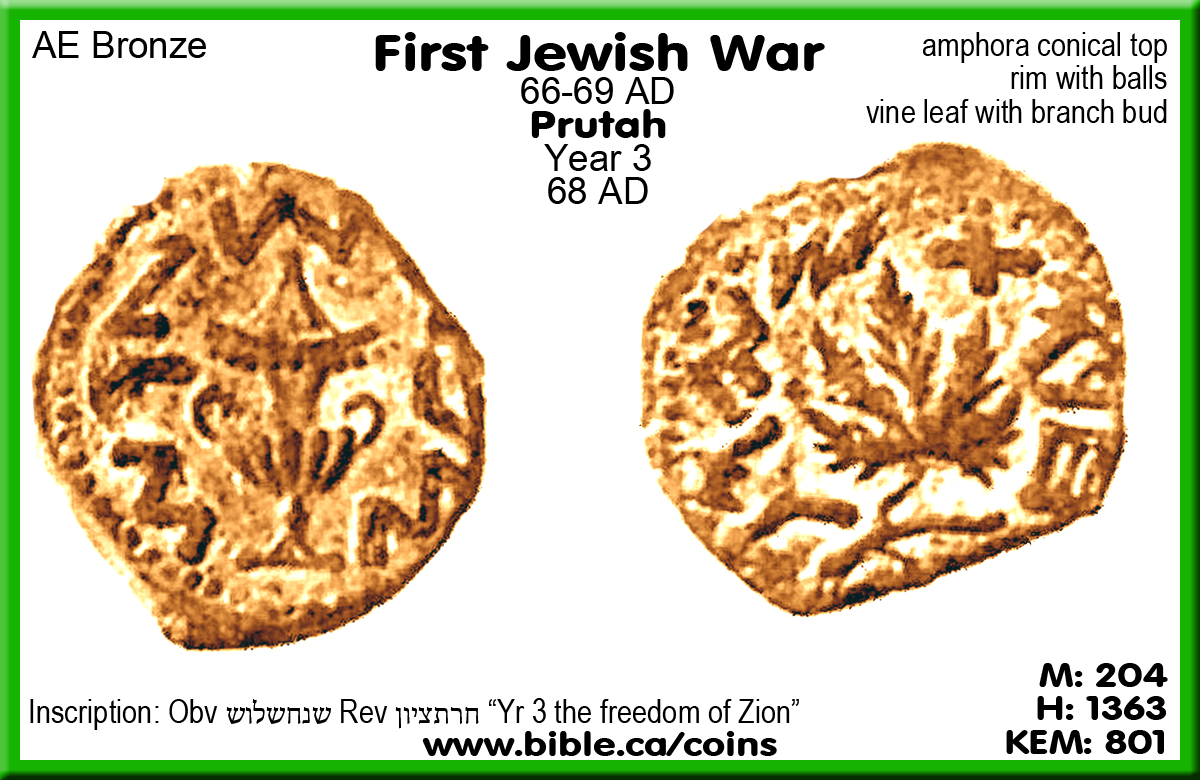
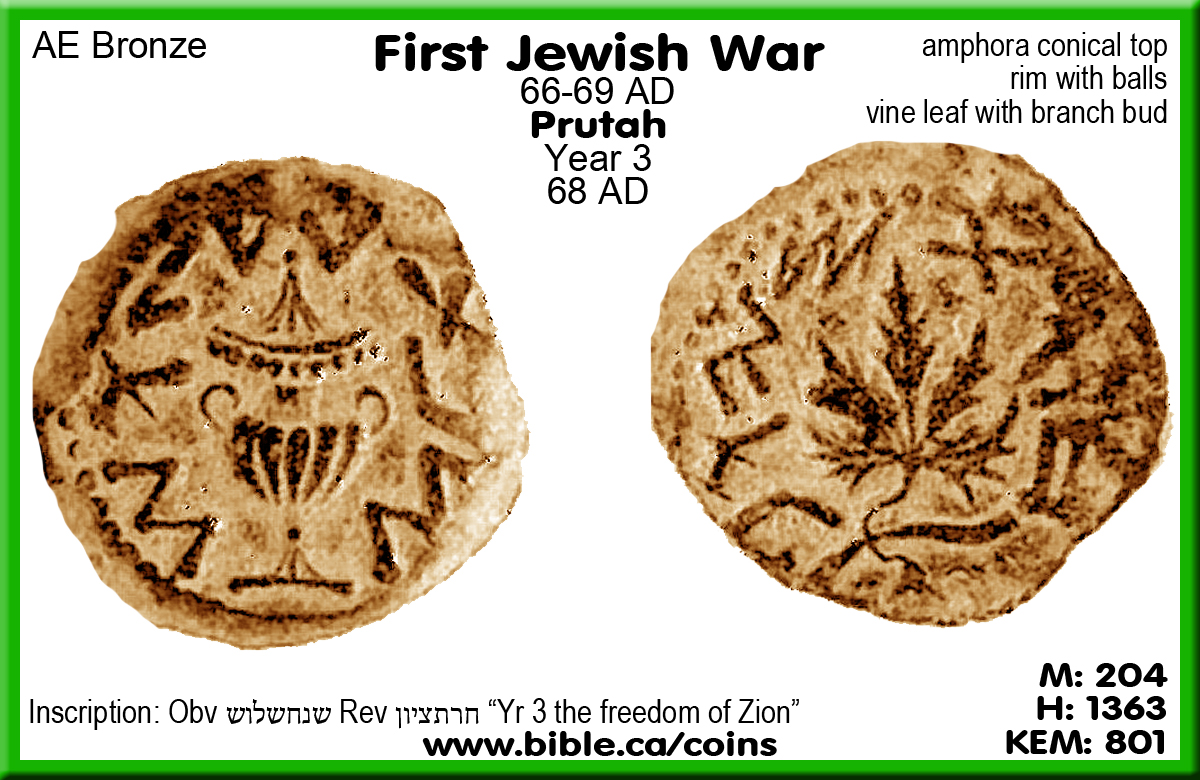
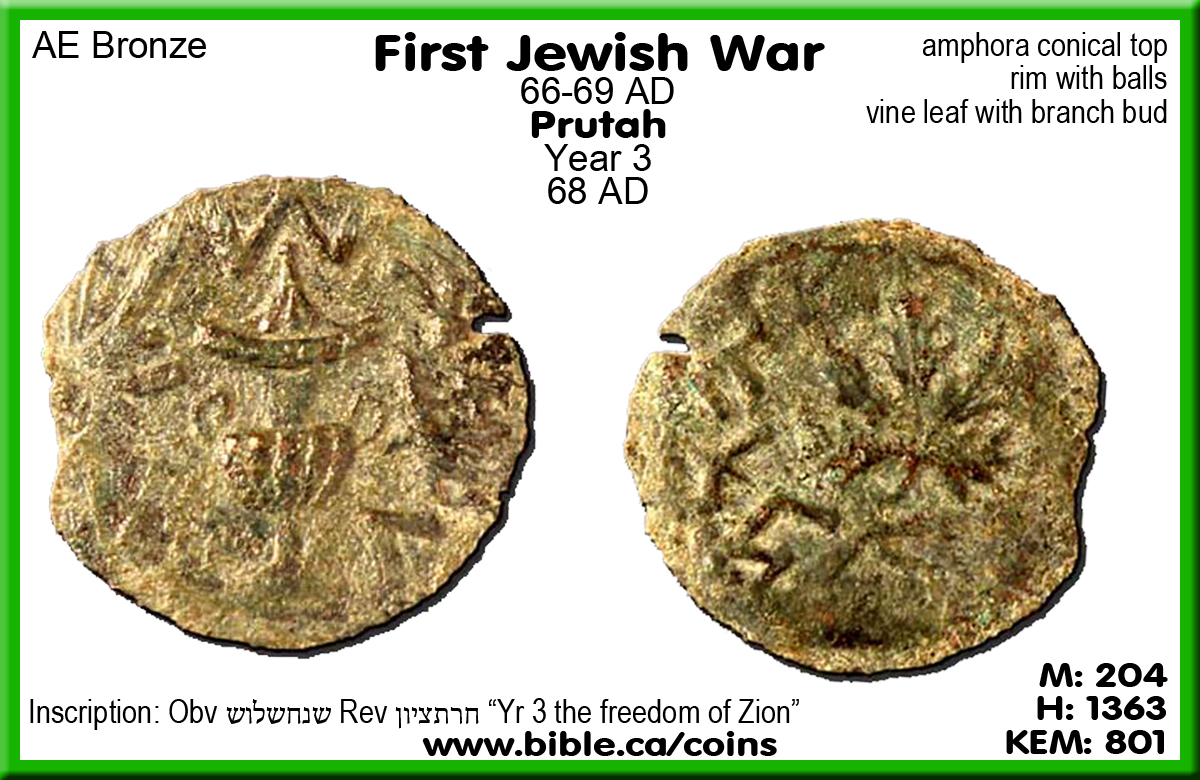
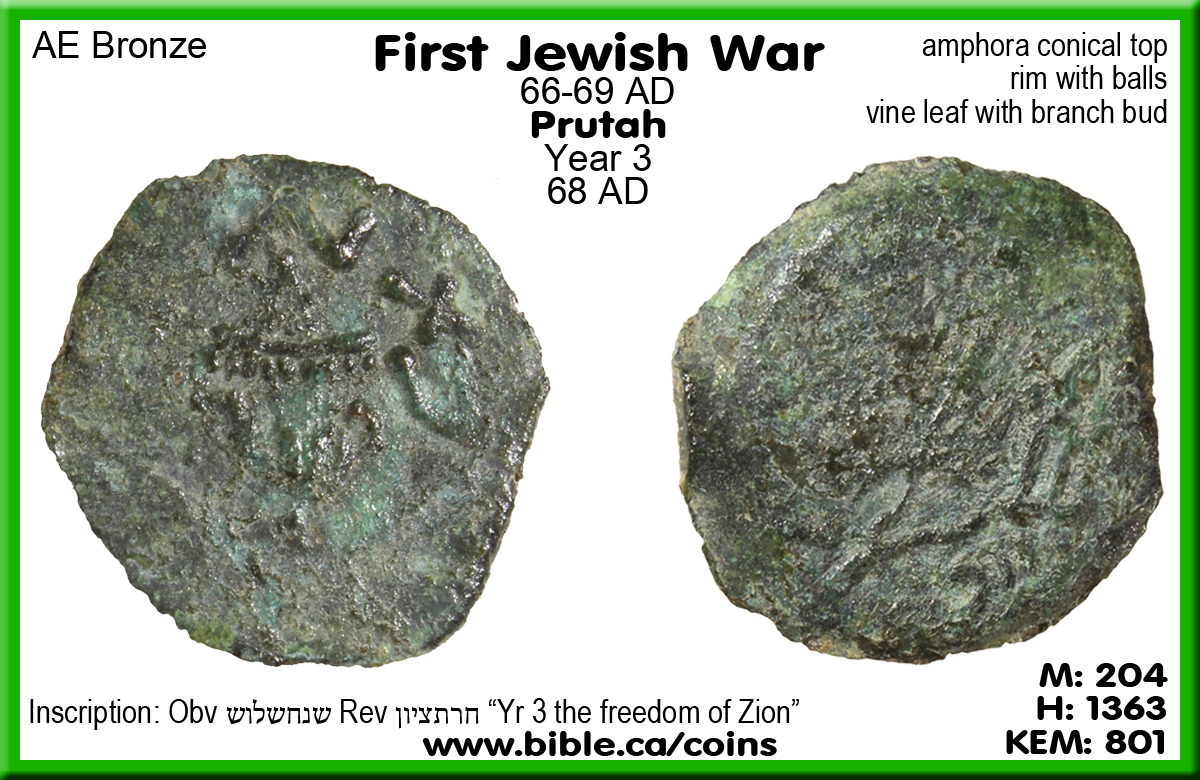
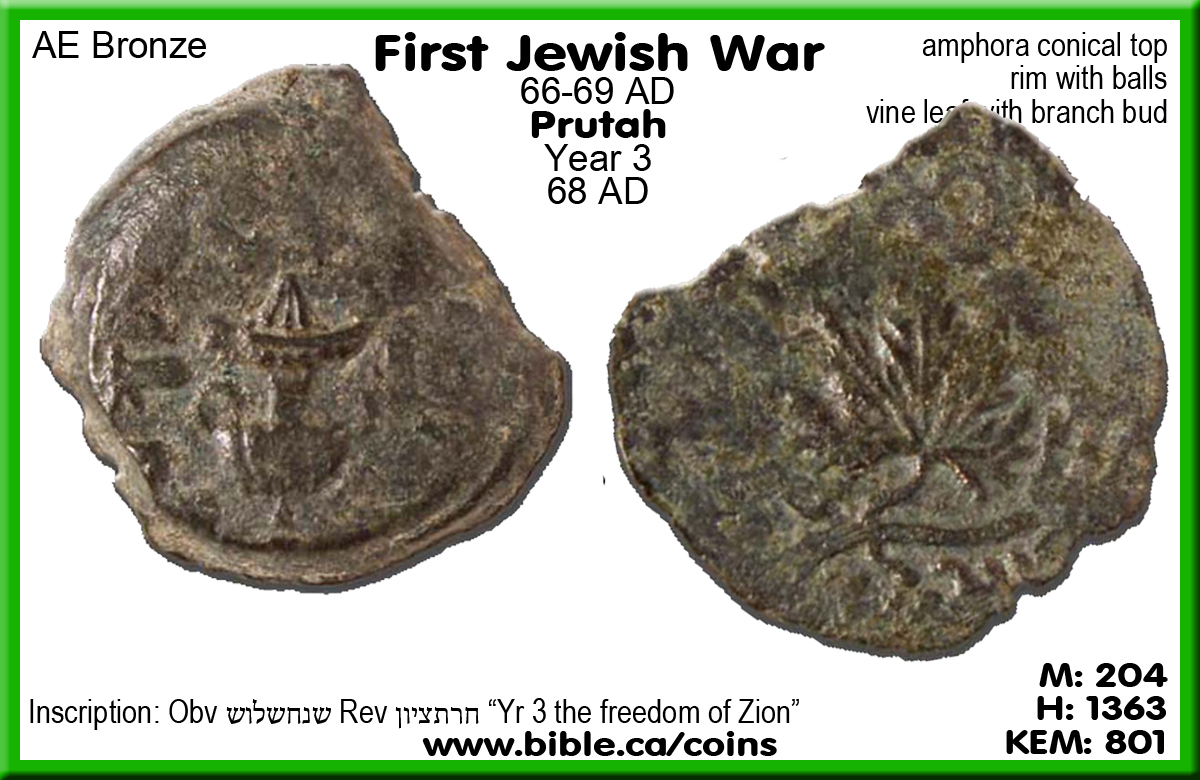
- Jerusalem was destroyed by Titus in 70 AD ending the Jewish nation.
B. Second Jewish war: 132-135 AD. Simon bar Kokhba
1. Hadrian triggers War by erecting Temple of Jupiter on Temple mount in Jerusalem: 132 AD
a. Hadrian expels Jews from Judah builds temple of Jupiter built on temple mount in Jerusalem which he renamed Aelia Capitolina and Judah Hadrian renamed "Palestine" after the historic enemies of the Jews, the Philistines
b. Roman historian Cassius Dio recorded the war in 229 AD: “At Jerusalem he founded a city in place of the one which had been razed to the ground, naming it Aelia Capitolina, and on the site of the temple of the god he raised a new temple to Jupiter. This brought on a war of no slight importance nor of brief duration, for the Jews deemed it intolerable that foreign races should be settled in their city and foreign religious rites planted there. … At first the Romans took no account of them. Soon, however, all Judaea had been stirred up, and the Jews everywhere were showing signs of disturbance, were gathering together, and giving evidence of great hostility to the Romans, partly by secret and partly by overt acts; many outside nations, too, were joining them through eagerness for gain, and the whole earth, one might almost say, was being stirred up over the matter. Then, indeed, Hadrian sent against them his best generals. First of these was Julius Severus, who was dispatched from Britain, where he was governor, against the Jews. Severus did not venture to attack his opponents in the open at any one point, in view of their numbers and their desperation, but by intercepting small groups, thanks to the number of his soldiers and his under-officers, and by depriving them of food and shutting them up, he was able, rather slowly, to be sure, but with comparatively little danger, to crush, exhaust and exterminate them. Very few of them in fact survived. Fifty of their most important outposts and nine hundred and eighty-five of their most famous villages were razed to the ground. Five hundred and eighty thousand men were slain in the various raids and battles, and the number of those that perished by famine, disease and fire was past finding out. Thus nearly the whole of Judaea was made desolate, a result of which the people had had forewarning before the war. For the tomb of Solomon, which the Jews regard as an object of veneration, fell to pieces of itself and collapsed, and many wolves and hyenas rushed howling into their cities.” (Roman History, Cassius Dio, Book 69:12-14, 229 AD)
c. Eusebius 325 AD: When Constantine came upon the temple mount in Jerusalem, he destroyed the temple of Jupiter that had been built in 135 AD by Hadrian. In building the "Church of the Holy Sepulchre" in 325 AD, Eusebius records how Constantine even removed the soil on the site and dumped it far away. Hadrian had built a temple to Venus on the site and Constantine destroyed and removed every trace of this pagan idolatry. It seems unlikely that Constantine would remove even the soil from the site of the "Church of the Holy Sepulchre" where Hadrian had built a temple to Venus, but leave Hadrian's statues on the temple mount. Yet in 400 AD, Jerome says that the statue of Hadrian riding a horse was still standing on the very place of the Jewish Temple. Eusebius wrote in 325 AD: "How Constantine Commanded the Materials of the Idol Temple, and the Soil Itself, to Be Removed at a Distance: Nor did the emperor's zeal stop here; but he gave further orders that the materials of what was thus destroyed, both stone and timber, should be removed and thrown as far from the spot as possible; and this command also was speedily executed. The emperor, however, was not satisfied with having proceeded thus far: once more, fired with holy ardor, he directed that the ground itself should be dug up to a considerable depth, and the soil which had been polluted by the foul impurities of demon worship transported to a far distant place." (Eusebius , The Life of the Blessed Emperor Constantine, book 3, ch 27)
d. Jerome wrote in 400 AD, "So when you see the standing in the holy place the abomination that causes desolation... or to the statue of the mounted Hadrian, which stands to this very day on the site of the Holy of Holies." (Jerome, Commentary on Matthew 24.15, 400 AD)
e. Here we see the temple of Jupiter from Baalbek laid over top of the temple mount. Notice the Holy of Holies is directly over top of the equestrian horse statue of Hadrian as a symbol of his triumph over Judaism. The temple was not located over top of the Dome of the rock but in the hollow of the hill below, where a threshing floor would be located. This is also directly east of the current wailing wall of the Jews. See detailed outline of the Holy of Holies located over the Al Kas fountain where Hadrian placed his Horse statue.
2. See full outline on Messianic expectation seen in Dead Sea Scrolls and Jewish coins
3. See also Messianic symbols used in Hasmonean coins
4. Summary of Messianic coins of “Simon Christ”
|
Messianic symbols used in Simon Bar Kokhba second Jewish war |
||
|
Messianic symbol |
Bar Kokhba coin |
Comment |
|
Star: Num 24:15 King/Priest |
None. But used by Maccabees. See detailed outline on messianic symbols used in Hasmonean coins like the Messianic star coin (Prutah) also known as “Widow’s Mite”. |
Dead Sea scroll 4QTestimonia
specifically connects Num 24:17 with the star symbol which is used on many
Hasmonean coins like the “Widows Mite”. The most striking example is the
“King/Priest + star” coin of Alexander Jannaeus in 78 BC and Antigonus II in
37 BC. |
|
Prince: Isa 9:6 |
If the Hasmonean’s hinted quietly they were the messiah, Simon Bar Kokhba removed all doubt he was the messiah as clearly seen in his coins. In year one Simon Christ applied the “prince” of Isa 9:6 messianic prophecy to himself and indeed he ran the government and defeated Israel’s enemies (Rome) for three years. |
|
|
Restored temple: Amos 9:11; 2 Sam 7:14 |
With Simon’s successes in year one, his “year two of freedom of Israel” coins with the messianic star above the restored Jerusalem temple represent the peak of his power. He was now boldly claiming to be the Messiah of prophecy and a large majority of the Jews believed his claim that the “Days of the Messiah” had begun! |
|
|
Simon the Christ “Son of the Star” became “son of the Lie” after his defeat. |
This year three coin has “Simon” on the obverse and “for the freedom of Jerusalem” on the reverse. The substitution of freedom of “Israel” for “Jerusalem” focused the need to restore the Temple destroyed in 70 AD. Simon, known as “son of the Star” was called “son of the Lie” after a massive slaughter in 135 AD by Hadrian who erected a temple of Jupiter on the temple mount. |
|
|
Messianic Harp of David |
It is universally accepted that Simon Bar Kokhba claimed to be the messiah, branch of David. Hendin 1389, 1424, 1429 are very similar with Simon on obverse and three string harp/lyre of David on reverse. |
|
|
Messianic Harp of David |
This coin has Simon’s name AROUND the Davidic harp is a bold announcement the messianic branch/son of David who fulfills prophecies. Hendin 1436 |
|
|
Dual Messiahs John 1:20-22
2 Sam 7:12-14; Amos 9:11 |
|
TWO MESSIAHS: Dead Sea scroll 4QFlorilegium documents they also thought the messiah was two different men: “This refers to the branch of David, who will arise with the Interpreter of the law who will rise up in Zion in the last days” (4QFlorilegium, explaining 2 Sam 7 & Amos 9:11). This false idea of twin messiahs is also seen in John 1:20-22. The Jews at the time of Jesus Christ misunderstood much of what the Messianic prophecy was really predicting. They never dreamed the land promise was heaven, the restored temple was the body of Christ, the kingdom was the church and that the messiah was the liberator over the devil not Rome. They were looking for two messiahs when only Jesus was predicted. |
|
See full outline on Messianic expectation seen in Dead Sea Scrolls and Jewish coins |
||
4. Simon bar Kosiba/Koseba claimed to be the Messiah:
a. His actual name was "Simon bar Kosiba/Koseba" but Rabbi Akiba/Akiva called him "bar Kokhba" meaning "son of the star" which directly ties him as the messiah to "There shall step forth a star out of Jacob, and a scepter shall rise out of Israel" (Num 24:17). The name Bar Kokhba does not appear in the Talmud but in ecclesiastical sources. However, after he was defeated, the Jews started calling him "bar Koziba" meaning "son of the lie". Simon bar Kosiba/Kokhba was the first post-70 AD "president" of Israel who all the Jews believed to be the Messiah of prophecy who would liberate Israel from underneath Roman control. "Simon bar Kosiba, President over Israel, to Yehonathan and Masabala, peace. [My order is] that you search and seize the wheat which is in the possession of Hanun (Bar Kokhba's Letters, The Wooden Letter) They were sadly mistaken in rejecting Jesus Christ as their true Messiah whom they crucified and even more mistaken in their false faith in Simon as the Messiah. Three ancient authentic sources (7th century, one 8th) that show that the significant portion of the Jewish community initially viewed Muhammad as the messiah, just as they did Bar Kokhba in 135 AD. The Jews only realized Bar Kokhba was false after he was defeated and Akiva's disciple, Yose ben Halaphta changed his name from "son of the star" to "the son of lies". The Jews only realized Muhammad was not their messiah when he ate non-kosher camel meat and the attack on the Jewish oasis of Khaybar in 628 AD.
b. "Contrary to the widely held view that the Aramaic word Kazab is "falsehood", and all examples cited from rabbinic literature have the meaning of lie, deception, or falsehood. In modern Hebrew, the usual meaning of kazab is "lie", although it can also take the meaning of "disappointment." But any attempt to translate "bar Kozeba" as "son of the disappointment" would be forcing a meaning from a modern language onto a similar word in a different language and from a different millennium." (Rodger Young).
- "In rabbinic writings the s in the name [bar Kosiba] is usually changed to a z (bar Koziba), implying in derogatory fashion that Simon was regarded as “the son of a lie” (i.e., a liar)." (ABD, Bar Kokhba). The Talmud always translates his name "Simon bar Koziba" (בר כוזיבא) or "Simon Bar Kozevah" (בר כוזבה)." The Babyonian Talmud says: "Bar Koziba ruled for two and a half years. He said to rabbis, “I am the Messiah.” They said to him, “In the case of the Messiah it is written that he smells a man and judges. Let us see whether you can smell a man and judge.” When they saw that he could not smell a man and judge, they killed him." (Babylonian Talmud, b. Sanh. 11:1, I.46.V–X)
- Simon the Messiah misinterpreted Hadrian’s building of a temple of Jupiter on the former site of the Jewish temple, as the “abomination of desolation” of Daniel’s prophecy.
- Year one of second Jewish independence
war: Bar Kokhba: 132 AD
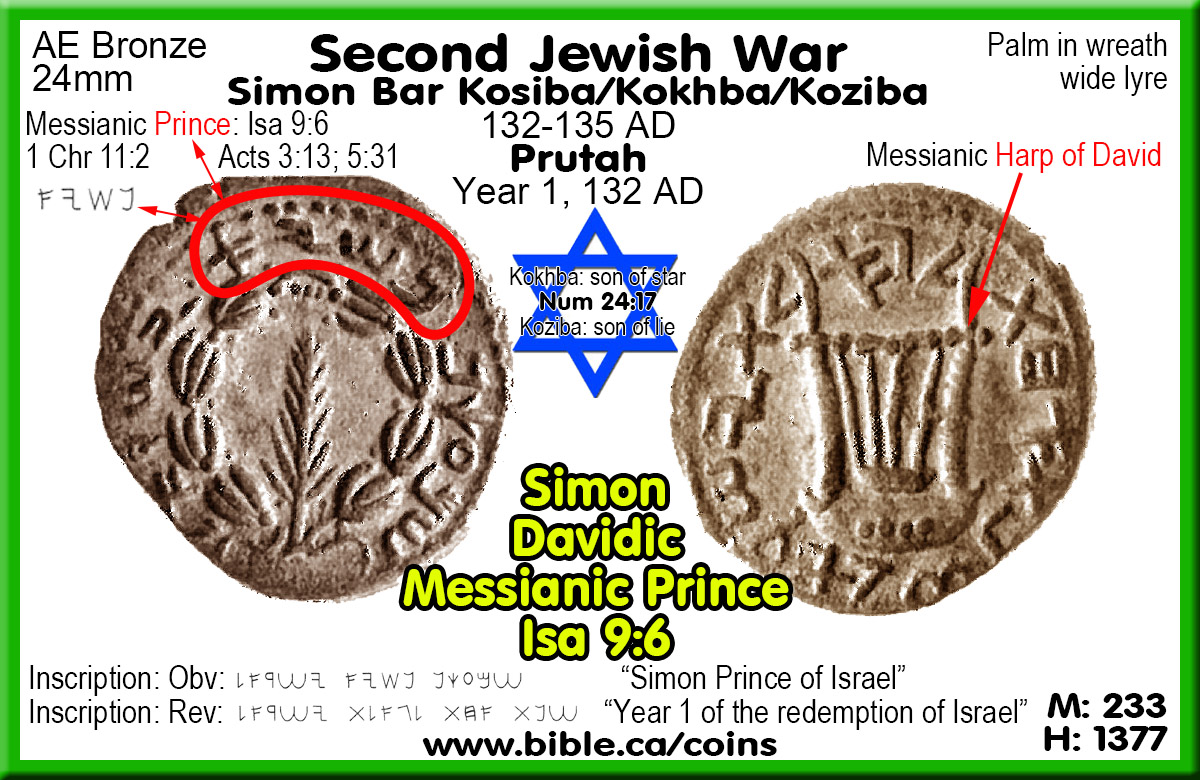
- Year two of second Jewish independence war: Bar Kokhba: 133 AD
- 2nd Jewish war, year two Tetradrachm:
The Messianic “temple restorer Star/king”
“The sign above the Temple facade was improved and became a symbol that is generally termed a "star." Some scholars even considered it to be an allusion to the appellation of Shimon Bar Kokhba = "son of a star." (His name Bar Kosiba is after the village from which he came.) Just as his opponents changed his name to Bar Koziba ("the deceiver"), his supporters called him Bar Kokhba (Son of Star).” (Treasury of Jewish coins, Yaakov Meshorer, p 152, 2001 AD)
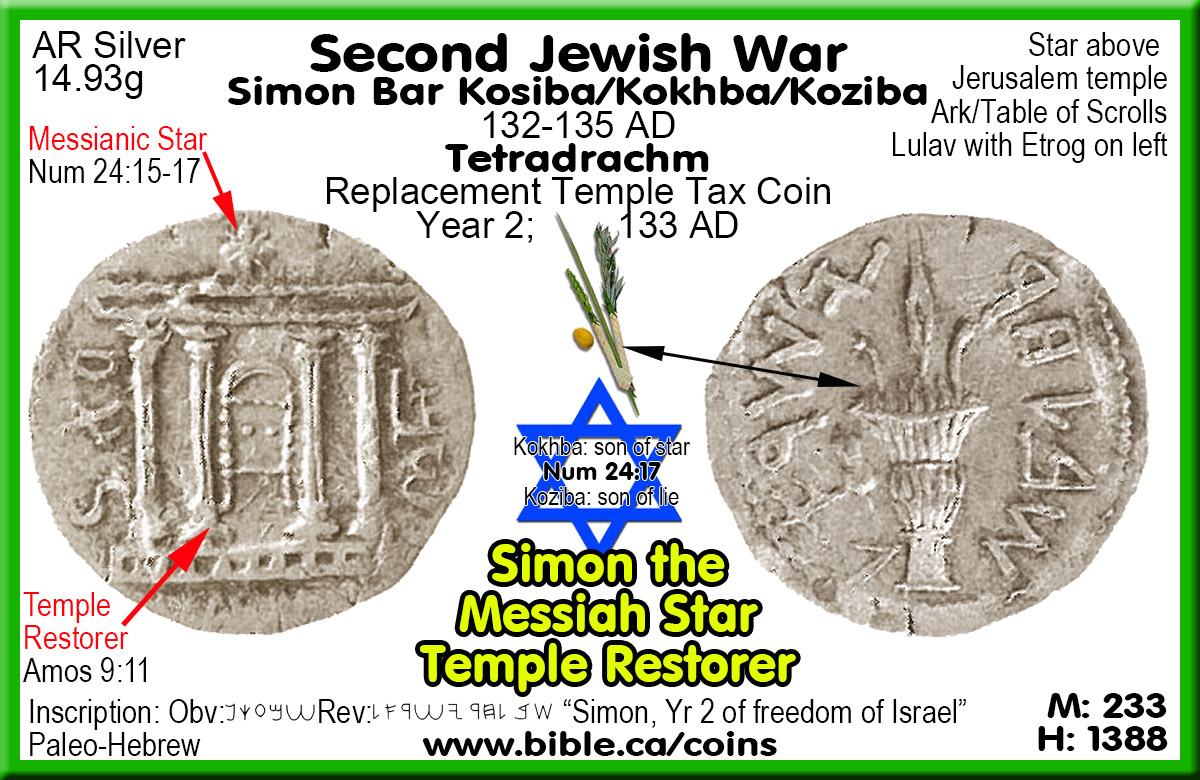
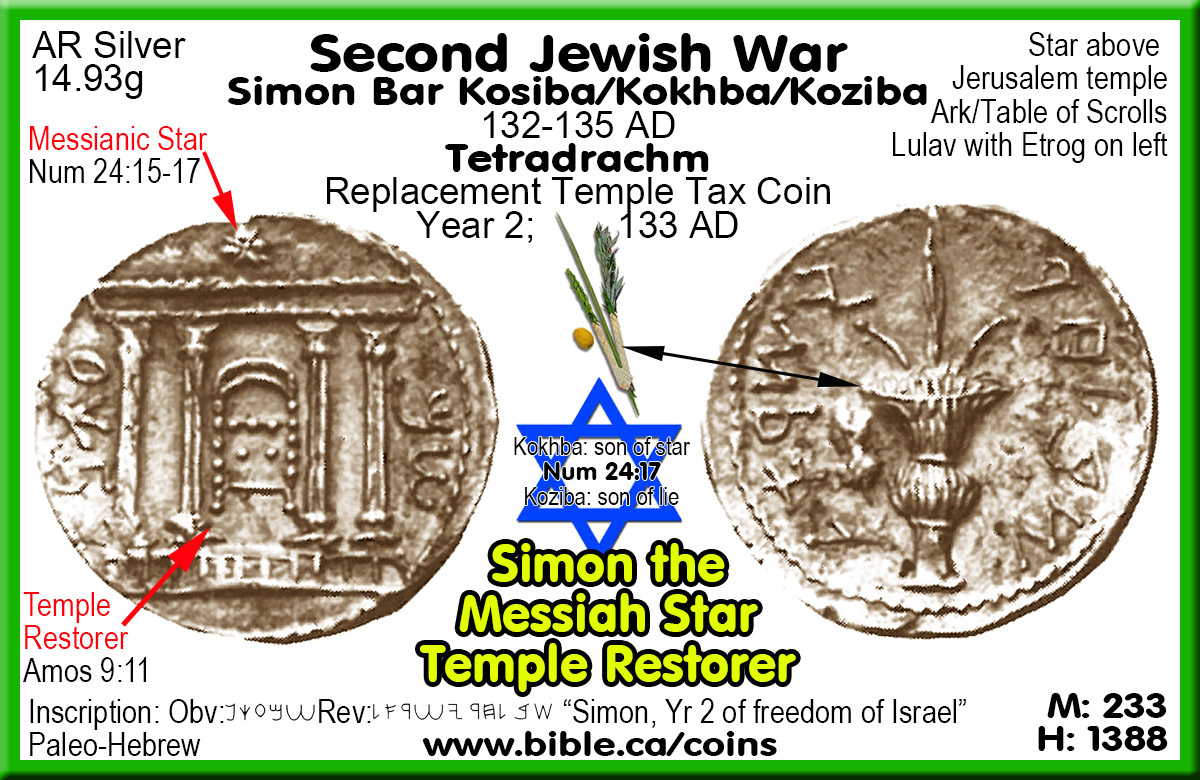
- 2nd Jewish war, year two
silver Denarius (also called a “Zuz” by the Jews)
This is the Messianic “Simon with Harp of David” Coin
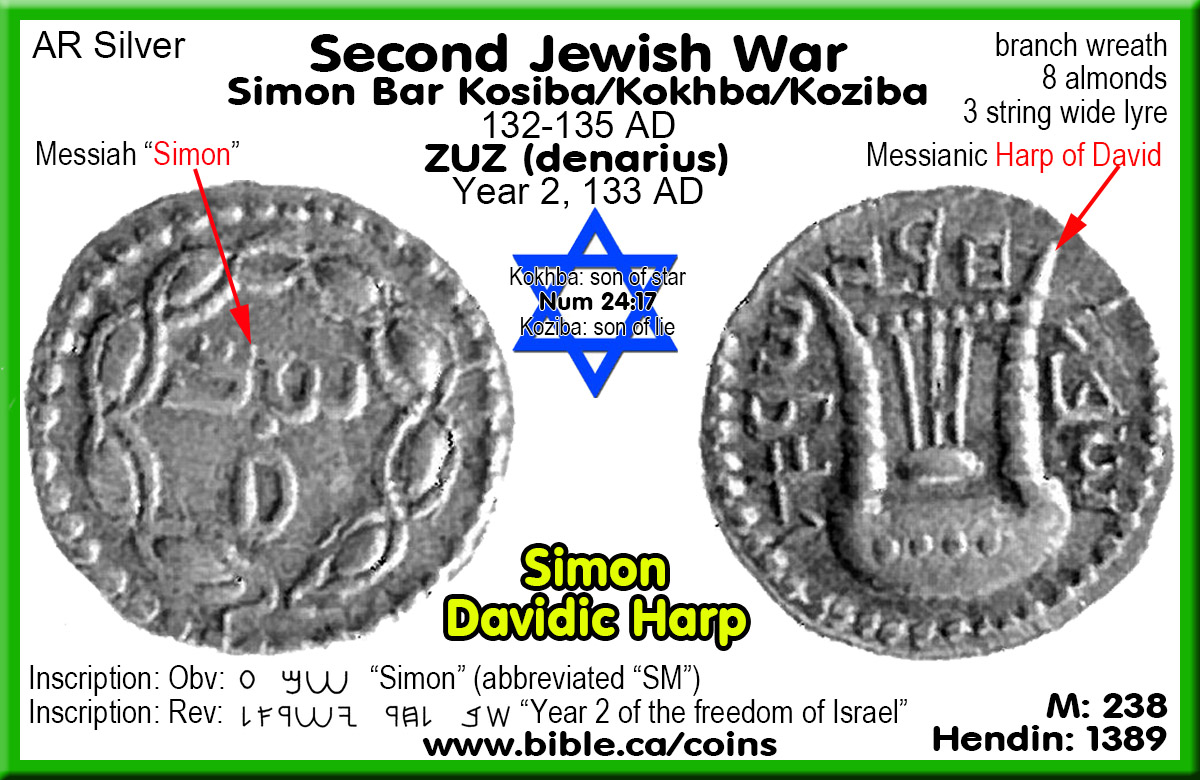
- 2nd Jewish war, year two Denarius
(also called a “Zuz” by the Jews)
This is the “Dual Messiah” coin: Simon (branch of David) + Ezeazar high priest (Interpreter of the Law)
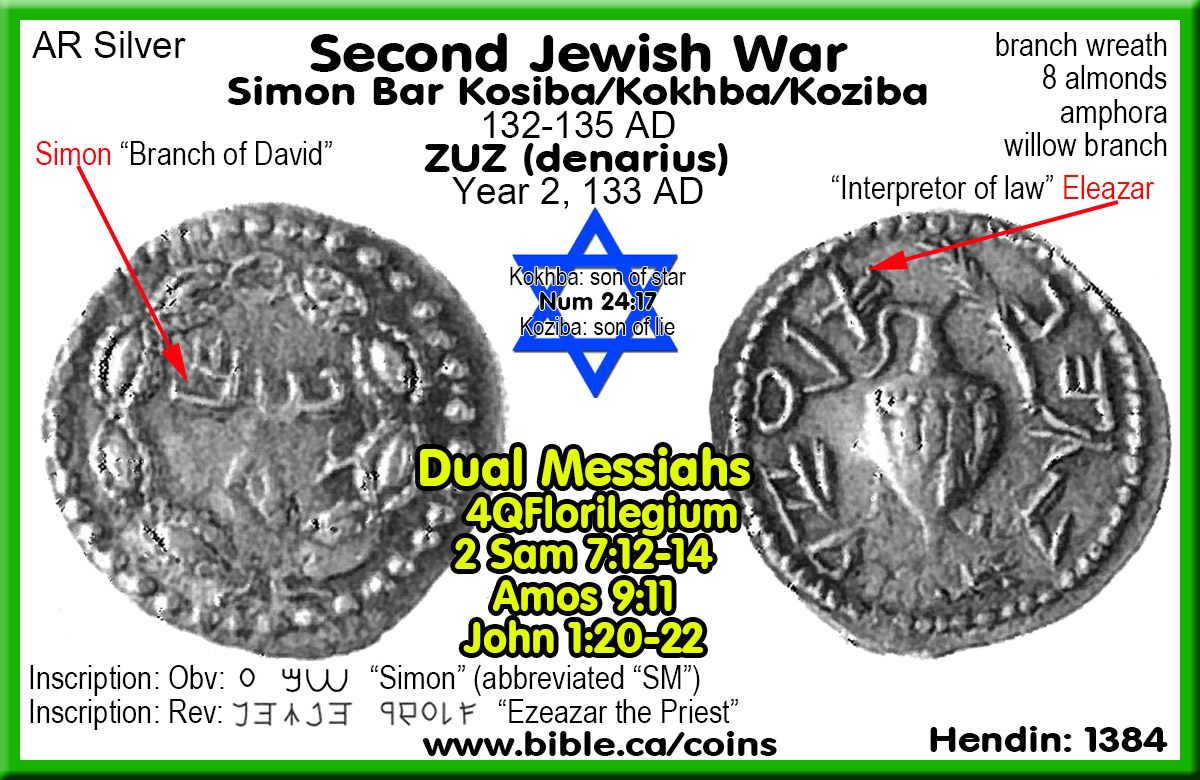
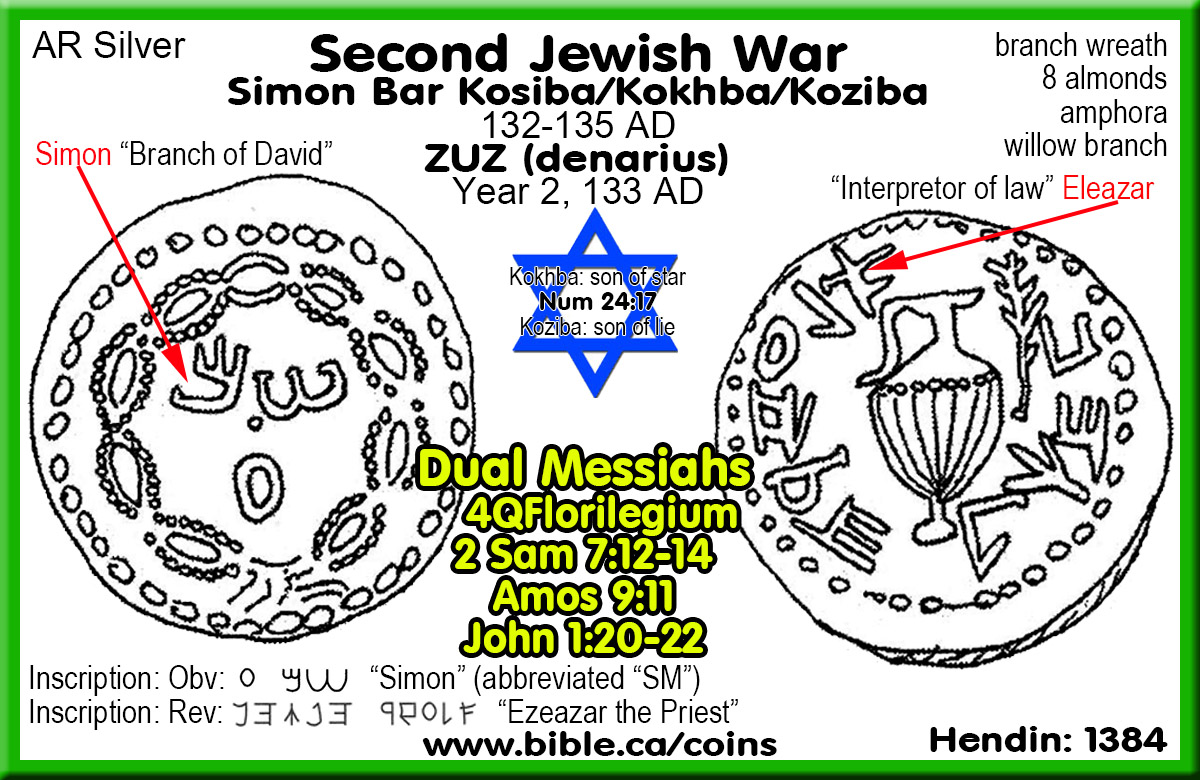
- Year three of second Jewish independence war: Bar Kokhba: 134-5 AD
- Hadrian 135 AD: Holocaust of the Jews:
- Hadrian pictured on a
statue killing a Jew:
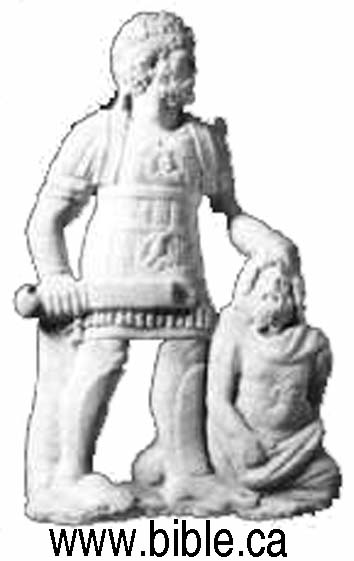
- Roman historian Cassius Dio recorded the war in 229 AD:
- “At Jerusalem he founded a city in place of the one which had been razed to the ground, naming it Aelia Capitolina, and on the site of the temple of the god he raised a new temple to Jupiter. This brought on a war of no slight importance nor of brief duration, for the Jews deemed it intolerable that foreign races should be settled in their city and foreign religious rites planted there. … At first the Romans took no account of them. Soon, however, all Judaea had been stirred up, and the Jews everywhere were showing signs of disturbance, were gathering together, and giving evidence of great hostility to the Romans, partly by secret and partly by overt acts; many outside nations, too, were joining them through eagerness for gain, and the whole earth, one might almost say, was being stirred up over the matter. Then, indeed, Hadrian sent against them his best generals. First of these was Julius Severus, who was dispatched from Britain, where he was governor, against the Jews. Severus did not venture to attack his opponents in the open at any one point, in view of their numbers and their desperation, but by intercepting small groups, thanks to the number of his soldiers and his under-officers, and by depriving them of food and shutting them up, he was able, rather slowly, to be sure, but with comparatively little danger, to crush, exhaust and exterminate them. Very few of them in fact survived. Fifty of their most important outposts and nine hundred and eighty-five of their most famous villages were razed to the ground. Five hundred and eighty thousand men were slain in the various raids and battles, and the number of those that perished by famine, disease and fire was past finding out. Thus nearly the whole of Judaea was made desolate, a result of which the people had had forewarning before the war. For the tomb of Solomon, which the Jews regard as an object of veneration, fell to pieces of itself and collapsed, and many wolves and hyenas rushed howling into their cities.” (Roman History, Cassius Dio, Book 69:12-14, 229 AD)
Conclusion:
1. The brief period of about 60 years of true independence from under the control of the Greek/Seleucid empire came to an end with the Romans and Herod the Great.
a. Herod would build the Jews a temple in 18 months completed in 18 AD.
b. Jesus would be born in 2-1 BC and Herod would die in 1 BC.
c. The Roman empire would control the Jews up until the first Jewish war of 66 AD.
d. This rebellion resulted in the Romans coming down with a heavy hand and they easily crushed the rebellion and forever destroyed the temple in 70 AD.
e. A new temple had been raised from the dust, just as Jesus said: His body, THE CHURCH.
f. Jesus said the kingdom of God and the temple is not physical but within each of us!
2. The Greek kingdom existed from 333 - 31 BC
a. Alexander the Great lived only ten years and ruled the world as a sole monarch from 333-323 BC
b. The early Greek/Macedonian period is 333 - 302 BC as far as classifying coins is concerned.
c. After Alexander the Great died, his kingdom was split into four Kingdoms: (Four "horns" empires after Alexander the Great)
d. Ptolemy Empire (323-31 BC)
e. Seleucid Empire (321-64 BC)
f. Cassander (319-168 BC) We do not discuss this kingdom at all because it is far removed from land of Judah.
g. Lysimachus (323-133 BC) We do not discuss this kingdom at all because it is far removed from land of Judah.
h. For a short time during the Greek Empire period, the Jews gained true independence under the Maccabees (Hasmonean Era): 166-37 BC
3. Rome conquered all by 31 BC and the fourth and final kingdom of Daniel's prophecy (Dan 2) came into existence.
4. The first Jewish war (66-70 AD) triggered the destruction of Jerusalem in 70 AD
5. The second Jewish war (132-135 AD) triggered a massive holocaust and destruction of the Jewish people:
- Simon the Messiah misinterpreted Hadrian’s building of a temple of Jupiter on the former site of the Jewish temple, as the “abomination of desolation” of Daniel’s prophecy.
- Simon was widely viewed by all the surviving Jews to be the Son of the Star prophecy of Num 24:17 and therefor the messiah.
- When Simon was killed he was renamed by the Jews as the “son of the Lie”.
6. On Pentecost 33 AD, God set up his divine Kingdom which we know today as the Church of Christ which will never come to an end:
a. "For this you know with certainty, that no immoral or impure person or covetous man, who is an idolater, has an inheritance in the kingdom of Christ and God." (Ephesians 5:5)
b. "For He rescued us from the domain of darkness, and transferred us to the kingdom of His beloved Son, in whom we have redemption, the forgiveness of sins." (Colossians 1:13–14)
- Messianic symbols were used by Simon Bar Kokhba because he actually claimed to be the messiah.
- Simon’s nickname before defeat by Hadrian in 135 AD was “Son of the Star”.
- After Simon’s defeat, the Jews felt the same feeling as the followers of date setters like Jehovah’s Witnesses or Harold Camping after the world did not end, and renamed him “son of the Lie”.
- Simon’s coin demonstrates the widely believed misconception that the messianic prophecies indicated TWO messiah’s would arise: 1. The Star warrior king branch of David. 2. The interpreter of the Law. (High priest). This misconception is witnessed in the Dead Sea Scrolls and the interrogation of John the Baptist. In fact, Jesus Christ summed up ALL messianic prophecy in himself in the church, His kingdom and Christians his new Israel.
- See full outline on Messianic expectation seen in Dead Sea Scrolls and Jewish coins
- See also Messianic symbols in Bar Kokhba coins
7. Why not attend a local church that follows the pure Bible Blueprint in your own home town! Click here to find one
By Steve Rudd: Contact the author for comments, input or corrections.
